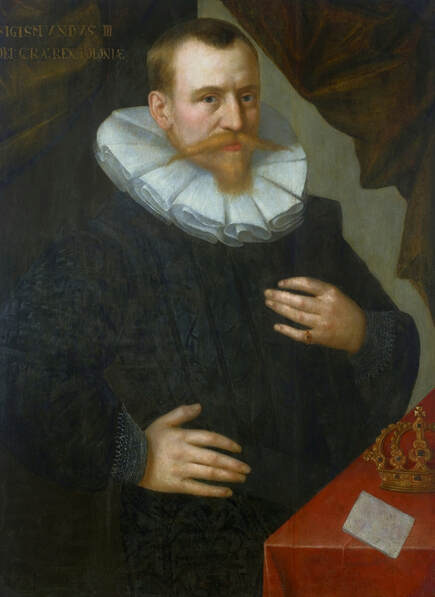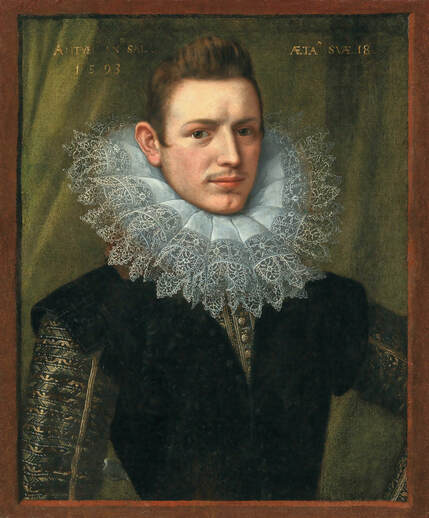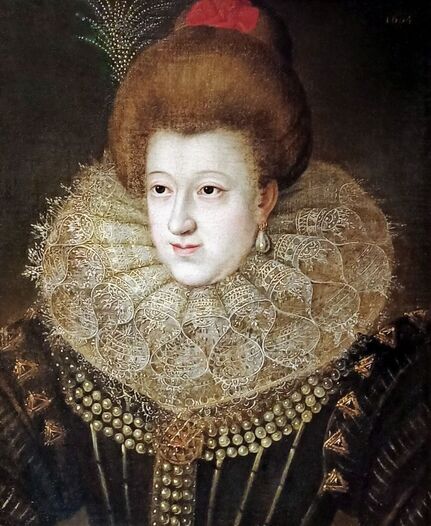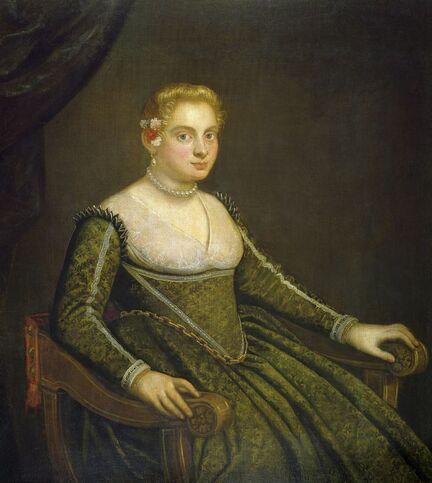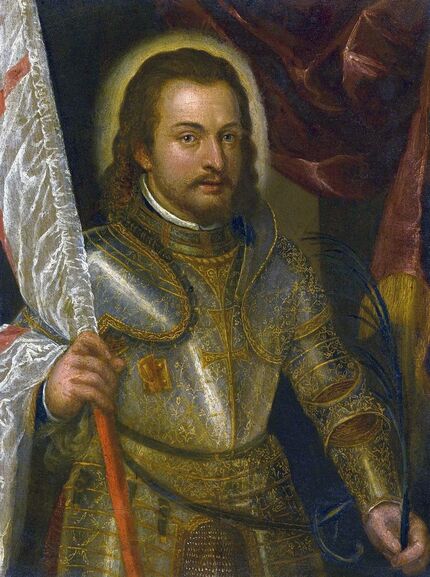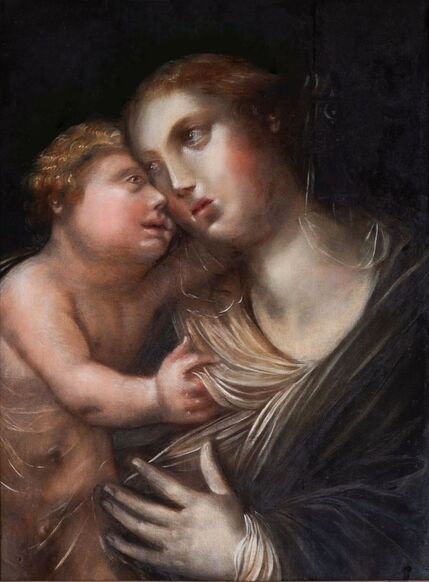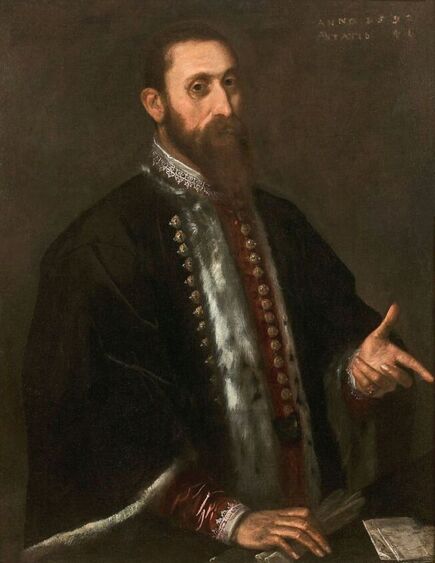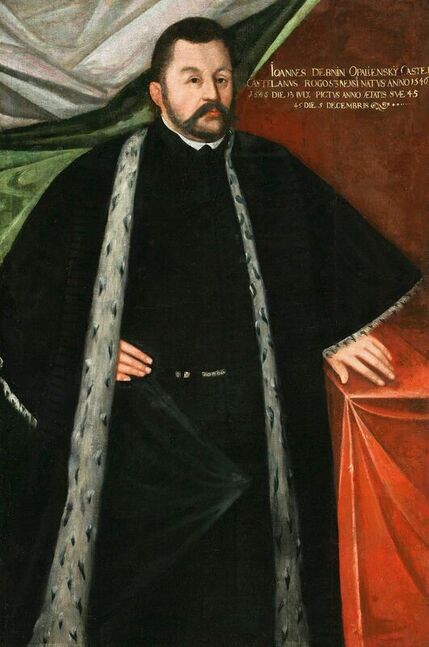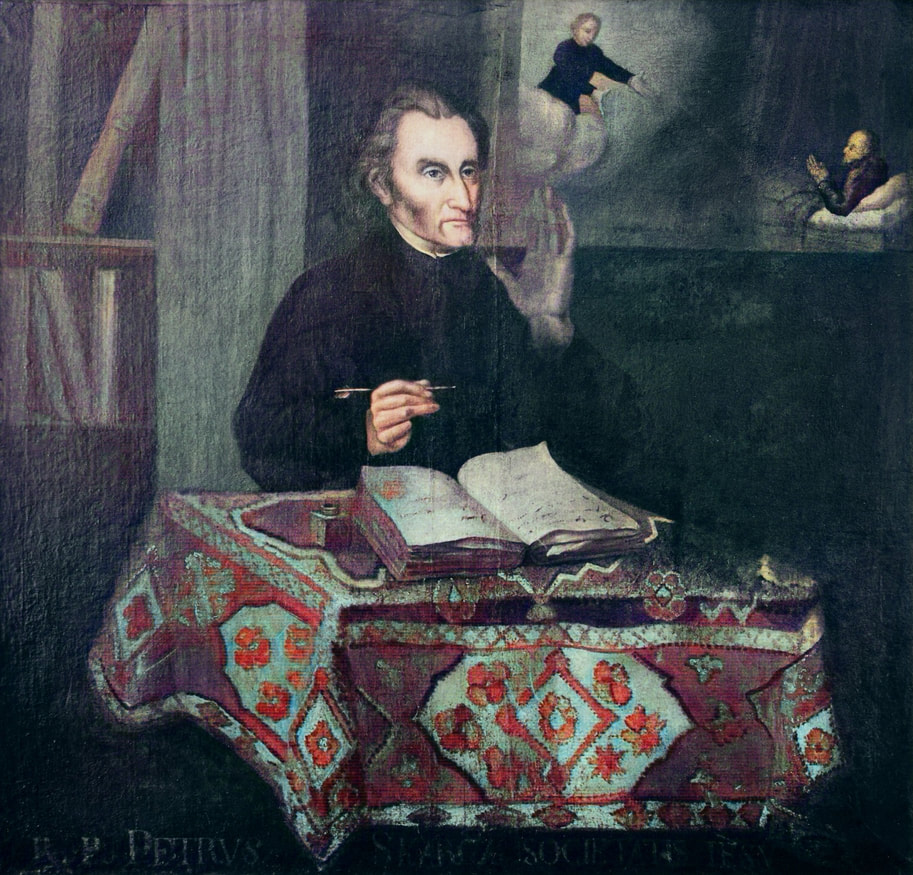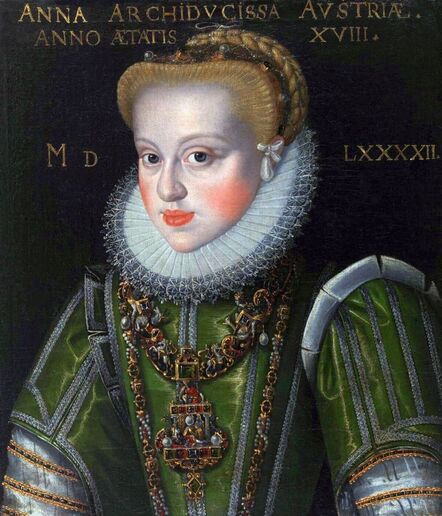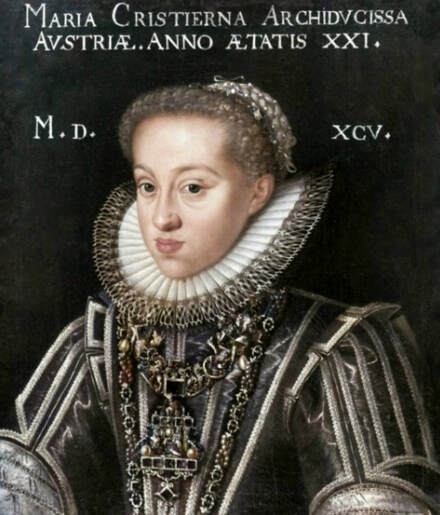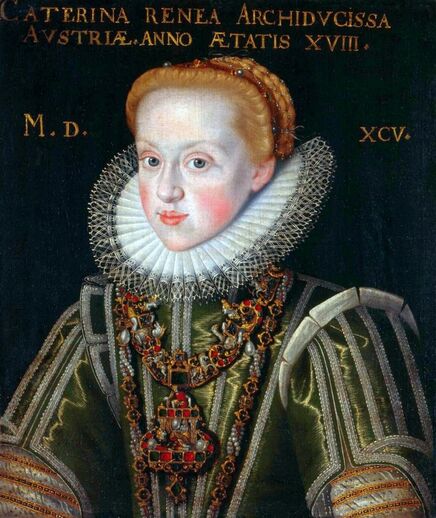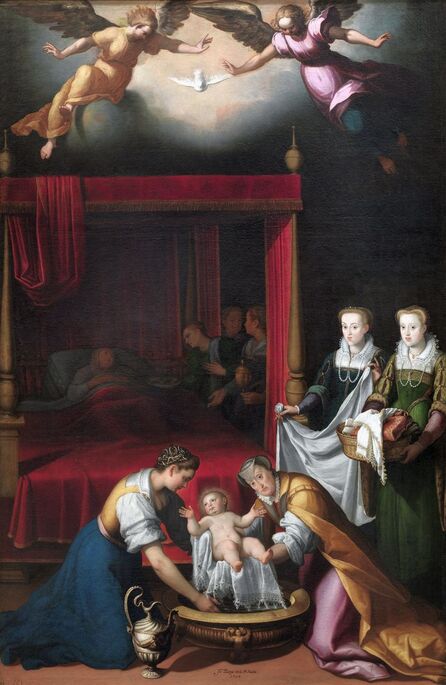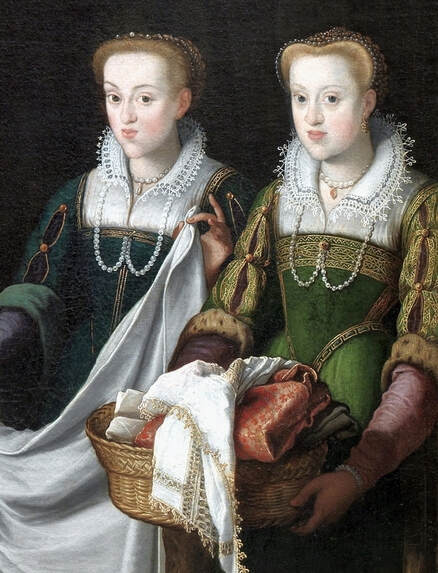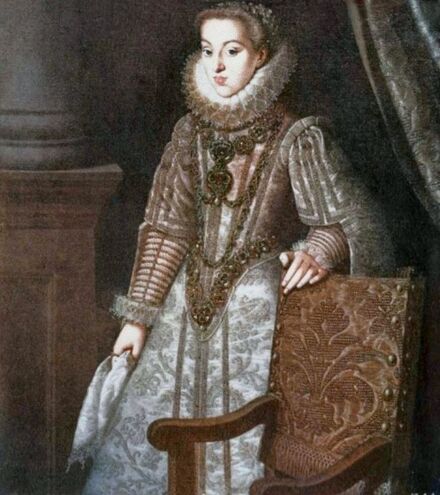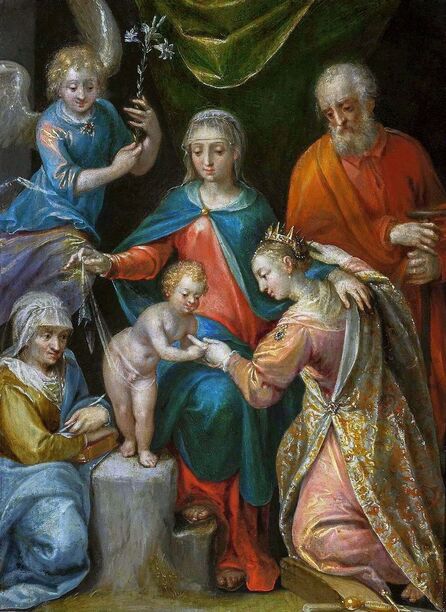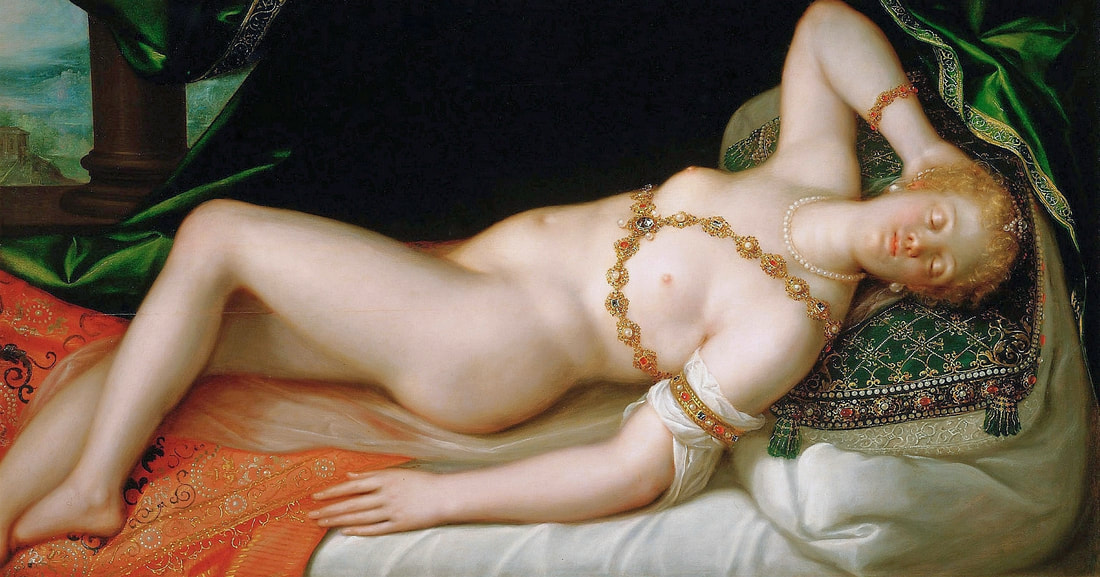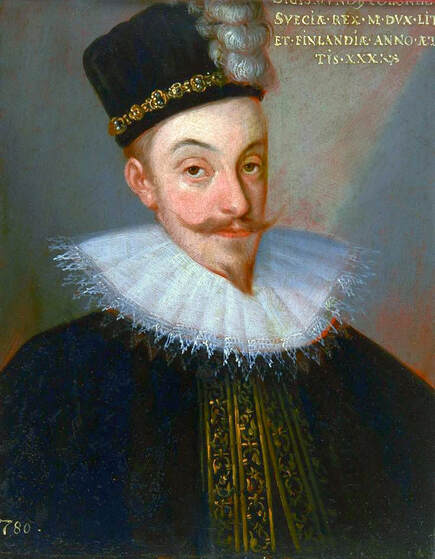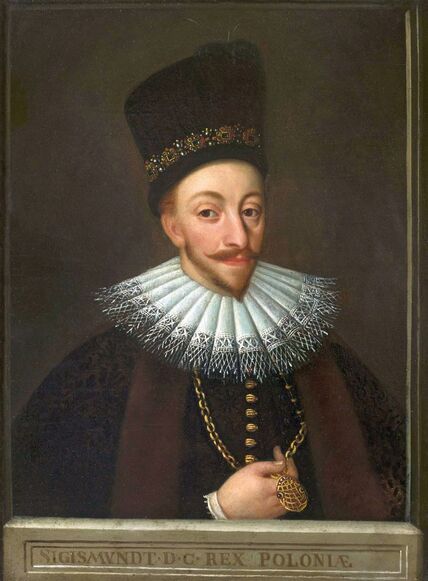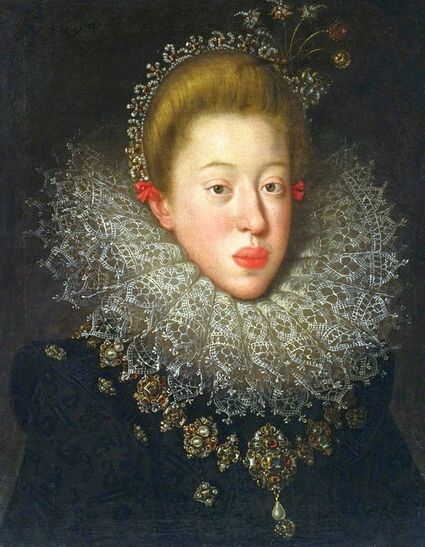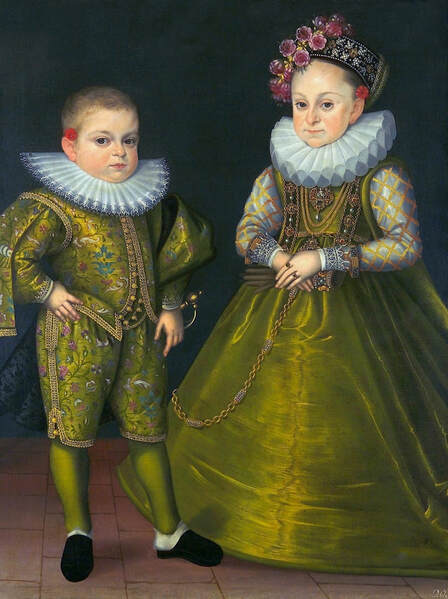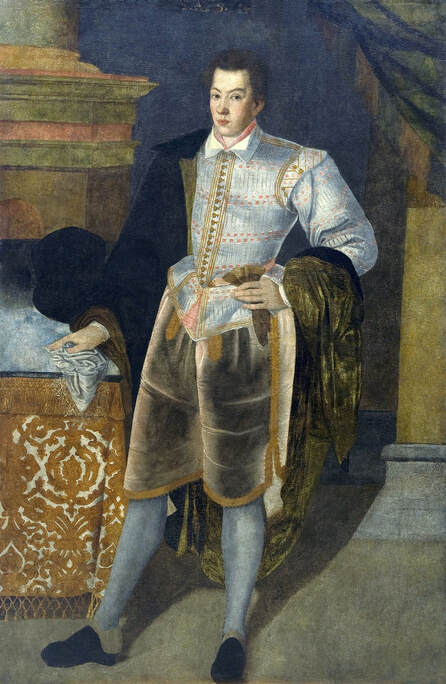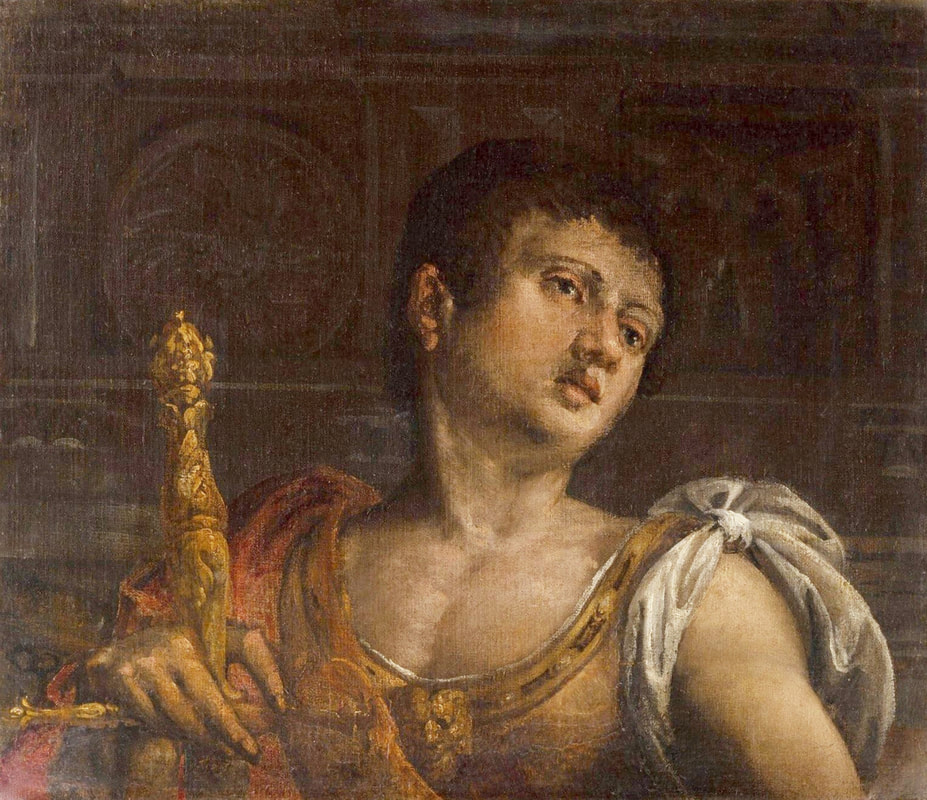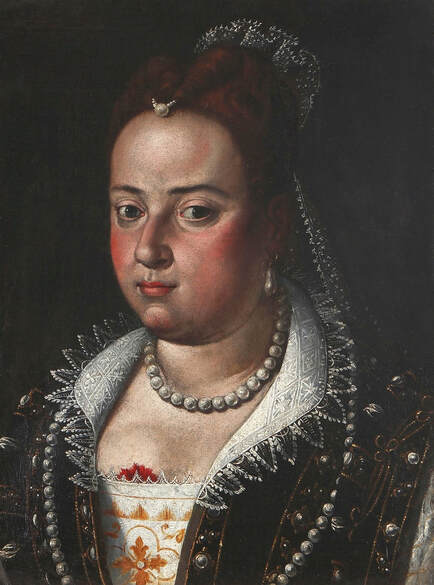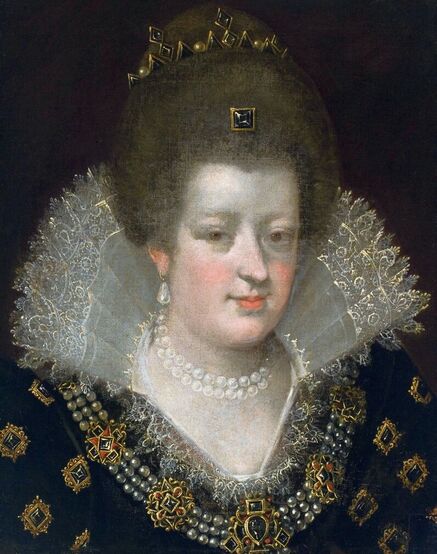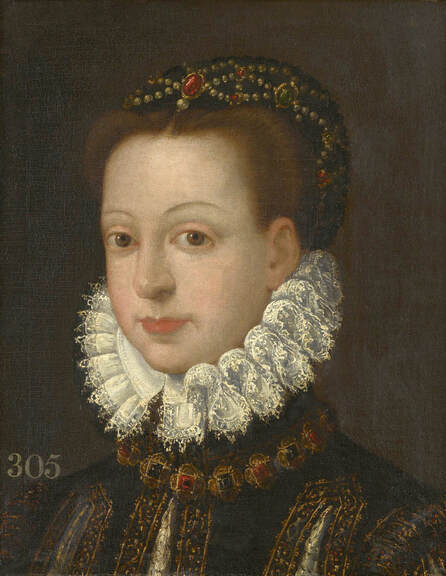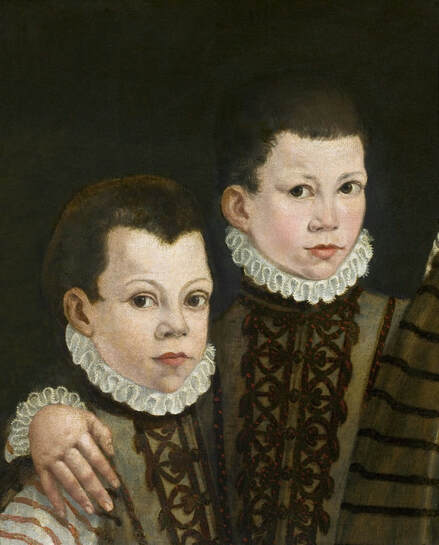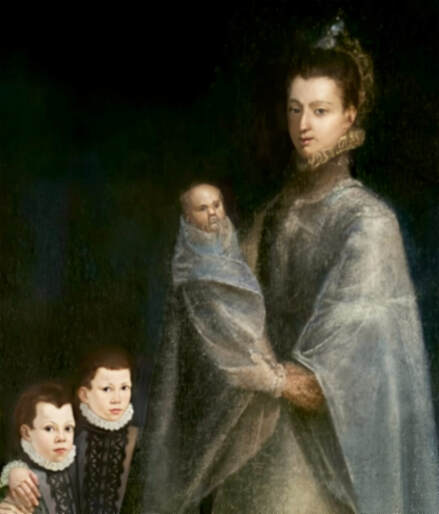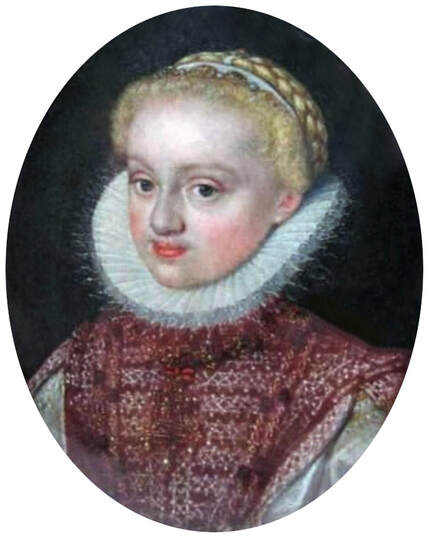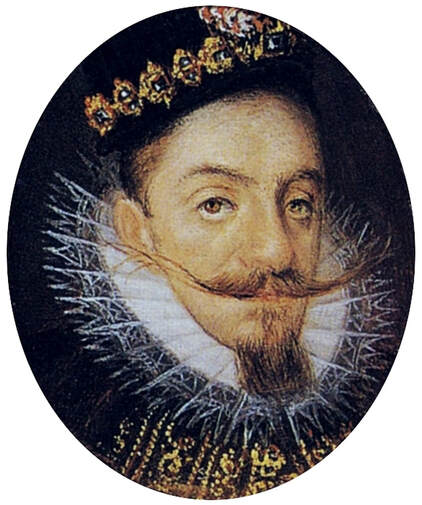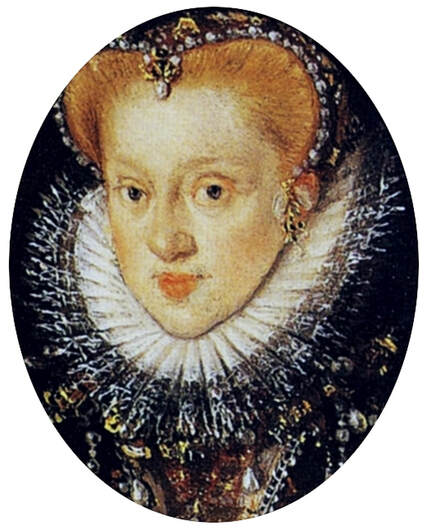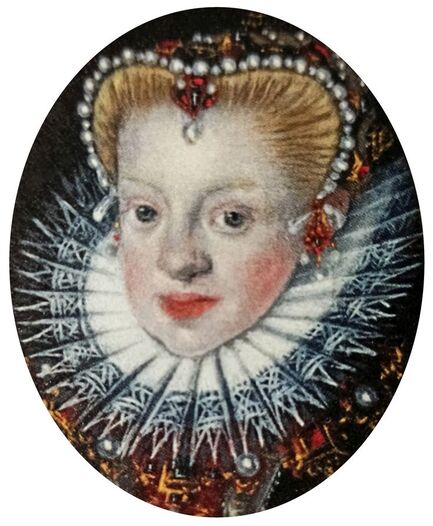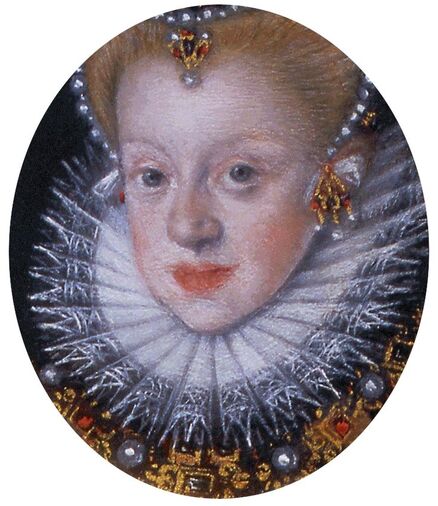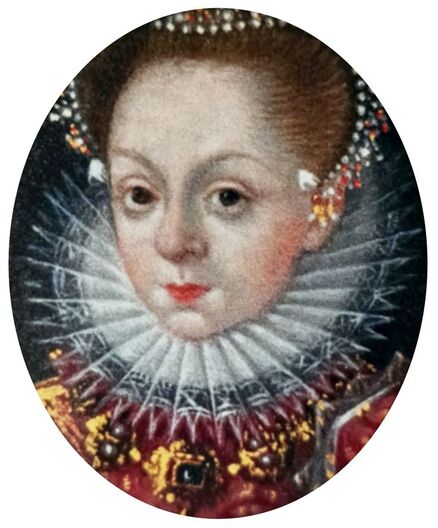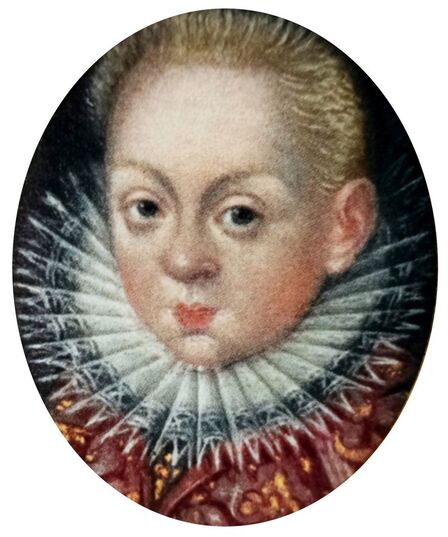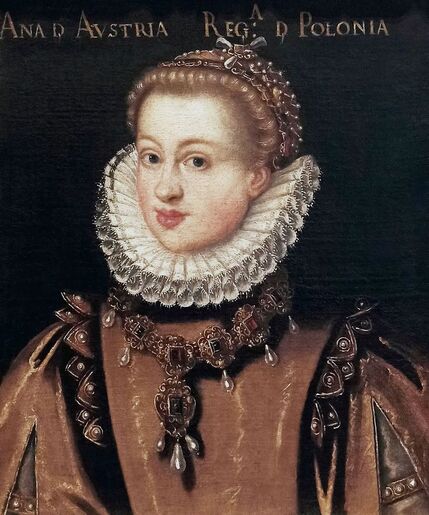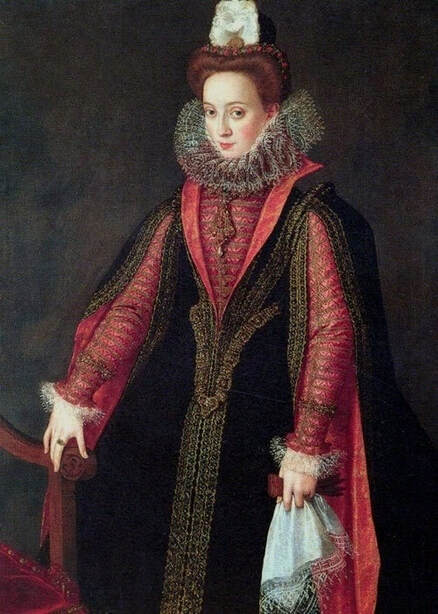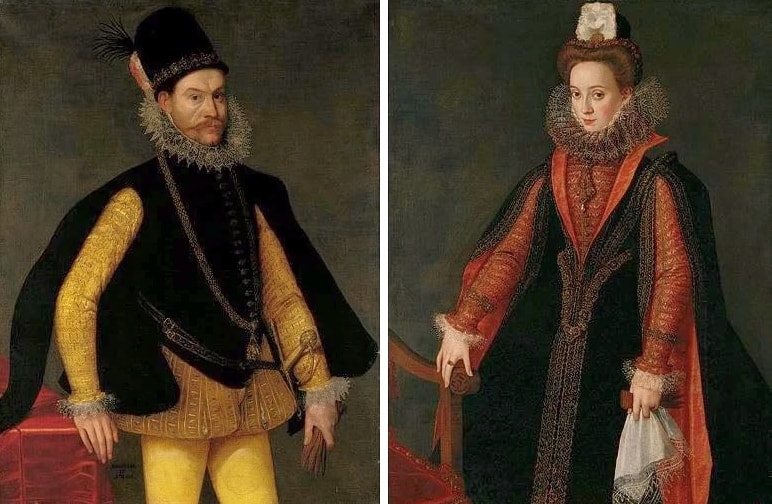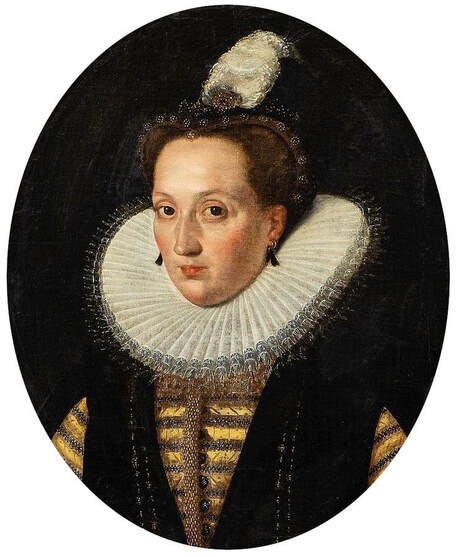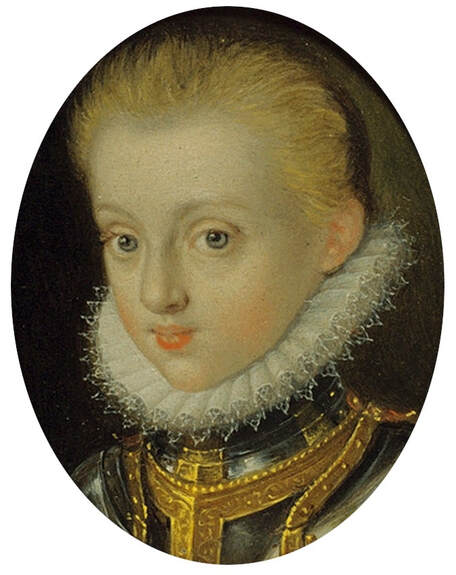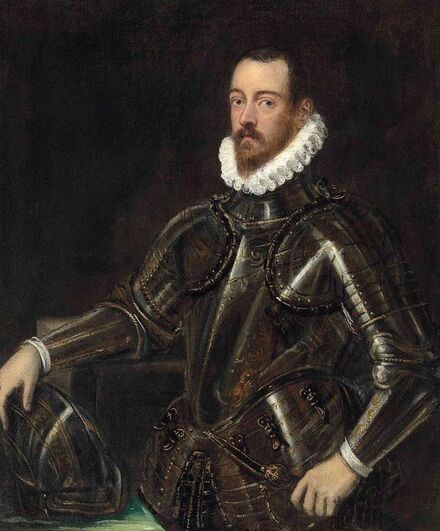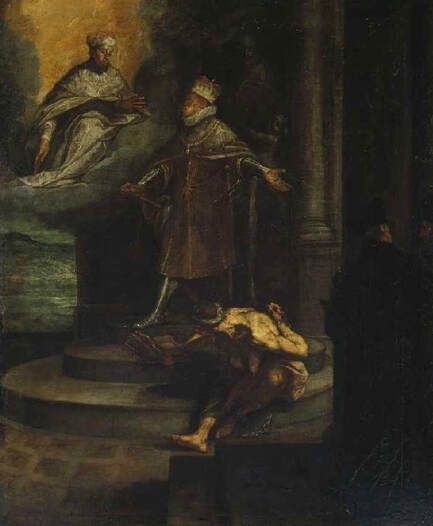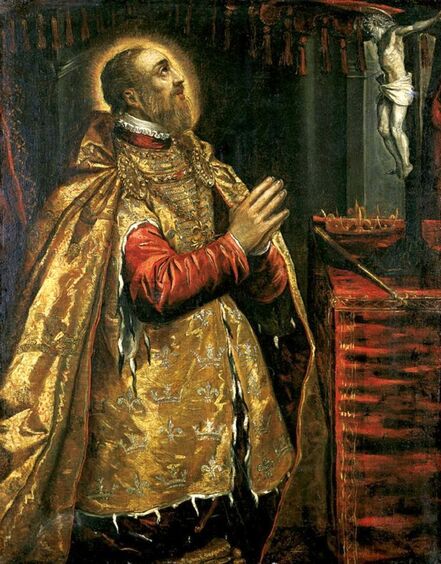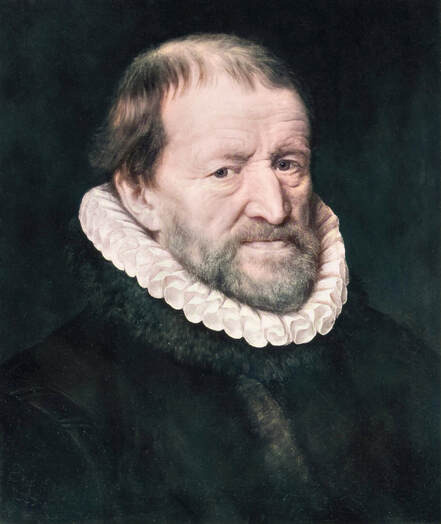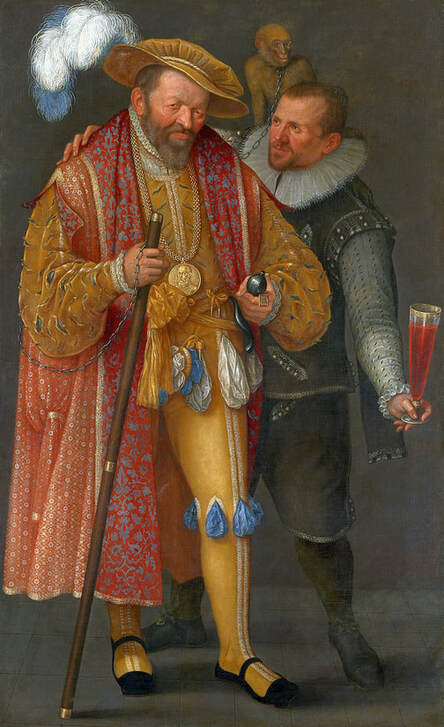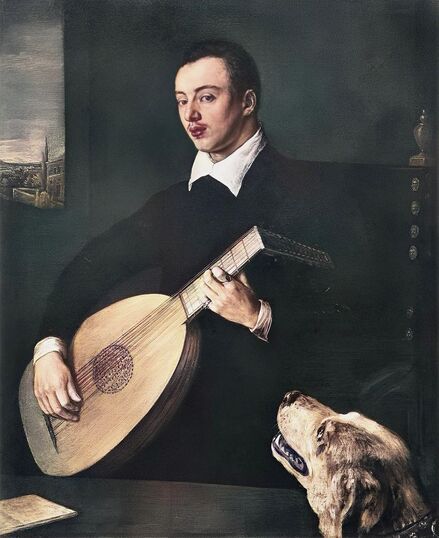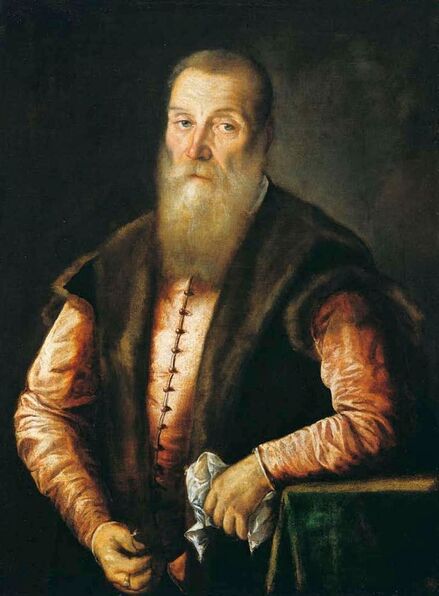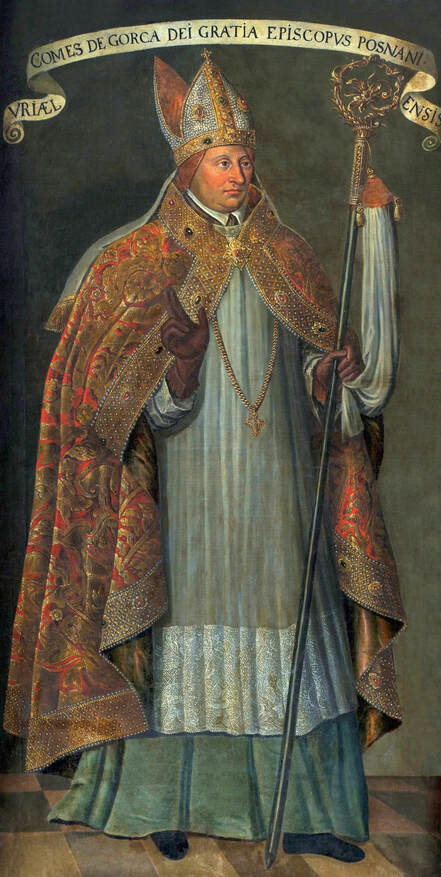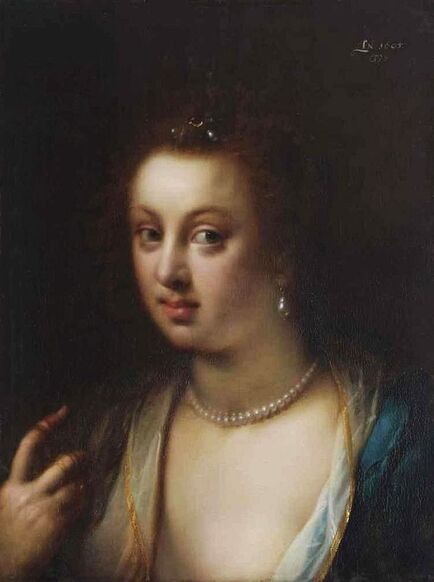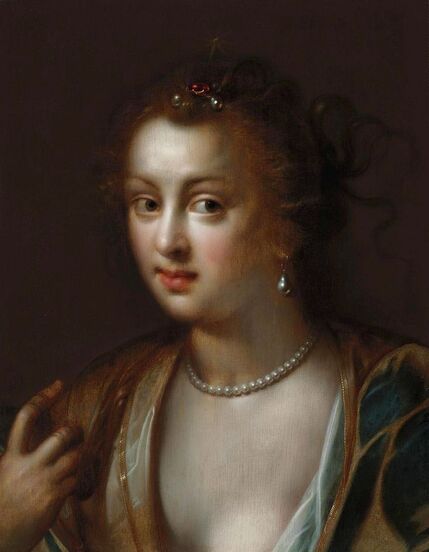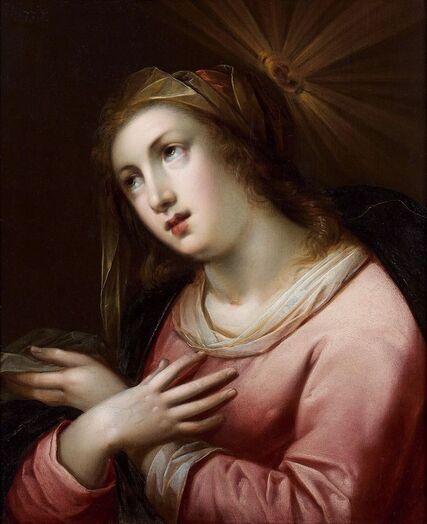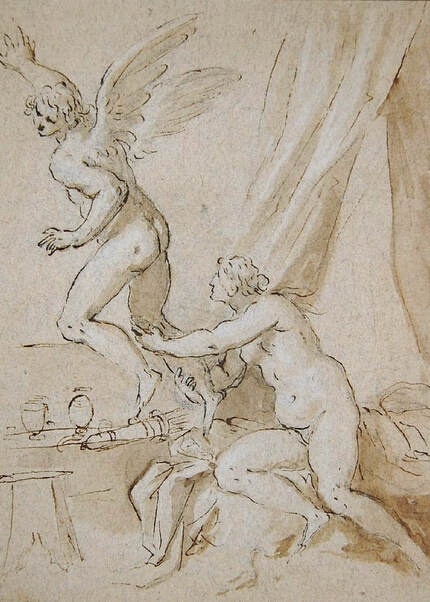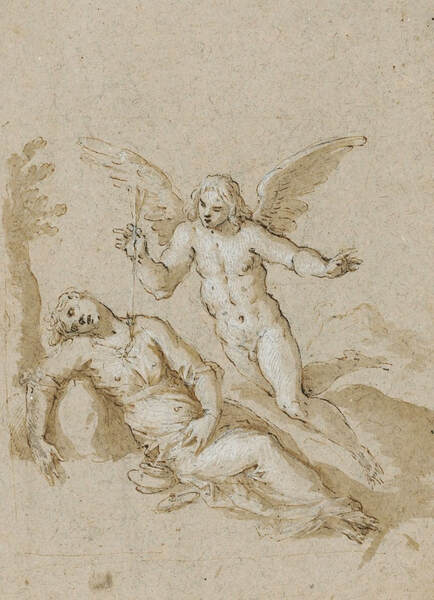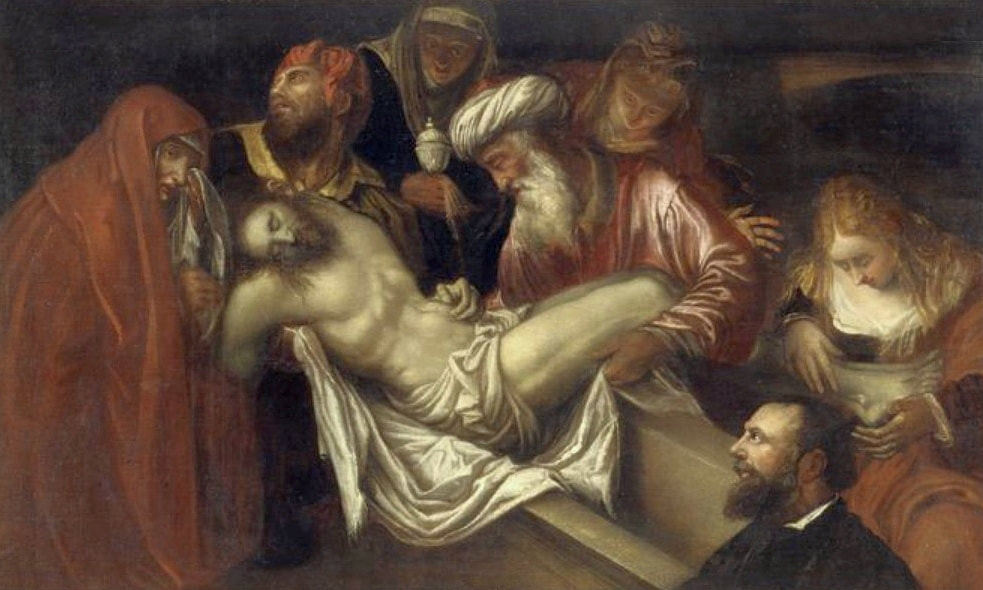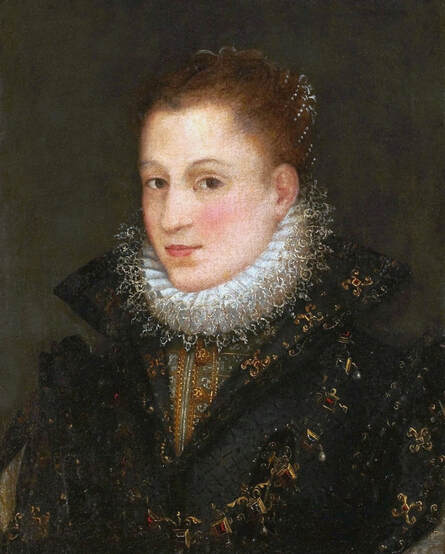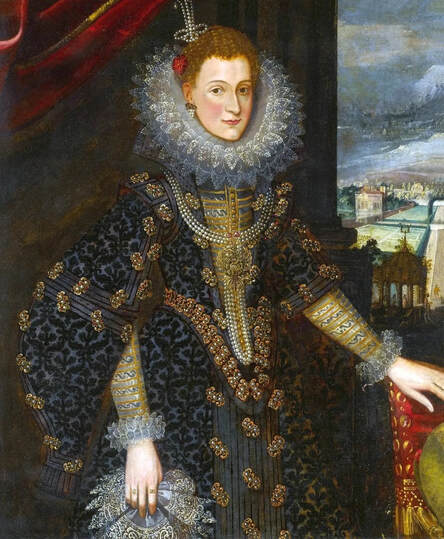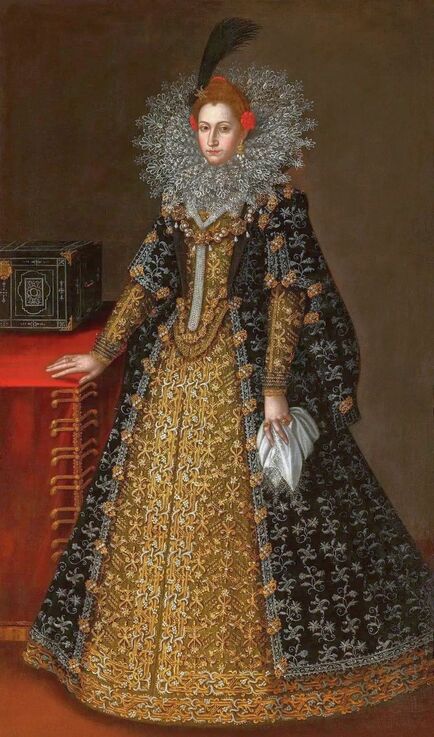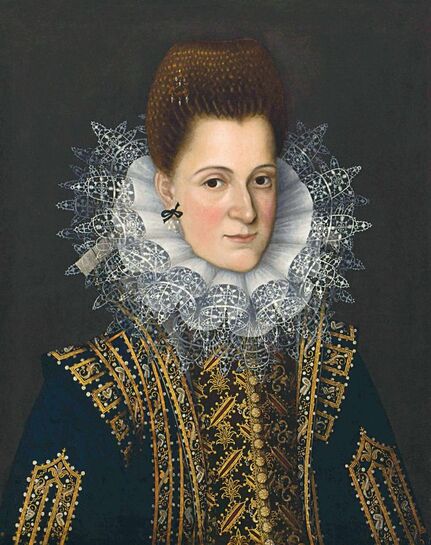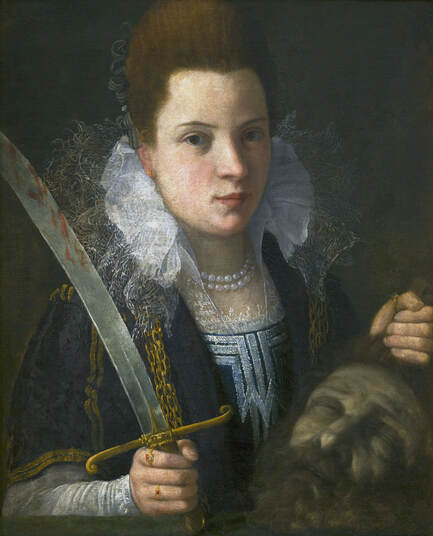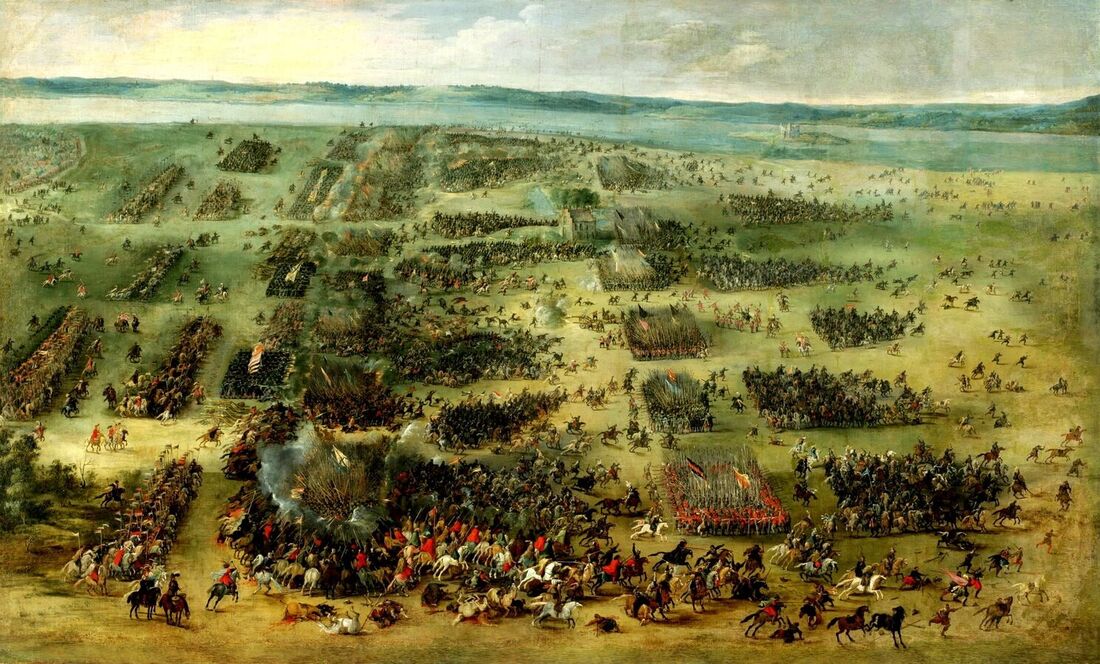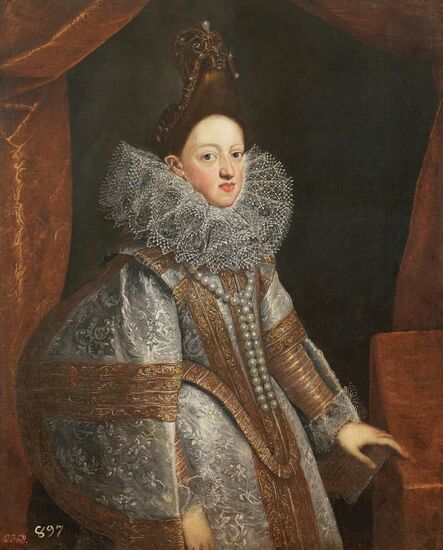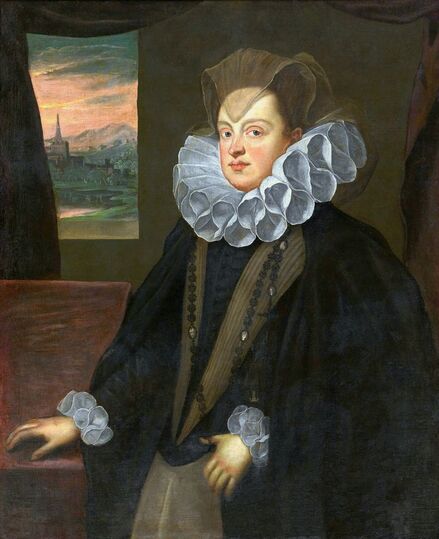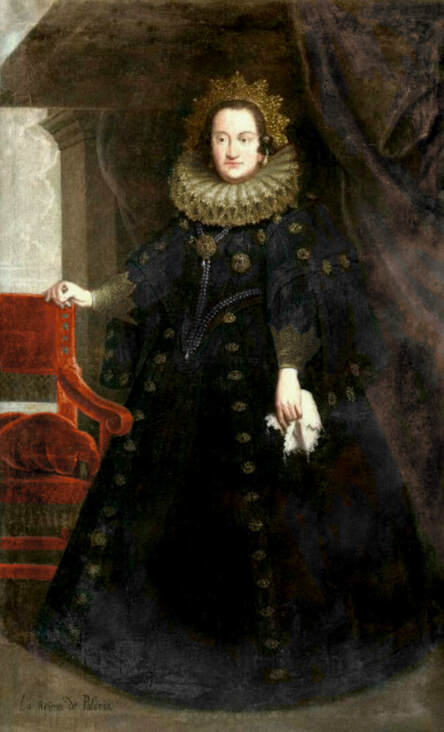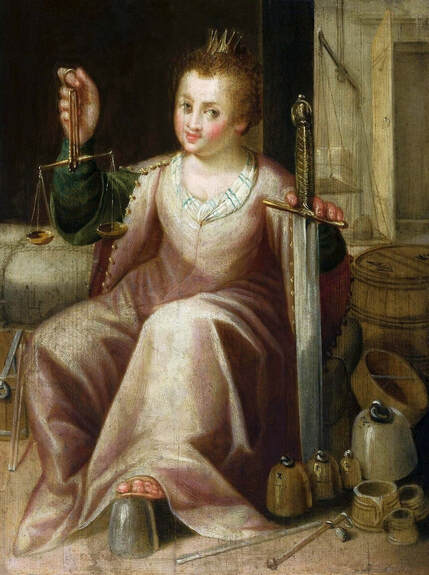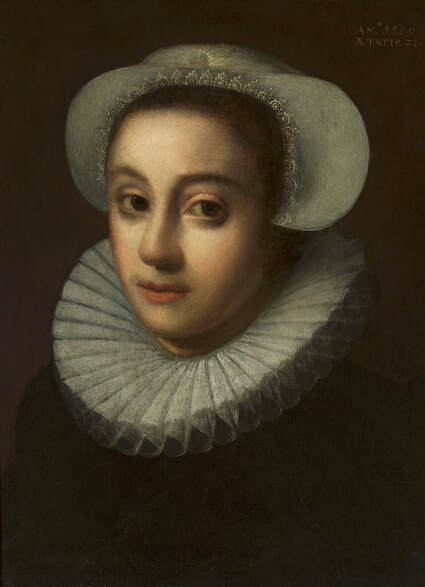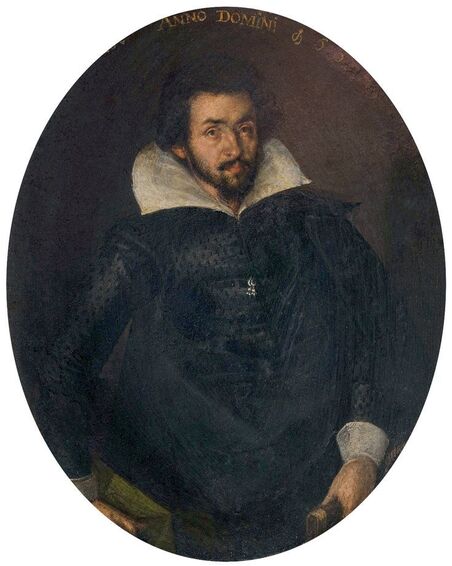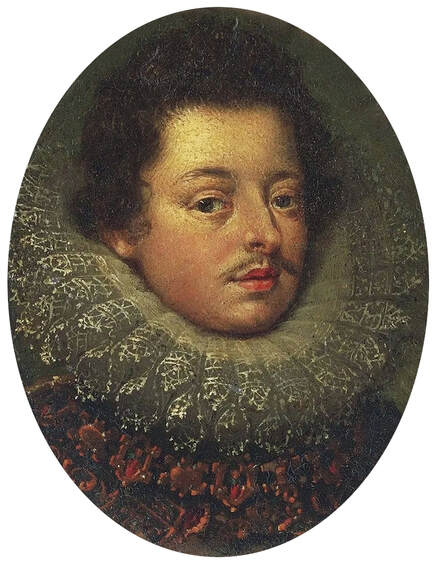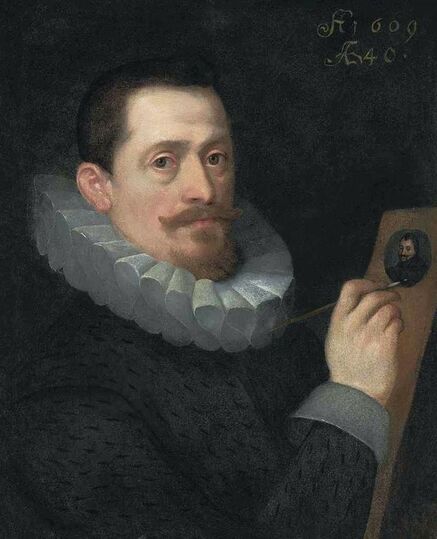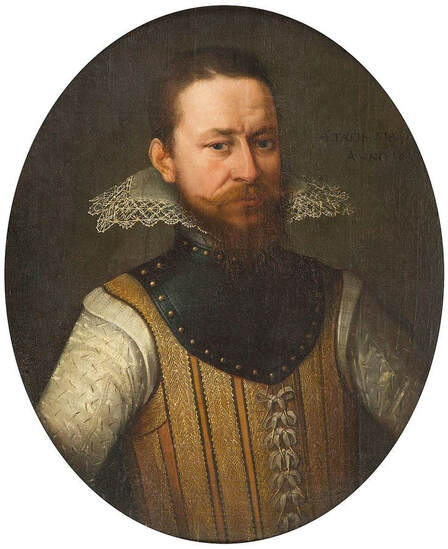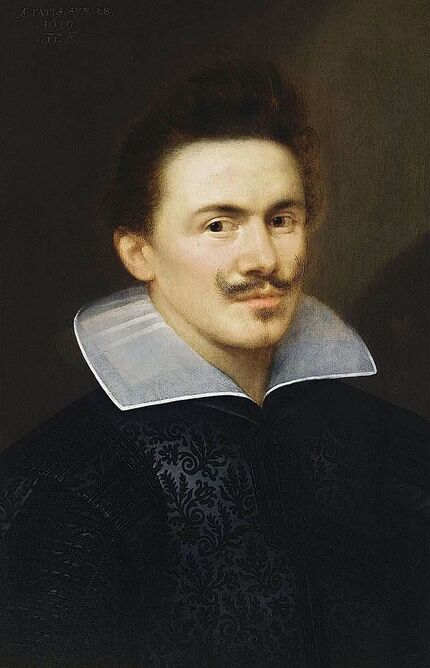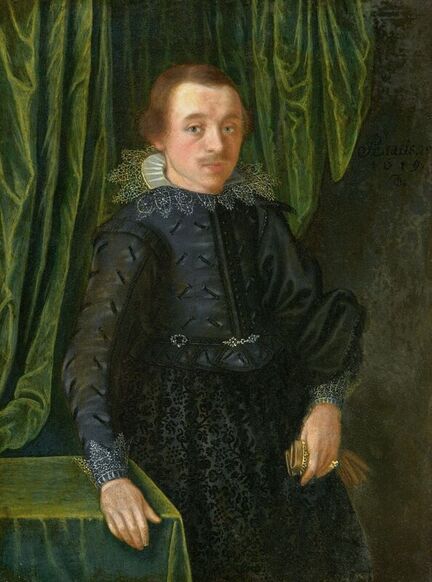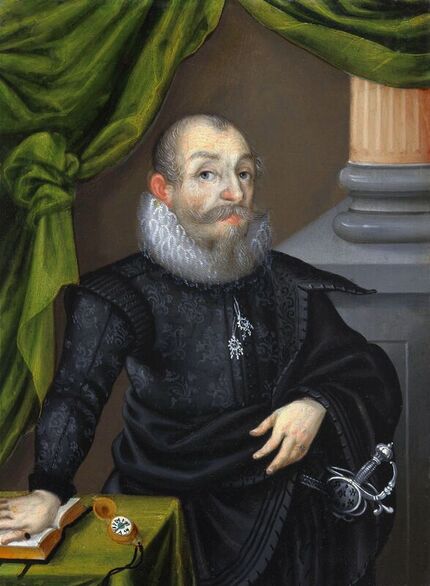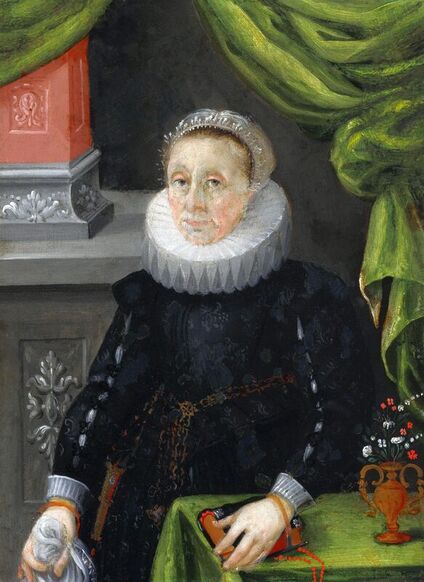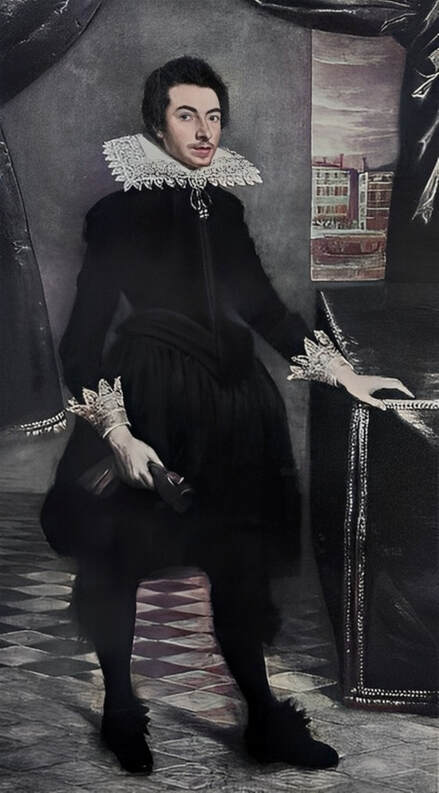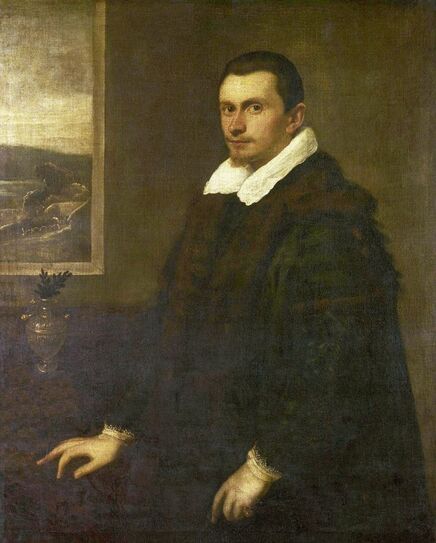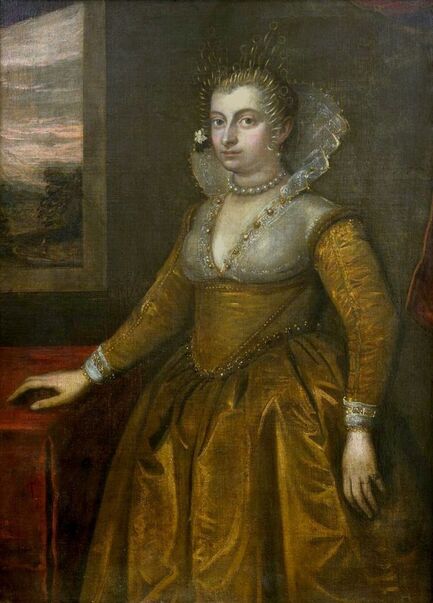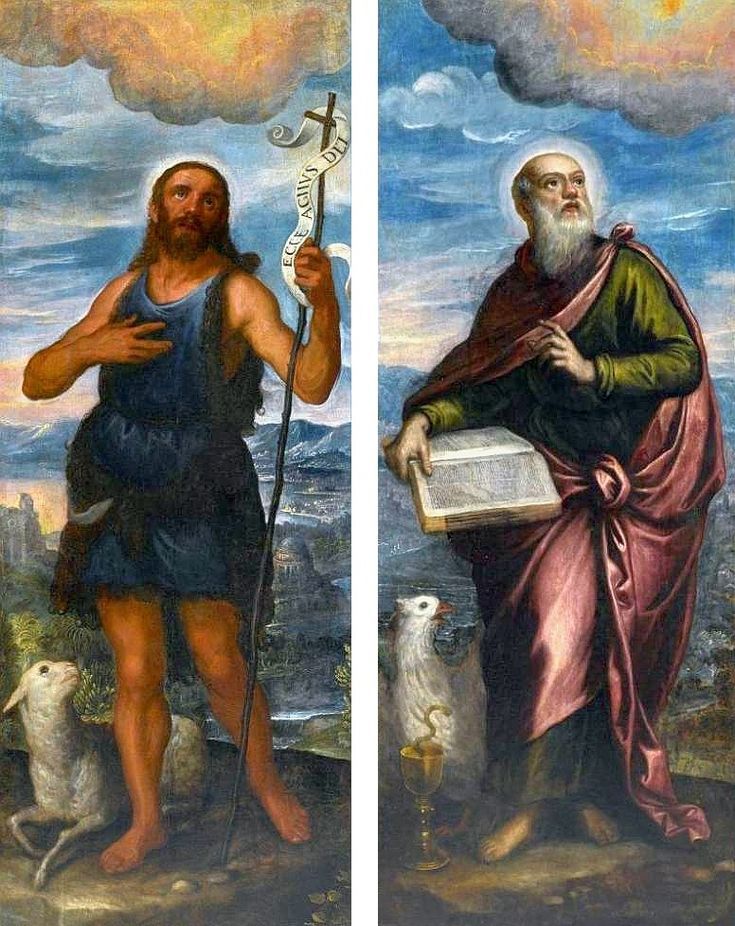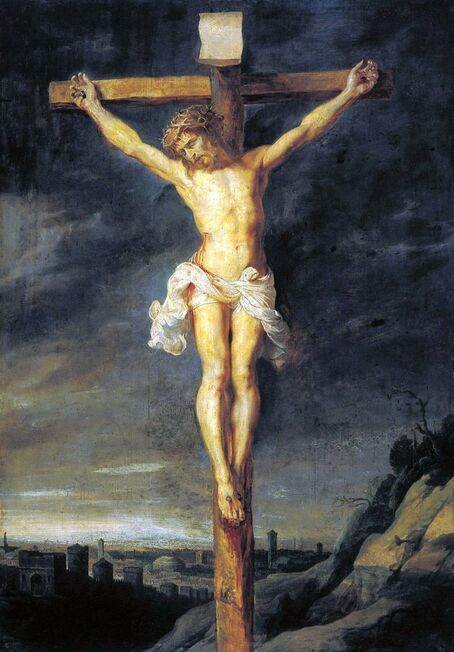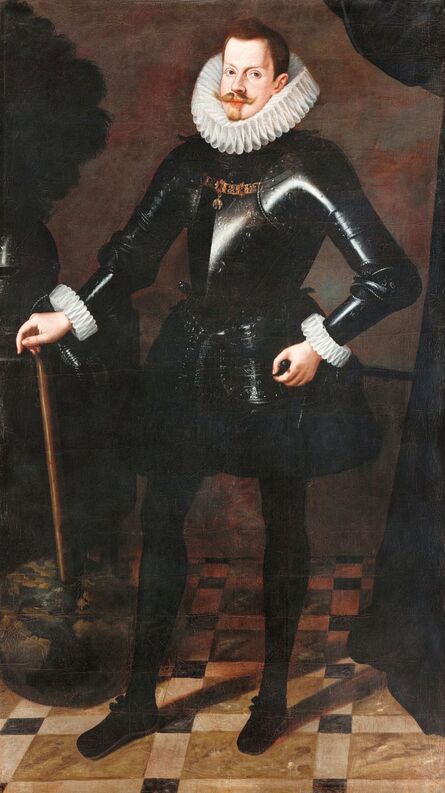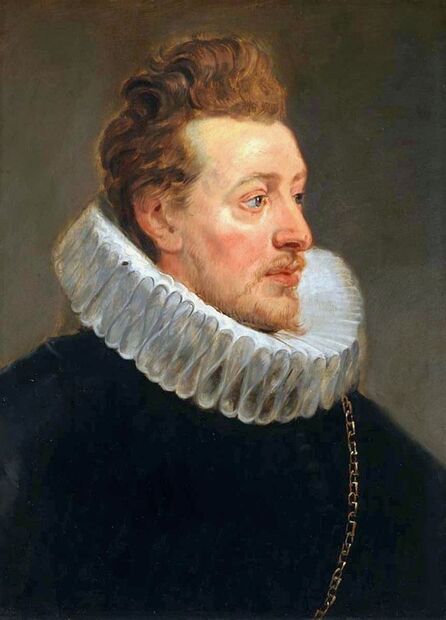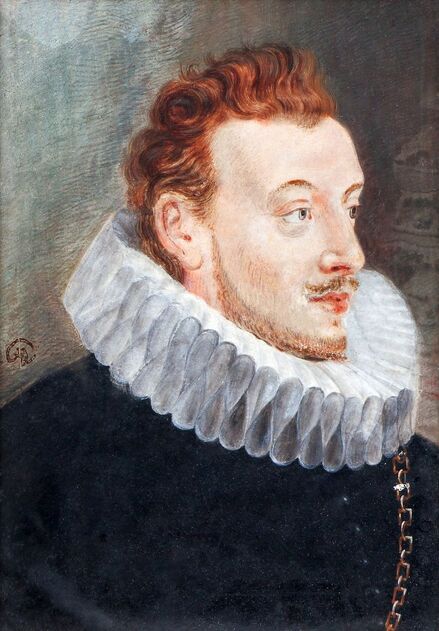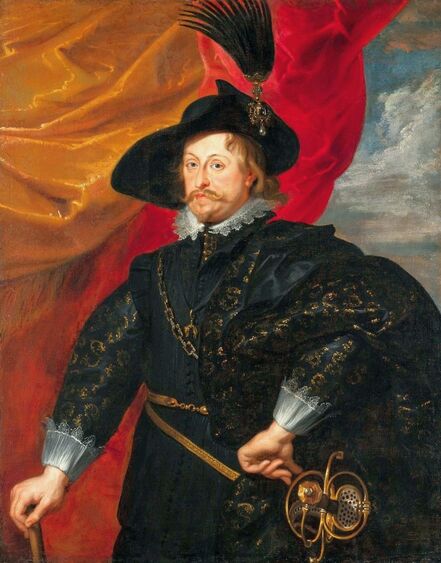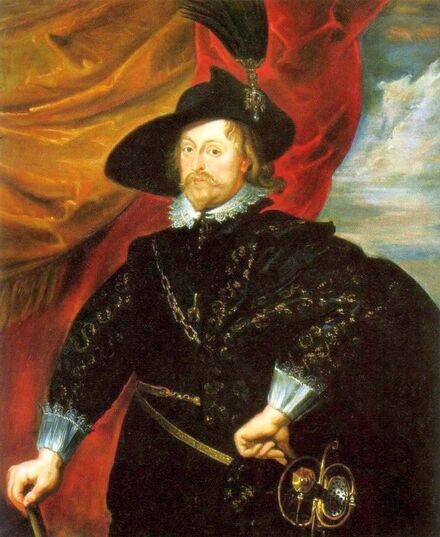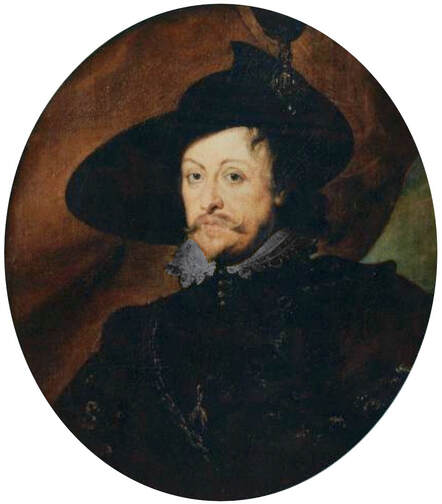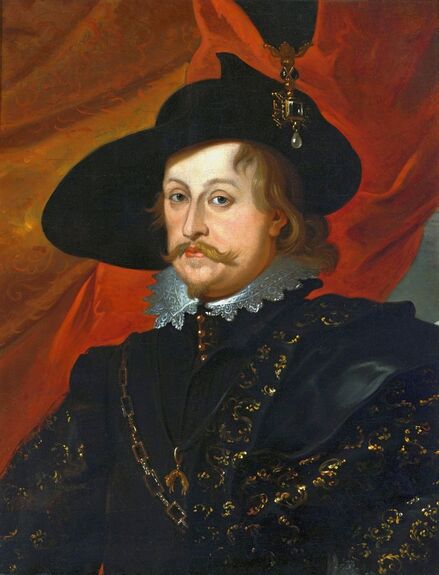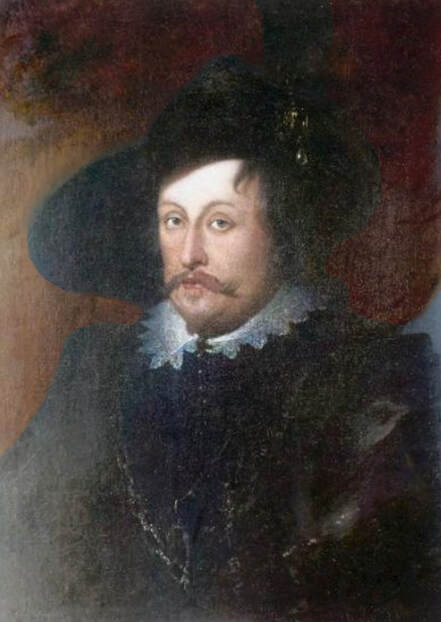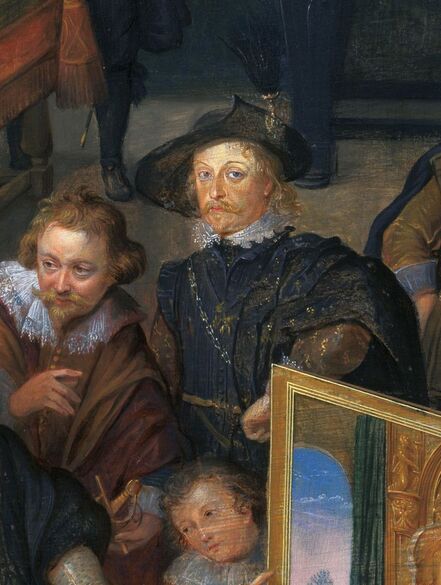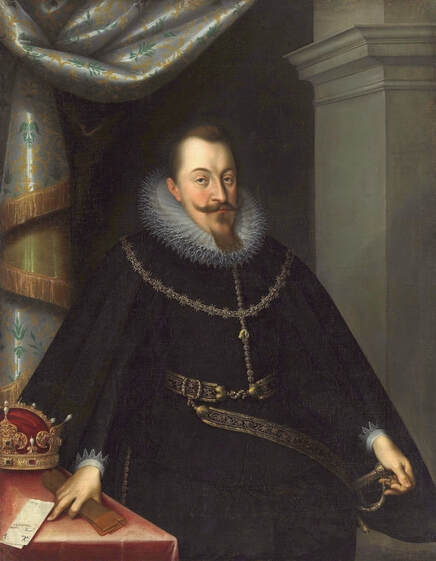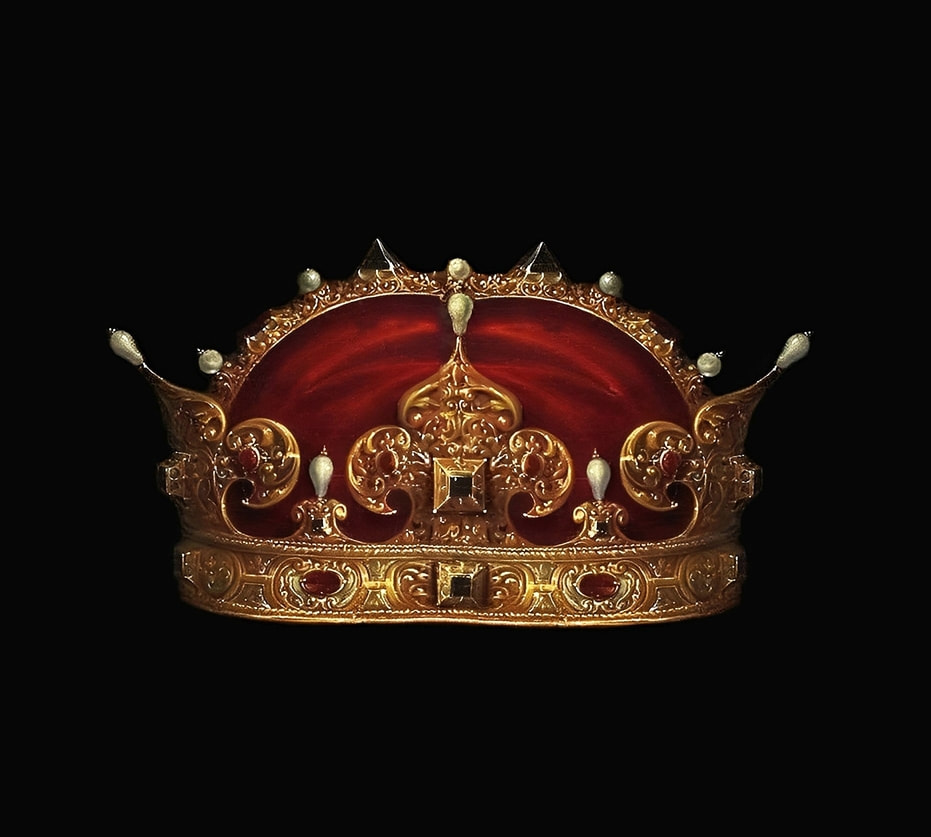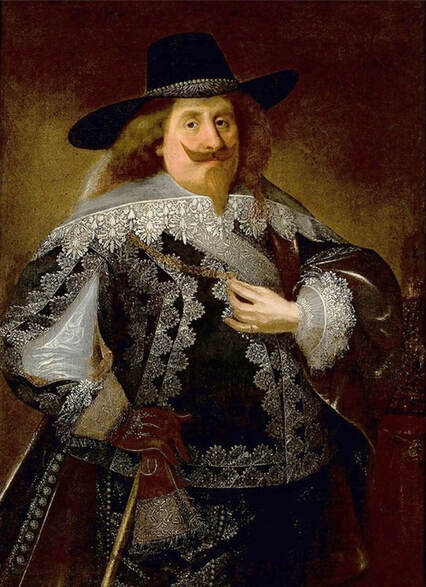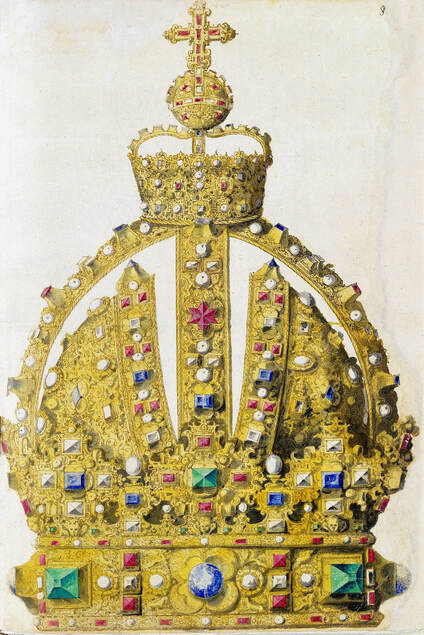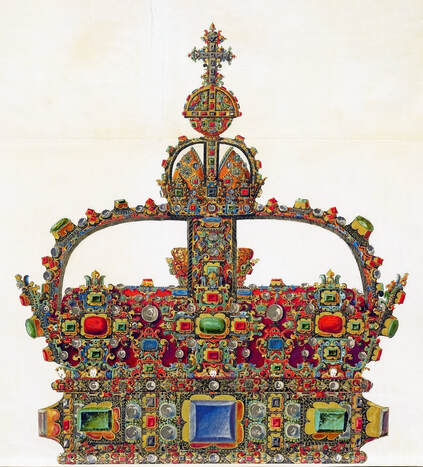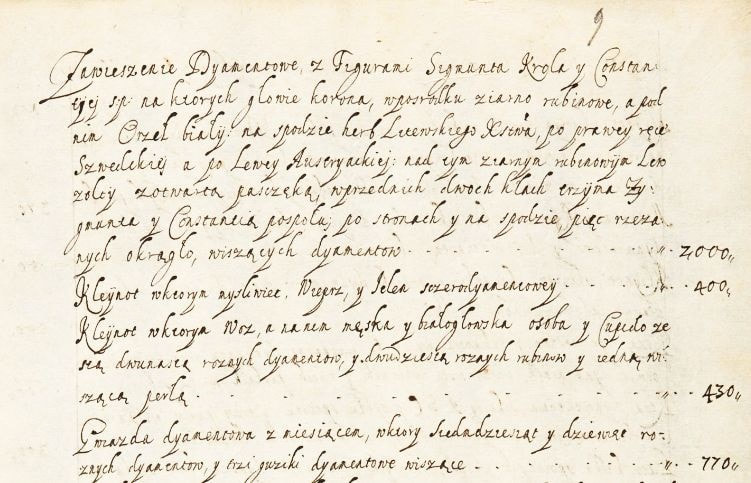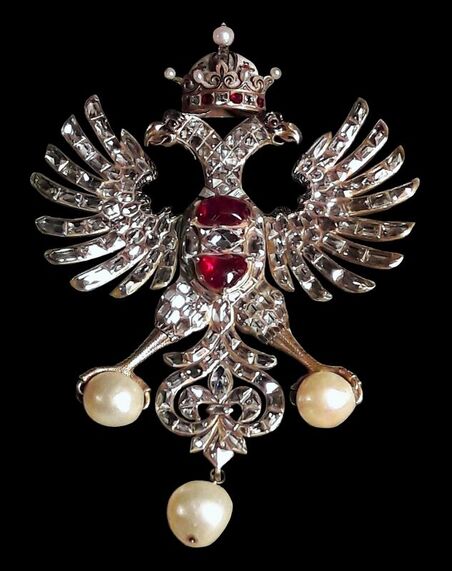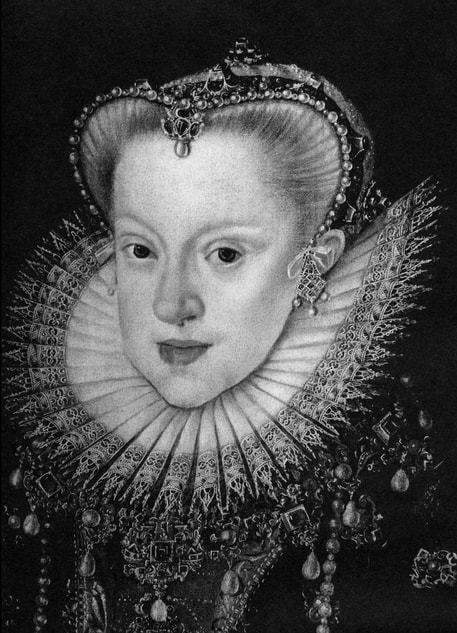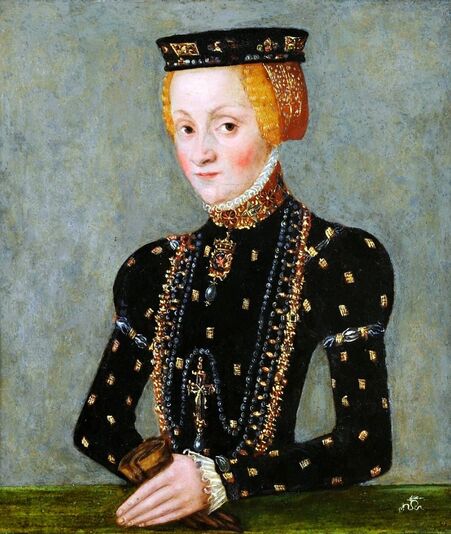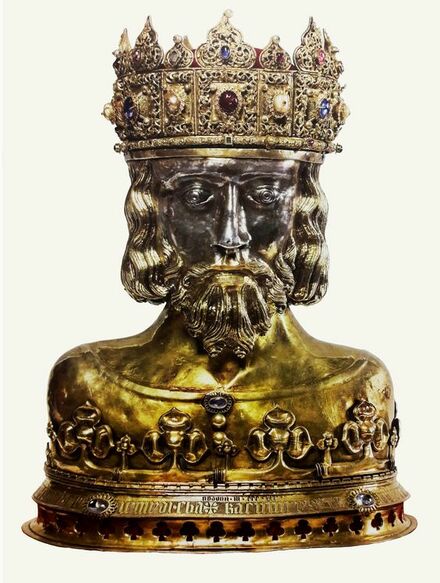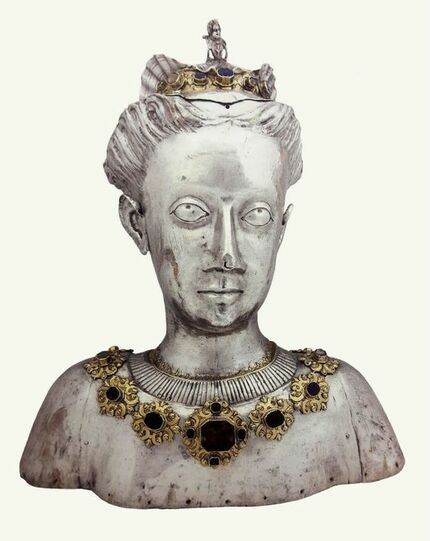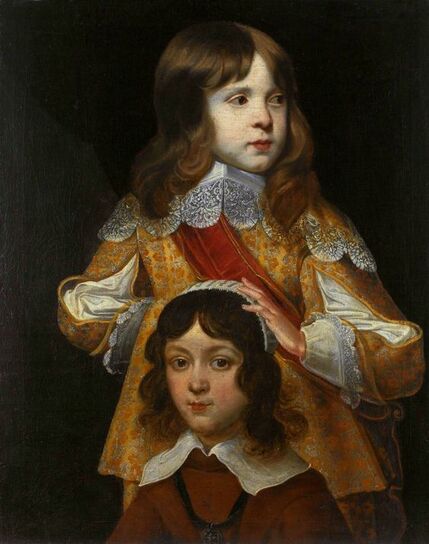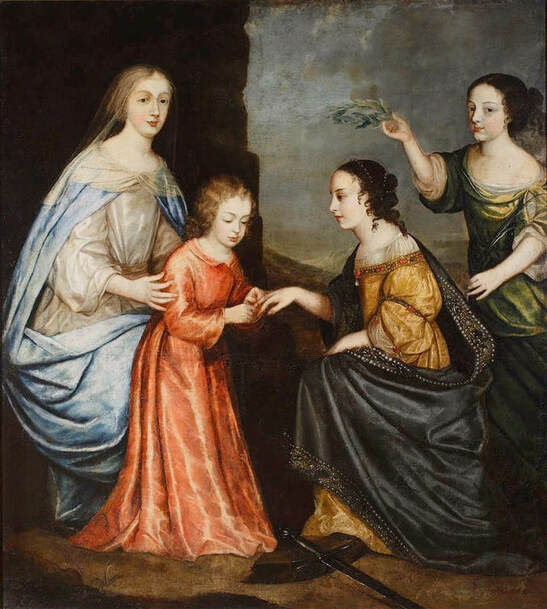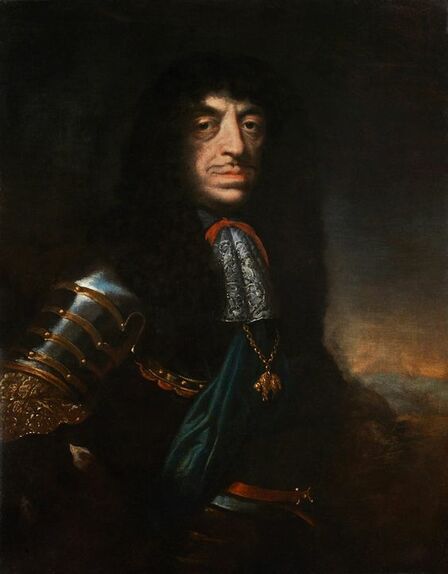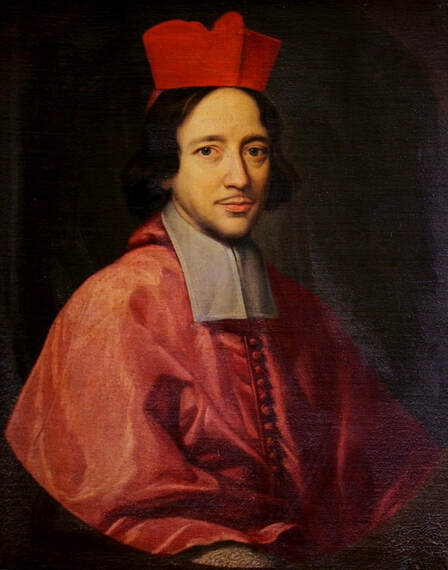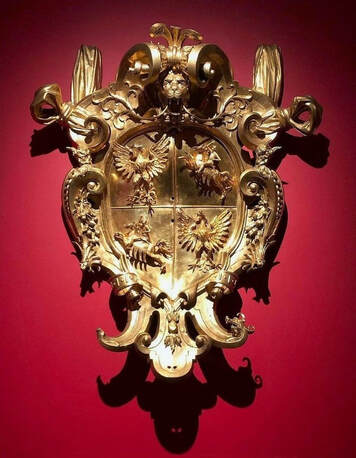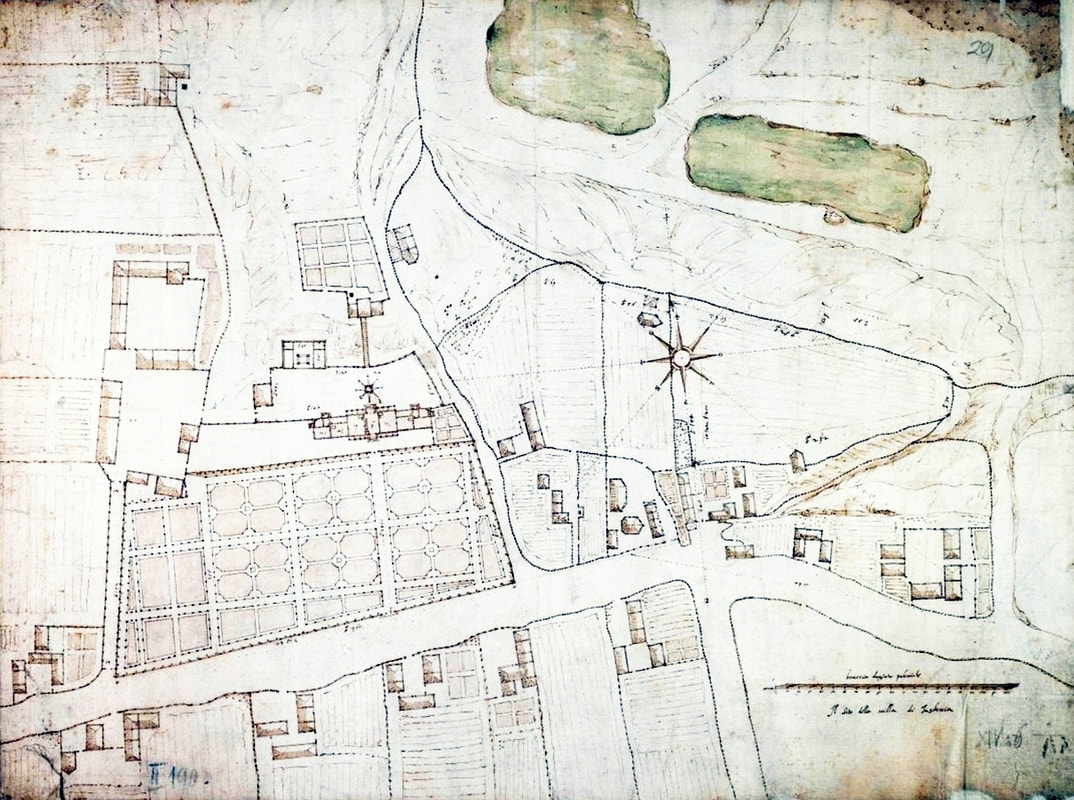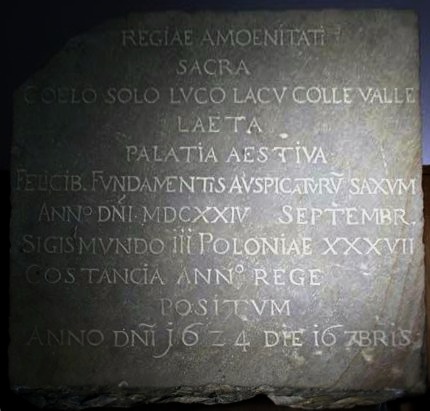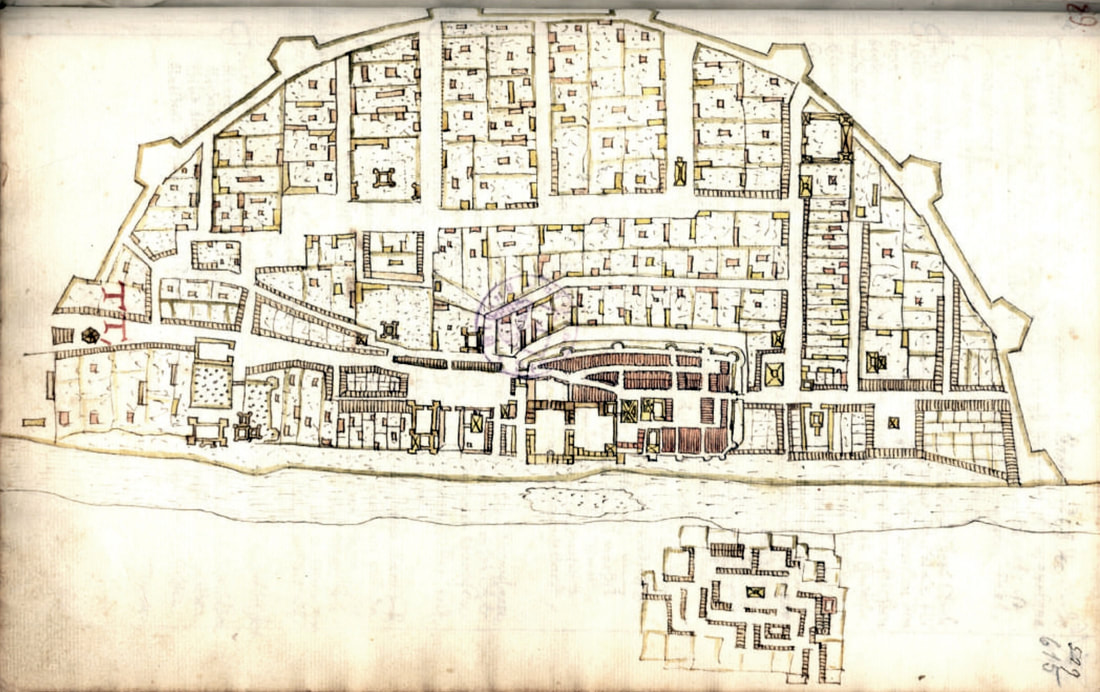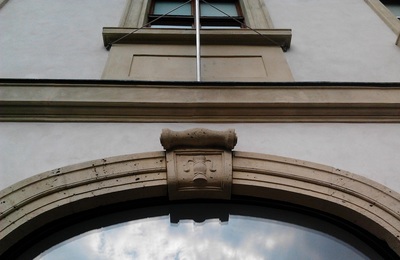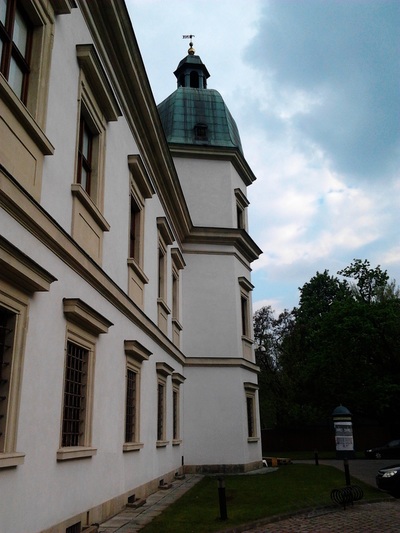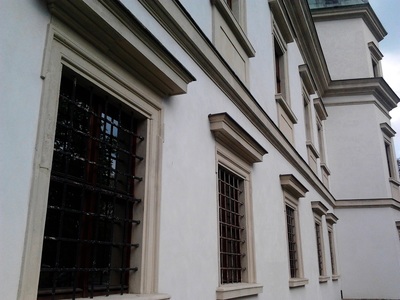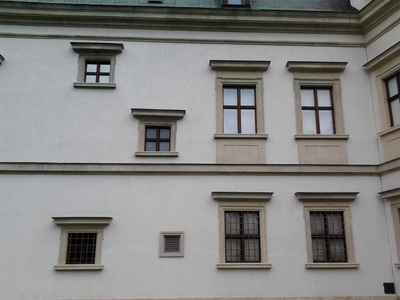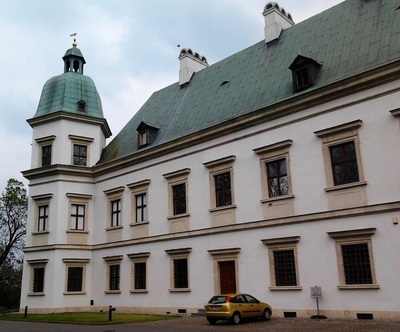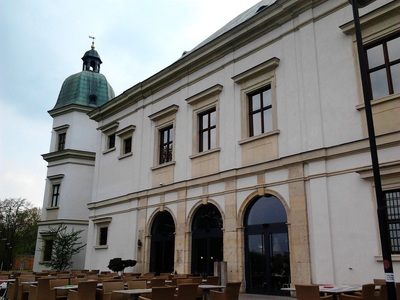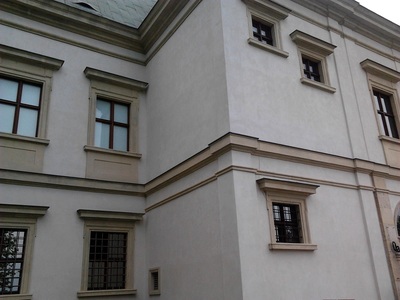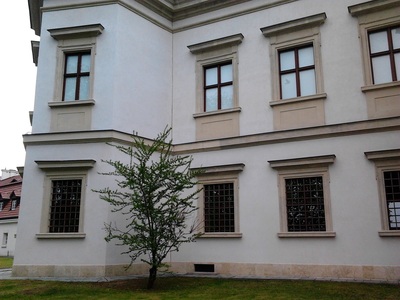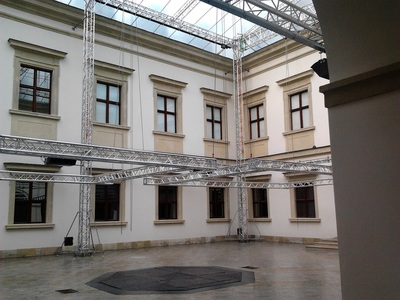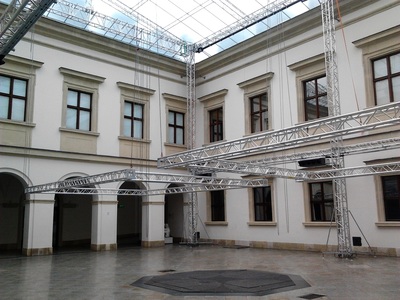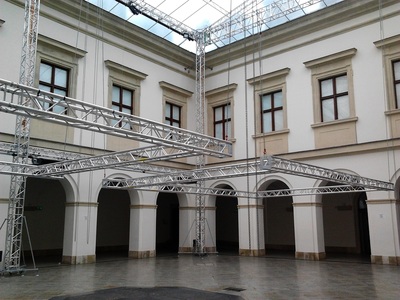|
Portraits of Sigismund III Vasa and Stanisław Radziejowski by Daniël van den Queborn or follower of Frans Pourbus the Younger
In the Czartoryski Museum in Kraków there is a portrait of King Sigismund III Vasa attributed to Dutch school (oil on panel, 93 x 68 cm, inventory number MNK XII-352). The painting was purchased in 1875, together with other portraits and miniatures, from Mikołaj Wisłocki from Pogorzela. It was initially attributed to Bartholomeus van der Helst (1613-1670) and according to the printed sticker on the back of the painting it was purchased in Podbela in Belarus, near the Białowieża Forest and hung for a long time in the old larch chapel in Białowieża (Zygmunt 3o Król - na drzewie ma być roboty fan der Helsta malarza Holenderskiego - nabyty w Podbiałey, pod puszczą Białowieską - wisiał bardzo długo w Starey Modrzewiowej Kaplicy w Białowieży (gub. Grodzieńska:)).
Jagiellonian hunting mansion located in Stara Białowieża was probably used as early as 1409, and around 1594, during the reign of Sigismund III Vasa, it was moved to the center of modern Białowieża, where a mill was also built. Less than a year after his election, in 1588, in the face of the plague in Kraków, the young king left the capital and hunted in the Białowieża Forest. "The manor house in Białowieża built for His Royal Highness for passage and hunting" is mentioned in 1639 and it was destroyed during the Deluge (1655-1660) or soon after and was last mentioned in 1663. In 1597 Sigismund III orders the Court Treasurer of the Grand Duchy of Lithuania, Dymitr Chalecki (d. 1598), to cancel the charges against the serfs employed in digging "Our Białowieża Pond" and to "relax the heavy burdens in the works" (after "Dwór łowiecki Wazów w Białowieży ..." by Tomasz Samojlik and others, pp. 74, 76-77, 80, 84). In 1651 Sigismund's son John II Casimir empoyed a Dutch architect and engineer Peeter Willer (or Willert) for similar works in Nieporęt near Warsaw and Henry IV of France (1553-1610) brought the best Dutch engineers to dry out, drain, build polders with their canals, locks, meadows, and low farms all round the coast of France (after "The French Peasantry ..." by Pierre Goubert, p. 2). It is quite possible that Sigismund also employed specialists from the Netherlands, also those already active in Polish Prussia, to create ponds and supply plants and fish. The painter probably never saw the king in person, so the resemblance is not striking, especially to portraits by Martin Kober, which has led some authors to suggest that it was originally a portrait of somone else transformed into the king's effigy. Probably in the 17th century, as the style suggest, a Latin inscription (SIGISMVNDVS III / DEI GRA: REX POLONIÆ) and a crown were added, however taking into consideration the provenance from the royal Białowieża, tradition, general resemblance and inscriptions there is no reason to claim that this is not an original portrait of the king commissioned in the Netherlands. A similar effigy of Sigismund with a long mustache and blond hair was included in hand colored map of the Polish-Lithuanian Commonwealth (Poloniae Amplissimi Regni Typvs Geographicvs) from Speculum Orbis Terrarum by Gerard de Jode, published in Antwerp in 1593. The likeness of the king is one of the few effigies in this publication, which could indicate that the Polish court influenced it on this particular map or that it was inspired by the increase in orders for effigies in the Netherlands at that time. The style of the painting from Białowieża is reminiscent of the two portraits unanimously attributed to Frans Pourbus the Younger (1569-1622), a Flemish painter from Antwerp (from about 1592 active in Brussels), in the Galleria nazionale di Parma, identified as Luigi Carafa and his wife Isabella Gonzaga (inventory number 297, 303), however, it is even more similar to two paintings atributed to another painter from Antwerp - Daniël van den Queborn, both in the Rijksmuseum in Amsterdam. One depict a child 18 months old in 1604, possibly Louis of Nassau, the illegitimate son of Prince Maurice of Orange (SK-A-956) and the other, dated '1601', Francisco de Mendoza, Admiral of Aragon and Marquis of Guadalest, who was mayordomo mayor (lord high steward) in the household of Albert VII, Archduke of Austria and took part in different diplomatic missions to Poland, Hungary, Styria and the Holy Roman Empire (SK-A-3912). In 1579 Daniël joined the guild of Middelburg and in 1594 he became court painter to Prince Maurice in The Hague. The style of the king's costume and ruff is very similar to that seen in Gortzius Geldorp's portraits of the 1590s - portrait of Jean Fourmenois, dated '1590' (Rijksmuseum in Amsterdam, SK-A-912) and portrait of Gottfried Houtappel, dated '1597' (The State Hermitage Museum, ГЭ-2438). Portrait of Joachim Ernst (1583-1625), Margrave of Brandenburg-Ansbach (sold at Christie's, 27 October 2004, lot 46) from the 1610s, as his costume indicate, is attributed to follower of Frans Pourbus the Younger. In 1609, Pourbus moved to Paris and Joachim Ernst's stay in France at that time is not confirmed in sources. On August 14, 1593 Sigismund III arrived in Gdańsk with his wife Anna of Austria, sister Anna Vasa and the entire court. The city was a major port of the Commonwealth where Netherlandish influences became predominant at that time in almost all aspects of life (trade, art, architecture and fashion). The river cruise from Warsaw to Gdańsk lasted 12 days and the ceremonial welcome took place at the Green Gate. On 15 August 1593 the court took part in the procession at the Dominican Church. The ceremony was presided over by the Bishop of Kuyavia, Hieronim Rozdrażewski, who purportedly commissioned a drawing illustrating the event (possibly a study for a painting), attributed to Anton Möller the Elder (Wawel Royal Castle). The king then went with the court to Wisłoujście, from where on September 16, on 56 or 57 ships, he sailed with the people accompanying him and a detachment of the Polish-Lithuanian army to Sweden. The king embarked on a ship provided by the city of Amsterdam (after "Polacy na szlakach morskich świata" by Jerzy Pertek, p. 56). It is possible that among the courtiers accompanying the king was also the young nobleman Stanisław Radziejowski (1575-1637). He was a courtier at the court of the widowed Queen Anna Jagiellon in Warsaw, where he received the title of court steward and after her death in 1596 he passed to the court of Sigismund Vasa, where he again served mainly Queen Anna of Austria and her son Ladislaus Sigismund. He later did not hold any functions at the court, but he took part in confidential missions abroad and in the Commonwealth (after "Radziejowice: fakty i zagadki" by Maria Barbasiewicz, p. 41). Stanisław studied abroad, in Würzburg in 1590. In 1598 he was sent as a peace delegate to Moscow, he become the starost of Sochaczew in 1599 and he accompanied the king during his travels (e.g. in 1634 to Gdańsk). Radziejowski often had the opportunity to host the entire royal court under his roof in his estate in Radziejowice near Warsaw. There was no foreign envoy, no apostolic nuncio who did not experience his hospitality and Queen Constance of Austria, Sigismund's second wife, willingly took a bath in Radziejowice. No effigy of Stanisław preserved in Poland, but as a courtier so close to the queen who traveled abroad, he undoubtedly dressed primarily in Western European fashion. The painting in the National Museum in Kraków (inventory number MNK I-20) depicting the Adoration of the Crucifix with King Sigismund III Vasa and his male courtiers, painted by Wojciech Maliskiewic in 1622, clearly shows the disposition of fashion at the royal court. Only a quarter of the courtiers are dressed in national costume, the others wear ruffs and fashionable hose. In 1583 Balthasar Bathory de Somlyo, nephew of King Stephen Bathory raised at his court in Kraków, was portraited by Hendrick Goltzius in French costume during his visit to the Netherlands with his friend Stanisław Sobocki. Treasurer (Jan Firlej, Grand Treasurer of the Crown) from Stanisław Sarnicki's "Statutes and records of crown privileges", published in Kraków in 1594, also wears western attire, as well as Stanisław's infamous son Hieronim (1612-1667), who was depicted dressed according to Western European fashion in a print by Jeremias Falck Polonus, created in 1652. In 2022 a portrait of a young man painted in similar style to the Białowieża portrait was sold at Dorotheum in Vienna (oil on canvas, 65.5 x 55 cm, 11.05.2022, lot 25). This painting is attributed to Frans Pourbus the Younger and comes from private collection in Uruguay (since the 1920s). The exact provenance is unknown, so it is possible that it was associated with Polish immigration to Uruguay where the first Poles arrived in the 19th century as political refugees who fled after the January Uprising (the first Polish organization in Montevideo was established in 1921). The young man is wearing a fashionable embroidered doublet and a lace ruff. According to Latin inscription in upper part of the painting it was created in Antwerp and the sitter was 18 in 1593 (ANTVE'[rpiae] ANo SAL.. / 1593 / ÆTA' SVÆ.18..), exacly as Radziejowski, when he may have finished his studies and could board a ship in Antwerp for Gdańsk or just order it from Gdańsk in Antwerp, like his grandson Cardinal Michał Stefan Radziejowski, who ordered his portrait in Paris (attributed to painter from Antwerp Jacob Ferdinand Voet, Czartoryski Museum, MNK XII-377). The family resemblance is striking with the portrait of Michał Stefan in the Museum of Warsaw (MHW 15948), and mentioned effigy of Stanisław's son, the shape of the nose, the puffiness under the eyes and a dimple in the chin being particularly similar in these family members. A painting attributed to Frans Pourbus the Younger, which may come from the collection of Sigismund III and possibly linked to Radziejowski's diplomatic activity, is in the Lithuanian National Museum of Art in Vilnius (oil on canvas, 56 x 44 cm, LNDM T 4019). This "Portrait of a woman with a red ribbon" is dated at the top right '1604' and belonged to the same gallery as "Portrait of a woman with a diadem", dated '1614' (LNDM T 4018), which is an effigy of Marie de' Medici (1575-1642), Queen of France by Alessandro Maganza, identified and attributed by me. The woman's costume is also similar to that visible in another effigy of the Queen of France, created by Thomas de Leu or circle around 1605 (Austrian National Library), while her facial features resemble those of Christina of Lorraine (1565-1637), Grand Duchess of Tuscany (wife of Marie's uncle), after a print by Thomas de Leu, produced between 1587-1590 (The Royal Collection, RCIN 615750). Her features also resemble those in Christine's other portraits, such as that by the French painter, perhaps François Quesnel, from 1588 (Uffizi Gallery in Florence, Inv. 1890, n. 4338) or a copy by the Italian painter, painted after 1589 (sold at Sotheby's New York, May 26, 2023, lot 314). Around 1604, Frans Pourbus painted Christine's future daughter-in-law - Archduchess Maria Magdalena of Austria (1587-1631) in a yellow dress (Kunsthistorisches Museum, GG 3385) and her older sister Constance (GG 3306). Several portraits of the Polish-Lithunian Vasas preserved in Florence, such as the full-length portrait of Sigismund III (Inv. 1890, n. 2270) dating from around 1610. The monarchs of the Commonwealth undoubtedly also owned numerous effigies of the sovereigns of Tuscany. Some of them may also have been brought by Radziejowski, who was in Florence in 1616 and who in 1615 gave Grand Duchess Maria Magdalena a mirror in an amber frame.
Portrait of King Sigismund III Vasa (1566-1632) by Daniël van den Queborn or follower of Frans Pourbus the Younger, 1590s, Czartoryski Museum in Kraków.
Portrait of courtier Stanisław Radziejowski (1575-1637), aged 18 by Daniël van den Queborn or follower of Frans Pourbus the Younger, 1593, Private collection.
Portrait of Christina of Lorraine (1565-1637), Grand Duchess of Tuscany in French costume by workshop of Frans Pourbus the Younger, 1604, Lithuanian National Museum of Art in Vilnius.
Portrait of Queen Anna of Austria by Jacopo Tintoretto
Italian painters, faithful to ancient Roman tradition, frequently idealized their models. On the other hand, painters of the Nordic, Netherlandish and German schools, preferred a sometimes grotesque naturalism. This is best seen in the portraits of Emperor Charles V. In the paintings by Marco Cardisco, Parmigianino, Titian, Giorgio Vasari and Francesco Terzi, he is a quite handsome man with harmonious features and large eyes, while in the paintings by Lucas Cranach, Jakob Seisenegger, Jan Cornelisz Vermeyen and Flemish painters, he sometimes looks more like a court jester than a ruler of one of the greatest empires in history.
It was also a strong Habsburg tradition to collect effigies of different rulers of Europe, especially members of their own family. The effigies of Habsburg women who became queens of Bohemia, Hungary, Portugal, France, Denmark, duchesses of Tuscany, Mantua, Savoy, Parma, Bavaria or princesses of Transylvania are richly represented in their collections in Madrid and Vienna. It is therefore quite unusual that the Polish queens from the House of Austria are almost not represented in the collections known today. Some preserved inventories prove that the effigies of Polish monarchs were in the Habsburg collections in Madrid and Vienna. For example, the inventory of certain belongings of Queen Margaret of Austria, sister-in-law of King Sigismund III Vasa, subject to her guardian of the jewels (guardajoyas) Hernando Rojas, from October 1611, lists a miniature portrait (naipe) of the son of the king of Poland (Un retrato del hijo del rey de Polonia en un naipe, item 146) and thirteen "miniature portraits of members of the queen's household, our lady" (Trece retratos de naipe de personajes de la cassa de la reyna, nuestra señora, item 151) (after "Inventare aus dem Archivo del Palacio zu Madrid" by Rudolf Beer, p. CLXXV). For Sigismund's first wife, Anna of Austria (1573-1598), the portraits of her family left in Graz and lost during the Wawel fire in 1595 were obviously of great importance. After the fire, new portraits of the family in Graz had to be painted. The mother, Archduchess Maria Anna of Bavaria, soon sent a portrait of herself, but Anna said the picture bore no resemblance to her mother. "I'm sorry that YH [Your Highness] doesn't have a painter yet. My husband gave me permission for his painter to send him out to paint everyone when he has time, so he will have plenty of work to do" (Es ist mir ye gar laid, das ED [Eure Durchlaucht] jez kain maler hat. Mein gemahel hat mir sein maler bewilligt, wan es wider ED nit wer, denselben hinauszuschigken und alle abzemalen, wann er ainmal zeit hat, dann er hat jez gar vil ze arbaiten), she wrote to her mother in a letter dated April 6, 1595 most likely about the court painter Martin Kober (after "Das Leben am Hof ..." by Walter Leitsch, p. 371, 1267-1269, 1280, 1284, 2376, 2378-2379, 2562). Some information preserved in Austria on the portraits exchanged in preparation for the king's first marriage. The beginnings of the negotiation date back to a time when both were still children, the bride was not yet eight years old and the groom was fourteen and a half years old. It is possible that a portrait of an eight-year-old girl was sent by the Habsburgs. When the affair came to light nine years later, a portrait had to be sent again. "I would like to affirm that the king, as soon as he received the Archduchess Anna's effigy, fell deeply in love with it, opened it in his chamber and, having stood in front of it for a long time, also sent a retrato [Spanish for portrait] of her to his father, the king in Sweden, who was also happy to accept such things" (wol affirmiren, das der könig, alsbald er dero erzherzogin Anna contrafee bekomben, sich stark darein verliebt, dasselbe in seiner camer aufgemacht und villmallen ein guette lange weil darvor gestanden seye, auch seinem herrn vattern, dem könig in Schweden, ein retrato darvon geschickt habe, der im solches gleichsfalls gar wol gefallen lassen), wrote Sebastian Westernacher to Archduchess Maria Anna of Bavaria on May 19, 1591. The effigy of sixteen-year-old Anna hung in the king's bedroom and she was depicted wearing "a white-silver embroidered dress" (in einem weiß silbernen gewirkten rock abconterfeyet), according to a Kraków newspaper about the wedding in May/June 1592. Contemporaries certainly knew that these portraits were often largely beautified, so that the groom had only two options if he wanted to avoid exposing himself to the unknown: send beauty spies or trust the pictures. Before his first marriage, Sigismund sent such spies, but he probably also trusted the effigies. An emissary of the king delivered his portrait to the court master (Hofmeister) of Anna's mother, representing him wearing a jewel with the monogram SA, most probably of his uncle Sigismund Augustus or the groom and bride (Sigismund and Anna), recounted Archduchess Maria Anna to Emperor Rudolf II, in a letter from Graz, dated July 8, 1591 (seines künigs contrafet in ainem tafelein von ebano, darbey auch ain gemaldes glainot an einer klainen gulden kettl an des künigs hals hangend, und darinnen dise zwen puechstaben SA zu sehen). According to some sources, Sigismund's first wife did not care much for luxury. Her confessor, Fabian Quadrantinus (1549-1605) from Starogard Gdański, educated in Rome, affirmed that: "No gold, no jewels, no precious stones were seen on her. She was dressed mostly in black". Other documents prove she did it. According to one inventory, the queen owned more than a hundred items of clothing, and according to a second inventory, more than two hundred. She ordered goods from Florence and purchased luxury goods from Gdańsk. She always ate with a gold spoon and wore jewelry, regularly a ruby and emerald ring, as well as a necklace with a sapphire. Urszula Meyerin, in a letter dated April 3, 1598, claimed that even when she was young, Anna "never respected the voluptuousness, splendor, joys or lusts of the world, but despised and rejected them" (nimmermehr der welt üppigkeit, pracht, freuden oder wollusten geachtet, sondern vielmehr verachtet und verworfen). Jan Bojanowski, however, wrote shortly after her arrival that she was far from being melancholy (krolowa pani nasza is iest pani od melancholiei daleka) and that she was always joyful, but with a gracious dignity (letter of June 22, 1592). When the king wanted to go into battle against the Tatars, the queen expressed the wish to stay close to him, "if necessary, she also wanted to become a mercenary and wear armor" (wan's sein müeste, wolt sie auch ein landsknechtin weren und das fäleisen nachtragen, letter from Ernhofer to Archduchess Maria Anna, April 5, 1595). When she was sent a new portrait of her brother who had become fat, she wrote to her mother: "That's why it seems to me that he was in his 10th month [of pregnancy]" (Darum es dunkt mich auch, ehr sei ihn 10. monat gwesen, letter of February 1, 1597). In another letter to her mother, she commented "that the good old King of Spain is really funny and that you can really enjoy him" (das der guett alt kinig von Hispania erlich paufellig ist und das man sein auch schier gnueg hatt, letter of May 3, 1597). The queen was also adventurous and repeatedly went out incognito to see something, such as the procession on January 27, 1595. Together with Anna Radziwiłłowa née Kettler (1567-1617), she went out in a sleigh "dressed like a patrician lady" (wie burgerin geklaidet). They were not recognized by Polish women and when one of them tried to force her way before the queen, Radziwiłłowa began to argue with her (letter from Ernhofer to Archduchess Maria Anna, March 6, 1595). Similar to other Polish-Lithuanian ladies who experimented with fashion, the young queen undoubtedly also wore Venetian, French, Florentine or Flemish dresses, as described by Piotr Zbylitowski in his "Reprimand of Women's Extravagant Attire" (Przygana wymyślnym strojom białogłowskim), published in Kraków in 1600. Although the queen was very pious, she was not stubbornly zealous like her mother. From August 1592 to August 1593, the young queen lived near the Italianate court of the elderly Queen Anna Jagiellon, sending letters from residences in Ujazdów and Łobzów. Relations between the two queens were probably a bit difficult for many reasons. Above all, they had no common language, as the young queen only spoke German and Spanish and understood Latin and Polish - according to Giovanni Paolo Mucante (Intende, come dicono, la lingua latina, la spagnola, la todesca et anco la polacca, ma non parla se non todesca et spagnola, letter of September 25, 1596). Anna Jagiellon spoke Latin, Polish and Italian. At the beginning there were also some difficulties with priority. During the last six months of her life, the old queen once again lived under the same roof as the young queen. Anna of Austria one day sent her mother the gifts she had received from Anna Jagiellon (letter of November 22, 1593). Young Anna also cared for the old, sick queen herself. The relationship between the two was so good that Archduchess Maria Anna became truly jealous (letter from Salome von Thurn to Archduchess Maria Anna, May 5, 1594). In the Prado Museum in Madrid there is a portrait of a young woman in a green dress sitting on a chair (oil on canvas, 114 x 100 cm, inventory number P000484). The painting comes from the Spanish Royal Collection (no. 597) and was initially attributed to Paolo Veronese (1528-1588) and now to Jacopo Tintoretto (1518-1594). The woman has flowers in her hair and her costume indicate that the painting was made in the 1590s. A similar dress can be seen in a portrait of a woman from the Gemäldegalerie Alte Meister in Dresden (inventory number Gal.-Nr. 249), dated around 1590 and previously thought to represent Marie de' Medici, Queen of France. Comparison with two woodcuts from Habiti Antichi Et Moderni di tutto il Mondo ... by Cesare Vecellio (Czartoryski Library, 2434 I Cim), book published in Venice in 1598 and assembling contemporary fashion from across the world - Gentildonne ne'Regiment (p. 104) and Donne per casa (p. 108), indicates that she wears the costume of a Venetian noblewoman at home. In this book, the effigy of King Sigismund III (Rè di Polonia / Poloniæ Rex, p. 346) was published with some typical costumes of the Polish-Lithuanian Commonwealth. Her protruding lower lip and provenance of the painting indicate that she is a Habsburg. The painter beautified the effigy by making the nose and lips smaller, however, the resemblance to other effigies of the Queen of Poland is notable, in particular the portrait from the Royal Castle in Warsaw (FC ZKW 1370), her effigy in the scene of the Birth of the Virgin by Juan Pantoja de la Cruz in the Prado Museum (P001038) and her portrait by Martin Kober in the Uffizi Gallery (2392 / 1890). Idealization was common at that time. The portrait of King Sigismund III Vasa in a large hat by workshop of Philipp Holbein II, which was before 1939 in the collection of Jan Perłowski in Warsaw (lost during the World War II), is the best example of this practice, perhaps initiated by the painter, who wanted the model to conform more to his standards of beauty. The woman in this portrait also closely resembles the queen's younger sister, Constance, who a decade later would become the second wife of Sigismund III, in her idealized portrait at Wawel Royal Castle (inventory number 1783). According to inventories of Queen Anna's clothing held at the National Archives of Sweden in Stockholm (Riksarkivet, Extranea 85), probably made around 1595, the queen also owned a dress similar to the one depicted in the painting: "A green damask skirt with gold edges" (Ain grien damasten rock mit golt gebrämbt, 92).
Portrait of Queen Anna of Austria (1573-1598) in a Venetian damask dress by Jacopo Tintoretto, ca. 1592-1594, Prado Museum in Madrid.
Portrait of King Sigismund III Vasa in a large hat by workshop of Philipp Holbein II, 1610s, lost during World War II.
Portrait of Prince Jerzy Zbaraski as Saint George by Paolo Fiammingo
In 1591, after initial studies in the country, the young Zbaraski brothers Jerzy (George) or Yuriy (1574-1631) and Krzysztof (Christopher) or Kryshtof (1579-1627), descendants of Ruthenian Prince Fyodor Nesvitsky (died before 1442), went on a long trip abroad. They visited Germany, Italy and France. They studied in Padua (1592-1593) and visited Venice, Rome and Naples. In France, they went to Lyon, Bordeaux and Paris. While studying abroad, the brothers converted from Calvinism to Catholicism, however, they were supporters of religious tolerance and opponents of the enormous influence of the Jesuit Order.
They returned to the country at the turn of 1594 and 1595. In the following year (1596) they participated in the expedition to Hungary, in the Moldavian expedition and in the siege of Suceava. In 1598 Jerzy was in the retinue accompanying King Sigismund III Vasa in Sweden. Probably at the turn of 1600 and 1601, both Zbaraski brothers went to the Netherlands, where Jerzy studied Greek and history under Justus Lipsius in Louvain. Between 1602-1605, Krzysztof stayed in Italy again, where he mastered mathematical science under the supervision of Galileo. In 1616 also Jerzy returned to Padua where he enrolled at the university. In 1620, after the death of Janusz Ostrogski, Jerzy Zbaraski was appointed Castellan of Kraków. Like his yonger brother Krzysztof, he was not married and had no children. The Zbaraski brothers were the heirs of their father's enormous fortune, in addition to the estates of their mother, Duchess Anna Chetvertynska (Czetwertyńska), a member of the Ruthenian princely family, who according to Józef Wolff were descendants of Yaroslav the Wise, Grand Prince of Kiev. In the 16th century Chetvertynski family owned large estates in Ukraine and Belarus and like Zbaraski family, they had Ruthenian Pogonia, displaying Saint George defeating the dragon, in their coat of arms. Already in June 1589, in the retinue of bishop Radziwill and voivode Mikołaj Firlej, Jerzy visited the imperial court in Prague, where he had the opportunity to admire exquisite art collections of Emperor Rudolf II. From Venice, Jerzy, a great connoisseur and lover of art, brought the painting of Our Lady of Myślenice, later famous for miracles. According to "The History of the Miraculous painting of Our Lady in Myślenice", published in 1642 in Kraków, the original painting belonged to Pope Sixtus V, who left it in his will to the granddaughter of his sister, who became the abbess of a convent in Venice. When Prince Jerzy Zbaraski saw it in the convent, he wanted to have it, but the abbess did not want to give him the original, but agreed to make a copy. During the plague in Kraków in 1624, the painting was supposed to be burnt as "infected", but was spared from destruction. In 1633, the painting was transferred to the parish church in Myślenice. The image of the Virgin Mary is painted on a wood panel (50.3 x 67.8 cm) and because of some style similarities it is attributed to the Prague school from the beginning of the 17th century. The face and pose of the Virgin is however almost identical as in the painting showing Bathsheba at her bath (sold at Cambi Casa d'Aste in Genoa on 30 June 2020, lot 100), created by Paolo Fiammingo (Paul the Fleming, ca. 1540-1596). Fiammingo, born Pauwels Franck, was a Flemish painter, who, after training in Antwerp, was active in Venice for most of his life. He also possibly worked in Florence. Around 1573 he settled permanently in Venice, where he became a student of Jacopo Tintoretto. He opened a successful studio, which received commissions from all over Europe. One of his most important clients was Emperor Rudolf II and Hans Fugger, the heir of a German banking dynasty, who commissioned him in 1580 to produce several paintings to decorate the Swabian Escorial - Kirchheim Castle near Augsburg. The style of the hand of Mary in Myślenice painting is similar to that visible in the Lady revealing her breast (An honest courtesan) by Domenico Tintoretto, dated to the 1580s (Prado Museum in Madrid, inventory number P000382). The portrait of a man as Saint George in private collection, attributed to Italian or Venetian school, is also similar to Tintoretto's style. This small painting (28.7 x 21.7 cm) was painted on copper and the style of painting resemble more precisely the image entitled Profession of arms from the Munich Residence, attributed Fiammingo and created in the 1590s (Alte Pinakothek in Munich). Prince Jerzy Zbaraski was a founder of at least two churches dedicated to his patron saint, Saint George. One in the main seat of the Prince and his brother, Zbarazh in Volhynia, was the burial place of part of the Zbaraski family. The wooden church and fortified Bernardine monastery was founded in 1606, and from 1627 the new brick church was built, most probably to design by Venetian architect and engineer of His Highness King Sigismund III Vasa, Andrea or Andrzej dell'Aqua, driving nearly 1,600 piles into the marshy area. This church was destroyed in 1648. In 1630 Zbaraski also founded Saint George's church in Pilica. Between 1611-1612, Krzysztof commissioned to Vincenzo Scamozzi in Venice, a project for a fortified palace intendend for Zbarazh. In a commentary to his design, published in 1615 in his "L'Idea Della Architettura Universale", Scamozzi recalled numerous meetings and discusions on military architecture with the learned Ruthenian aristocrat. It was however a design of the Flemish military engineer Hendrik van Peene and Venetian Andrea dell'Aqua that was used to built the new Zbarazh fortress between 1626-1631. His treatise on artillery "Praxis ręczna działa" from 1630 (manuscript in the Kórnik Library), dell'Aqua dedicated to Prince Jerzy Zbaraski. In 1627 Jerzy founded the Zbaraski Chapel at the Gothic Dominican Church in Kraków, as a mausoleum for himself and his brother. It was built by the masons and sculptors Andrea and Antonio Castelli, probably according to the design of the royal architect Constantino Tencalla. In the baroque chapel there are monuments to two brothers carved in black Dębnik marble and white alabaster. Jerzy is depicted sleeping in armour and in a pose almost identical to that in the tomb monument of King Sigismund I the Old in the Sigismund's Chapel (1529-1531). His hairstyle is typical of a Polish-Lithuanian magnate from this period and he is holding his mace like if he was holding his manhood, a less subtle allusion to his virility or promiscuity. It is possible that some of the highly erotic works by Fiammingo were commissioned by Prince Zbaraski. The man depicted as Saint George resemble Jerzy Zbaraski from his tomb sculpture, his portrait painted in the 1780s after original from the 1620s (Wilanów Palace in Warsaw) and effigies of his brother Krzysztof (National Museum of the History of Ukraine and Lviv National Art Gallery). Jerzy was accused of a dissolute lifestyle and when he decided to put an end to coin counterfeiters with whom he was about to cooperate, they "persuaded one lady who visited the prince to give him a poison" (after "Niepokorni książęta" by Arkadiusz Bednarczyk, Andrzej Włusek). Despite having no children, the memory of the last Prince Zbaraski preserved in the exquisite works of art that he commissioned.
Portrait of Prince Jerzy Zbaraski (1574-1631) as Saint George by Paolo Fiammingo, 1592-1594, Private collection.
Our Lady of Myślenice by Paolo Fiammingo, 1592-1594, Saint Mary's church in Myślenice.
Portrait of royal courtier Sebastian Sobieski by Leandro Bassano
Around October 16, 1593, king Sigismund III Vasa departed from Gdańsk for his coronation as the hereditary king of Sweden. He was accompanied by his courtiers, including Sebastian Sobieski (ca. 1552-1614), third son of captain Jan Sobieski (ca. 1518-1564) and Katarzyna Gdeszyńska. Earlier that year, in February, Sebastian was sent by the King as his envoy to the Lublin Sejmik (regional assemby). It is the first confirmed important function of this royal courtier. "Instructions for the Lublin Sejmik given from His Majesty to Sebastian Sobieski, a royal courtier in Warsaw on February 16, 1593", is in the Czartoryski Library in Kraków (BCz 390).
Sobieski most probably studied at the Calvinist school in Bychawa near Lublin. On December 17, 1576, probably thanks to the intercession of the Crown Vice-Chancellor Jan Zamoyski, he was admitted, as a page, to the court of king Stephen Bathory. Then, like his brothers, due to growing influence of the Counter-Reformation movement at the royal court, he converted to Roman Catholicism. On May 1, 1584, he was transferred to the group of salatariati saeculares (lay beneficiaries) in which he was until the death of the king. He became a supporter of Zamoyski, supported the election of king Sigismund III and, apparently, he participated in the defense of Kraków against the attack of the troops of Archduke Maximilian II in 1587 and the Battle of Byczyna in 1588. From May 1596, he held the position of Standard-Bearer of the Crown and as such he was depicted in the "Entry of the wedding procession of Sigismund III Vasa into Kraków in 1605" (Royal Castle in Warsaw). Portrait of a bearded man in oriental costume from private collection in France, due some similarity to the style and, possibly, dates of his life is attributed to Hans von Aachen (1552-1615), a German painter trained in Italy. In 1592, while he was still working in Munich, von Aachen was appointed a court painter of Rudolph II, Holy Roman Emperor and moved to Prague in 1596. According to inscription in Latin in upper right corner the man was 41 years old in 1593 (ANNO 1593 / ÆTATIS 41), exacly as Hans von Aachen, but also Sebastian Sobieski, born in about 1552. The portrait is evidently not a self-portrait of imperial court painter and this wealthy nobleman was depicted in a crimson silk żupan buttoned up to with gold buttons, very similar to żupan buttons of Stanisław Piwo, deputy cup-bearer of Płock, from the second quarter of the 17th century (Skrwilno Treasure, Toruń Regional Museum). His black coat trimmed with lynx fur it is almost identical to the one shown in the portrait of Jan Opaliński (1546-1598), created in 1591 (National Museum in Poznań), or in Twelve Polish and Hungarian types by Abraham de Bruyn, created in about 1581 (Rijksmuseum Amsterdam). His lace collar is very similar to the one in the effigy of The Marshal (Stanisław Przyjemski with a marshal staff) from Stanisław Sarnicki's "Statutes and records of crown privileges" by Jörg Brückner in Kraków, created in 1594 (Czartoryski Library). Letters on the table are very important documents, most probably envoy instructions given by the king. The style of painting is identical with portrait of Doge Marino Grimani (1532-1605), created in about 1595 by Leandro Bassano, signed: LEANDER A PONTE BASS [ANO] EQVES F. (Princeton University Art Museum). The man bear a resemblance to effigies of Sebastian Sobieski's brother Marek Sobieski (ca. 1550-1605), voivode of Lublin (1862 woodcut after lost portrait from the Zamoyski collection) and his brother's descendant (Marek's grandson), king John III Sobieski (portrait painting from the 1670s in the Kórnik Castle). Mentioned portrait of Jan Opaliński in Poznań, a copy of a painting destroyed during World War I (from the burnt manor house in Rogów near Opatowiec), is considered by Michał Walicki as a very definite manifestation of the Venetian tradition "referring to the portraits of the Bassanos" (after "Malarstwo polskie: Gotyk, renesans, wczesny manieryzm", p. 33). Stilistically very similar was the painting which was before World War II in the Saint Lazarus hospital in Warsaw bearing the inscription in Latin: R. P. PETRVS SKARGA SOCIETATIS IESV. It represented the court preacher of King Sigismund III Vasa, Piotr Skarga (1536-1612), who became the first priest to hold it. The hospital was established in 1591 on his initiative for the poor and lepers and the founder was depicted sitting in his study before a table covered with an oriental carpet.
Portrait of royal courtier Sebastian Sobieski (ca. 1552-1614) aged 41 by Leandro Bassano, 1593, Private collection.
Portrait of Jan Opaliński (1546-1598) aged 45 by follower of the Bassanos, 1591, National Museum in Poznań.
Portrait of preacher Piotr Skarga (1536-1612) by follower of the Bassanos, after 1591, Saint Lazarus hospital in Warsaw, lost.
Portraits of Queen Anna of Austria and her sisters by Martin Kober and Spanish painters
The inventories of Queen Anna's clothing held at the National Archives of Sweden in Stockholm (Riksarkivet, Extranea 85) were probably made around 1595 because include many items created when she was already queen, such as pillows embroidered with the coats of arms of Poland and Lithuania. The young queen dressed primarily in black Spanish saya in the Central European version as shown in her official portraiture by Martin Kober. She also had specifically "Polish clothing" (Volgen IM polnische klaider, items 205-212) and shorter Spanish dresses (Spänische kurze jänger). In private, she wear many colorful clothes - brown, purple, leibfarb (skin color), yellow, red, white, tyrkroth (Turkish red), aschenfarb (gray), blue and others. She also had at least three green dresses: "A green gold cloth robe" (Ain grien gulden stuck, 72), "A green satin skirt with gold edges" (Ain grien atleser rock mit gulden porten, 87) and "A green damask skirt with gold edges" (Ain grien damasten rock mit golt gebrämbt, 92) (after "Das Leben am Hof ..." by Walter Leitsch, p. 1282, 2381, 2555-2562, 2569, 2571).
The green satin "skirt" (87), a symbolic color of fertility, mentioned in the inventory could be the same dress that was depicted in a portrait of Archduchess Anna at the age of 18, dated 1592 (ANNA ARCHIDVCISSA AVSTRIÆ. / ANNO ÆTATIS / XVIII. / MD / LXXXXII.) from the Bavarian State Painting Collections (on permanent loan to the Germanisches Nationalmuseum in Nuremberg, oil on canvas, 60.5 x 50.9 cm, Gm661 / 6846). This portrait, as well as other similar portraits of her mother and siblings, come from Neuburg Castle. It was therefore most likely originally part of the dowry of Constance of Austria (because her portrait is missing from this series) and later the dowry of her daughter Anna Catherine Constance Vasa. Her large golden pendant shows Jupiter and Danae. The young archduchess was therefore painted shortly before her marriage to Sigismund and the style of this painting is close to Martin Kober, who also worked for the Habsburgs - notably similar to the portrait of Anna's daughter Anna Maria Vasa (1593-1600) at the convent of Las Descalzas Reales in Madrid and portrait of Stanisław Lubomirski (1583-1649) and his sister Katarzyna (d. 1612) at the Kunsthistorisches Museum in Vienna. All of Anna's sisters were depicted in similar dresses. Because of this and the strong family resemblance of all the sisters, it is sometimes difficult to determine the model in other series, such as that from the dowry of Archduchess Maria Magdalena of Austria, today at the Villa del Poggio Imperiale in Florence. This series is attributed to Giacomo de Monte (Jakob de Monte), although the style is also close to Kober. In the series in the Kunsthistorisches Museum in Vienna, probably from Graz Castle, the portrait of Maria Christina of Austria (1574-1621), is identifed to depict Anna (inventory number GG 3238). This effigy is attributed to de Monte, who used the same set of study drawings as Kober to create the portrait from the Neuburg Castle painted in 1595, when the Archduchess was 21 years old (MARIA CRISTIERNA ARCHIDVCISSA AVSTRIÆ. / ANNO ÆTATIS XXI. / M.D. / XCV., Alte Pinakothek in Munich, oil on canvas, 60.5 x 52 cm, 6845). In the series from the Convent of the Descalzas Reales in Madrid, also attributed to Giacomo de Monte, the four sisters were transformed into Christian saints - Anna was depicted as Saint Dorothy, Maria Christina as Saint Lucy, Catherine Renata as Saint Catherine and Elizabeth as Saint Agnes. Among the portraits of the family members of Margaret of Austria, Queen of Spain, which were in the Queen's Gallery of the Royal Alcazar in Madrid in 1636, there was undoubtedly also a portrait of the Queen of Poland. These portraits were described as: "Parents and brothers of Queen Doña Margarita. Thirteen half-length portraits of the parents and brothers of Queen Doña Margarita, without frames (?), and made by Bartholome Gonçalez for El Pardo" (Padres y hermanos de la Señora Reina Doña Margarita. Treçe retratos de medio cuerpo arriba de los Padres y hermanos de la Señora Reina Doña Margarita, sin molduras, y los hiço Bartholome Gonçalez para el Pardo, Inventory of the Alcázar of 1636, pp. 185-188). Seven portraits from the series, created by the court painter Bartolomé González y Serrano (1564-1627) before 1627, were deposited in 1918 at the Spanish embassy in Lisbon and were destroyed during the fire of 1975. One of them was reproduced in 1968 in the Antemurale XII (Institutum Historicum Polonicum Romae) as a portrait of Anna of Austria (Anna Regina Poloniae, Museo del Prado). In this likeness, she wears a typical Spanish saya from the end of the 16th century. According to an article by Gloria Martínez Leiva ("El incendio de la Embajada española en Lisboa de 1975", January 16, 2018), it is not an effigy of Anna, but of her sister Archduchess Catherine Renata of Austria (1576-1599). The young girl actually resemble more the effigy of Catherine Renata in 1595, when the Archduchess was 18 years old (CATERINA RENEA ARCHIDVCISSA / AVSTRIÆ. ANNO ÆTATIS XVIII. / M.D. / XCV., Germanisches Nationalmuseum, oil on canvas, 60.6 x 50.9 cm, Gm665 / 6847) by Kober then the portrait of her elder sister from the same series. Posthumous effigies of Archduchess Maria Anna and her husband Charles II of Austria (1540-1590) by González, painted after 1608 (Prado Museum, P002434, P002433), were most likely part of the Lisbon series. Regarding the series by Kober, in which some effigies bear different dates (1590, 1592 and 1595), the painter probably created them at the same time but they show the models at different ages and dates. He most likely copied several effigies of Constance's family while working on paintings for her (or one of her sisters') dowry in 1595 in Graz. The eldest daughter of Archduchess Maria Anna was also depicted with her sisters and mother in the scene of the Birth of the Virgin by Juan Pantoja de la Cruz in the Prado Museum (oil on canvas, 260 x 172 cm, P001038). This painting, commissioned by Queen Margaret of Austria for her private oratory in the palace of Valladolid, was created in 1603 (signed and dated: Juº Pantoja Dela .+. Faciebat. / 1603). It probably commemorates the birth and death of the Infanta Maria of Spain, who died in infancy in her first month (March 1, 1603). Her grandmother, Archduchess Maria Anna, is depicted as a divine midwife accompanied by her already deceased daughters - Anna, Queen of Poland and Archduchess Catherine Renata of Austria, who died at the age of twenty-three before her marriage to Ranuccio I Farnese, Duke of Parma. That is why both of them wear more Italian dresses, because in Poland-Lithuania, Italian fashion was popular. All three look at the viewer. The young girl near Saint Anne's bed also looks at the viewer. Her Habsburg features allow her to be identified as Constance of Austria, who in 1602, with her younger sister Maria Magdalena, was considered at the court of Madrid as a candidate to marry Ferdinand I, Grand Duke of Tuscany, but ultimately married Sigismund III in 1605. Although Pantoja accompanied the royal family on journeys to Valladolid, Burgos, Lerma and El Escorial, he probably never left Spain. Archduchess Maria Anna visited Spain for her daughter Margaret's wedding, but that was in 1599. So all the effigies were created by the Spanish painter based on other portraits of family members of the queen or on study drawings, like the mentioned paintings by Bartolomé González. Archduchess Maria Anna's great attachment to her eldest daughter is demonstrated by the fact that when the Archduchess fell into panic because of the Ottoman advance, she wanted to flee to Poland to be with her daughter, and not to Munich, Prague, Brussels or Madrid. In a letter dated September 18, 1594 from Poznań, the queen assured her mother that she could come to Kraków (solang mein gmahel und ich waß haben, so sol ED auch allezeit unverlassen sein).
Portrait of Archduchess Anna of Austria (1573-1598), aged 18 in 1592, by Martin Kober, ca. 1595, Germanisches Nationalmuseum.
Portrait of Archduchess Maria Christina of Austria (1574-1621), aged 21, by Martin Kober, 1595, Alte Pinakothek in Munich.
Portrait of Archduchess Catherine Renata of Austria (1576-1599), aged 18, by Martin Kober, 1595, Germanisches Nationalmuseum.
Birth of the Virgin with portraits of Archduchess Maria Anna and her daughters by Juan Pantoja de la Cruz, 1603, Prado Museum in Madrid.
Portrait of Queen Anna of Austria (1573-1598) and her sister Archduchess Catherine Renata of Austria (1576-1599) in the scene of the Birth of the Virgin by Juan Pantoja de la Cruz, 1603, Prado Museum in Madrid.
Portrait of Archduchess Catherine Renata of Austria (1576-1599) in Spanish dress by Bartolomé González y Serrano, after 1608, Prado Museum in Madrid, destroyed.
Portraits of Queen Anna of Austria nude (Sleeping Venus) by Dirck de Quade van Ravesteyn
Queen Anna of Austria, first wife of Sigismund III, frequently exchanged effigies with members of her family in Austria. Her portraits (conterfet, conterfeit), usually small miniatures (Meiner klein conterfet schick ich ED), are frequently mentioned in her letters to her mother. In January 1595, Anna's brother, Ferdinand of Austria (1578-1637), was about to send two paintings, one for his mother, "the other for your sister, the queen" (das ander für dein schwester die kinigin), according to a letter from Archduchess Maria Anna to him dated January 3, 1595 from Graz (after "Das Leben am Hof ..." by Walter Leitsch, p. 1278, 2380, 2569).
"The reigning queen is 19 years old, slim, but of nice face, pleasant and polite" wrote the Venetian envoy, Pietro Duodo, in his 1592 report to the Venetian Senate (after "Zbiór pamiętników ..." by Julian Ursyn Niemcewicz, p. 76). Judging by the official portraits of the queen by Kober, nothing can be said about her figure, because she is completely covered by her Spanish dress and only her face is clearly visible. So was Duodo allowed to see the queen naked or admire her naked effigy? In a letter of May 19, 1591 to Archduchess Maria Anna, regarding the portrait of Anna received by Sigismund, Sebastian Westernacher reports that the king "opened it in his room" (in seiner camer aufgemacht). The fact that the king admired it in his private chamber indicates that the portrait was nude or erotic as such effigies were frequently covered. For example, the inventory of paintings from the collection of Princess Louise Charlotte Radziwill (1667-1695), drawn up in 1671, mentions "A closed filthy picture" (Obraz plugawy zamykany, item 685 / 56) (after "Inwentarz galerii obrazów Radziwiłłów z XVII w." by Teresa Sulerzyska, p. 279). Regarding one of her portraits, sent from Kraków to Vienna, the Queen declared in a letter that she preferred it to be destroyed rather than fall into the wrong hands (after "Sztuka i polityka ..." by Juliusz Chrościcki, p. 33-34). Such a statement clearly indicates that the effigy must have been very intimate in nature. The same statement concerns the effigies of her family which were lost in the fire of Wawel Castle in 1595. Some of the Queen's personal belongings, including jewelry, were thrown out of windows into the garden and then not all the items were found, some were stolen, including the chest with "portraits of Her Ducal Highness and all the young princes and princesses" (comterfett von ir f[irstlich] d[urchlaucht] und der ganzen jungen herschaft), according to a letter from Urszula Mayerin dated April 7, 1595. "I would prefer them to burn, instead of being stolen" (Es wer mir lieber, sie weren verbrunnen, ais das mans gestolen hat), the queen said, which also indicates that some of them could be erotic in nature. In many ways, the young queen tried to imitate or compete with the old queen Anna Jagiellon. After the fire, she regretted losing all her tiaras: "I lost all my diadems, including one of 53 very large pearls, almost as large as those on the old queen's string of pearls, and various small things" (Ich hab alle meine krenl verloren, darunder ainẞ [mit] 53 gar grosse perl, schier so groẞ alẞ der alten kinigin grosse sch[n]uer und allerlay kleine sachen) (after "Der Brand im Wawel ..." by Walter Leitsch, p. 248, 251). The marriage of all of Anna Jagiellonica's granddaughters was a highly political affair, so their cousin, Emperor Rudolf II, controlled many aspects of the marriage arrangements. Entire galleries of bridal portraits were made for the emperor during these years and Anna of Tyrol (1585-1618) and Constance of Stiria (1588-1631), the sister of Queen Anna of Austria, were also painted for Sigismund after the death of his first wife. At the end of 1603, the emperor sent the painter Hans von Aachen to Innsbruck. The painter then left for Bavaria, Savoy and Modena, when Rudolf changed his mind and thwarted the negotiations with Sigismund III regarding the marriage with Anna of Tyrol. It was even suspected that the painter would "not paint well" (nichz guttz mallen) to prevent the marriage. The effigy of Anna of Tyrol's older sister, Archduchess Maria of Austria (1584-1649) by Hans von Aachen, now kept at the National Art Gallery in Lviv (inventory number 3857), was most likely created for Sigismund in 1604 (dated upper left). The naturalism of this effigy as well as that of Constance (Kunsthistorisches Museum, GG 9452) is almost grotesque, closer to the paintings from the imperial cabinet of curiosities (Wunderkammer) than to the effigies of relatives of the emperor. The effigies of the young queen Anna of Austria sent to the Medicis preserved in Florence (a three-quarter-length portrait and a miniature - Uffizi Gallery, 2392 / 1890, Inventario Palatina, n. 624) and in Munich, offered to the Wittelsbach family (full-length portrait - Alte Pinakothek in Munich, 6992 and a miniature - Bavarian National Museum, R. 1459). As was customary at the time, the emperor had to receive images of his cousin, the Queen of Poland, but no portrait of Anna sent to her family in Vienna, Graz or Innsbruck is known. In the Kunsthistorisches Museum in Vienna there is a painting of a reclining nude woman ("Sleeping Venus" or "Venus in repose") (oil on panel, 80 x 152 cm, GG 1104). The painting probably comes from the collection of Rudolf II, but it is clearly evidenced in the gallery in 1783 (after "Joseph Heintz ..." by Jürgen Zimmer, p. 101). The painting was thought to be identical to the painting mentioned in the inventory of the Vienna collection between 1610-1619: "Item a nude lady, painted by Joseph Hainzen" (Item ein nackhets weib von Joseph Hainzen untermahlt, No. 83) and to depict a courtesan at the court of Rudolf II in Prague or his mistress, such as Kateřina Stradová also known as Catherina Strada (ca. 1568-1629), the daughter of the painter Ottavio Strada the Elder, with whom he had six children. However, no clear evidence has ever been established. Such private and intimate effigies were not intended for the general public, as today when they can be easily seen in museums and different exhibitions, but for a narrow circle of spectators, so we would probably never find clear written confirmation of who was represented. The painting is now attributed to Dirck de Quade van Ravesteyn, a Dutch painter who, between 1589 and 1608, was painter at the court of Rudolf II in Prague, where several painters from Holland and Flanders were working at the time. He was admitted in June 1589 as a portraitist. In 1598, there is evidence that he owned a house in Prague's Malá Strana and even lent large sums of money to other people, including artists. He was inspired by the works of other painters, including two "wandering" Flemish painters Hans Vredeman de Vries and his son Paul, who came from Gdańsk to Prague in 1596. At the Museum of Fine Arts in Dijon, there is a pendant (companion piece) to this painting (oil on panel, 90 x 164 cm, CA 134). It also most likely came from the imperial collection in Vienna and, before 1809, it was in the gallery of the Belvedere Palace from where it was taken by Napoleon. There are some differences between the two paintings, such as the color of the pillow, however, both paintings depict the same woman, seen from a different angle. A recent restoration revealed the presence of gold coins at the top of the painting, so originally the composition was intended to represent the model in the mythological scene of Danae, seduced by Jupiter transformed into golden rain. A large gold pendant with the scene of Jupiter and Danae can be seen in the portrait of Archduchess Anna at the age of 18 (Germanisches Nationalmuseum, Gm661). The Vienna version was cut on the left and also indicated the presence, at the top of the composition, of gold coins. The two paintings were exhibited together at the Kunsthistorisches Museum in Vienna during the temporary exhibition "Baselitz - Naked Masters" from March 7 to June 25, 2023. Embroidered pillows as elaborate as those depicted in the paintings were mentioned in the inventory of the queen's possessions (Riksarkivet in Stockholm, Extranea 85) - "a pillow with the Lithuanian coat of arms embroidered in silver, gold and silk" (Ain kyß mit dem litauischen wapen mit silber, golt und seyden gestickt, 213), "a pillow embroidered with silver, gold and silk with the Polish coat of arms" (Mer ain gewirkts kyß von silber, golt und seyden mit dem polnischen wapen, 214) or "a pillow embroidered with silver, gold and silk with the coat of arms of the Tęczyński family" (Mer ain gewirkt kiß von silber, golt und seyden mit dem tentschinischen wapen, 215). A work from de Quade van Ravesteyn's early period of work, dating from around 1590, showing the mystical marriage of Saint Catherine, is in the National Museum in Warsaw (oil on panel, 29.5 x 21.5 cm, M.Ob.108, earlier 235). It comes from the collection of Piotr Fiorentini in Warsaw, bequeathed to the School of Fine Arts in 1858. It is possible that it was part of the royal collection which survived the Deluge (1655-1660) and that the painter visited the Polish-Lithuanian royal court in the 1590s. Two portraits of Sigismund III are also close to the style of de Quade van Ravesteyn - a miniature in the Czartoryski Museum in Kraków showing the king at the age of 30, thus created in 1596 (inscription: SIGISMVND[US] POLONIÆ ET / SVECIÆ REX M[AGNUS] DVX LITH[UANIÆ] / ET FINLANDIÆ ANNO ÆTA / TIS XXX, oil on copper, 17.2 x 14.2 cm, MNK XII-144) and a portrait in the National Museum in Warsaw (inscription: SIGISMVNDT. D.G. REX POLONIÆ, oil on panel, 27 x 20 cm, MP 188 MNW). At the turn of the 16th and 17th centuries, numerous paintings were commissioned and purchased in Prague by the Polish-Lithuanian royal court from the artists of the imperial court of Rudolf II. Some of them or their agents also arrived in the Commonwealth. The best example of such a work, produced in Prague, Augsburg or Kraków, is the signed portrait of King Sigismund III Vasa by Joseph Heintz the Elder (J. Heintzen F. / SIGISMVNDVS ... / REX POLONIAE / & SVECIAE ...) in the Alte Pinakothek in Munich (inventory number 11885). Another example is a composition inspired by Pomarancio's fresco at Santo Stefano Rotondo in Rome - Stoning of Saint Stephen, attributed to Hans von Aachen. It was created or acquired for Saint Stephen's Church in Kraków (demolished in 1801, now in the new Saint Stephen's Church). In 1601, Andrzej Opaliński (1575-1623) acquired in Prague a portrait of Michael the Brave (1558-1601), prince of Wallachia, for the king, perhaps by Bartholomeus Spranger and a work signed by Spranger (B. SPRANGERS. ANT .F.) from the same period, depicting Vanitas (Putto with a skull), is in the Wawel Royal Castle (inventory number 935, from the Miączyński-Dzieduszycki collection). One such early import to the Commonwealth could also be Spranger's Saint Ursula with female martyrs in the Lithuanian National Museum of Art (LNDM T 3995), donated to the Vilnius Society of Friends of Science before 1937. At the National Museum in Warsaw there is also the Allegory of Fortune from the circle of Spranger (M.Ob.763 MNW) and his signed drawing depicting Original Sin (B(?) Spranger in., Rys.Ob.d.701, from the Society for the Encouragement of Fine Arts in Warsaw), as well as the portrait of Alfonso II d'Este, Duke of Ferrara close to the style of Hans von Aachen (M.Ob.1913, from the collection of Jan Popławski) and Martyrdom of Saint Sebastian, after the print by Jan Harmensz. Muller, painted by von Aachen or circle (M.Ob.812, from the post-WWII Art Repository in Kraków). Both paintings clearly reference Titian's Jagiellonian nudes, particularly the portrait of Princess Isabella Jagiellon (Venus of Urbino) and the portrait of Anna Jagiellon as Venus with an organist and a dog, copies of which undoubtedly also appeared in the royal collection before the Deluge. The woman greatly resemble Anna of Austria from her portraits by Sofonisba Anguissola (private collection) and Tintoretto (Prado Museum, P000484), identified by me. It must therefore be concluded that through these paintings, the young Queen of Poland wanted to show her cousin the Emperor, that she is not a specimen from his cabinet of curiosities, but a beautiful sovereign of the Realm of Venus.
Mystical marriage of Saint Catherine by Dirck de Quade van Ravesteyn, ca. 1590, National Museum in Warsaw.
Portrait of Queen Anna of Austria (1573-1598) nude (Sleeping Venus) by Dirck de Quade van Ravesteyn, ca. 1595, Kunsthistorisches Museum in Vienna.
Portrait of Queen Anna of Austria (1573-1598) nude (Sleeping Venus) by Dirck de Quade van Ravesteyn, ca. 1595, Museum of Fine Arts in Dijon.
Miniature portrait of King Sigismund III Vasa, aged 30 by workshop of Dirck de Quade van Ravesteyn, ca. 1596, Czartoryski Museum.
Portrait of King Sigismund III Vasa by workshop of Dirck de Quade van Ravesteyn, after 1596, National Museum in Warsaw.
Portrait of Archduchess Maria of Austria (1584-1649) by Hans von Aachen, 1604, Lviv National Art Gallery.
Portraits of Stanisław Lubomirski and Bianca Cappello by Alessandro Maganza
On New Year's Day 1595, at the age of about 11, Stanisław Lubomirski (1583-1649), the eldest son of count Sebastian Lubomirski (d. 1613), together with his brother Joachim (1588-1610), left Wola Justowska near Kraków for further education at the Jesuit college in Munich. He was looked after by the trusted servants of his father, Piotr Szczepanowski, and Jan Gębczyński, a graduate of the Kraków University, who kept records of all expenses incurred at that time. Lubomirski stayed in Munich until May 1597. This stay was interrupted by financial difficulties and the wedding of the eldest sister Katarzyna who was marrying Prince Janusz Ostrogski. The costs of studying at the college and the expenses incurred during the over two-year stay in Munich were quite significant, amounting to 4,921 thalers. After returning to Poland, on July 21, 1597, his father ceded to him - with the king's consent - the starosty of Nowy Sącz (after "Stanisław Lubomirski (1583-1649) ..." by priest Andrzej Bruździński, p. 93).
At the end of 1598 or at the beginning of the following year, accompanied by the poet Piotr Kochanowski (1566-1620) and the aforementioned Jan Gębczyński, he went abroad again, this time to the south – to Italy. In 1599 he enrolled at the University of Padua and he also went to France and the Netherlands. He returned in 1601 and the following year he was admitted to the royal court. King Stephen Bathory was Stanisław's godfather. As the Kraków Żupnik between 1581-1592 his father built his fortune primarily from "salt" as well as usurious loans, which was assessed negatively in the Commonwealth. In 1597 even the crown jewels were pawned with Lubomirski and in 1595 Sebastian became the count of Wiśnicz from the imperial nomination. Around that time the "travelling belongings" of magnates and nobles were carried on "treasure carts" and in "room chariots" covered with leather in chests and boxes, often of French manufacture, very sophisticated and waterproof, intended for a specific type of objects, like "a tin case for pictures", according to inventory of the Radziwill family (after "Mieszkańcy Rzeczypospolitej w podróży ... " by Urszula Augustyniak, p. 375). Stanisław, who would later become the patron of a prominent Italian architect, Matteo Trapola, also acquired and commissioned works of art abroad. One such ambiguous expense for a meeting with a painter was recorded by Gębczyński during his stay in Munich - "For the copy of Stach and with the painter" (Za kopią Stach i z malarzem), 5 zlotys 21 grosz. "Everything cannot be entrusted to paper", wrote in a letter of July 8, 1588 from Venice, diplomat Stanisław Reszka and matters which could not be discussed directly were conveyed orally by a trusted and additionally authenticated messenger, who sometimes substituted a letter, simply for lack of time to write it (after "W podróży po Europie" by Wojciech Tygielski, Anna Kalinowska, p. 14). In the Wilanów Palace in Warsaw there is a portrait of an elegant 14-year-old young man against the background of a column and a curtain by Venetian school (oil on canvas, 176 x 115 cm, inventory number Wil.1150). It comes comes from the Wiśnicz Castle and it was moved to Warsaw before 1821. The castle in Wiśnicz was purchased by Sebastian Lubomirski in 1593 and between 1615 and 1621 Trapola enlarged and rebuilt it for his son Stanisław. The original inscription in Latin: Aetatis 14, above his head confirms the model's age, while the later inscription identifying the model as Sebastian Lubomirski (Sobestian Lubomirski Wielkorządca Kr.: W: Woryniecki zmarły R. 1613) was transferred to the back of the doubled canvas. Basing on this information the painting is dated to about 1560 (Sebastian was born in about 1546) and attributed to Giovanni del Monte or de Monte, painter active at that time at the royal court of Poland-Lithuania (he left for Venice in 1557). However, as noted by Wanda Drecka ("Portrety Sebastiana Lubomirskiego ...", p. 92), the cut of his hose or trousers can only be compared with the costumes of the guards in the Entry of the wedding procession of Sigismund III Vasa into Kraków in 1605 (Royal Castle in Warsaw), so-called "Stockholm roll" because it was taken to Sweden during the Deluge (1655-1660) and returned to Poland in 1974. The boy's shoes are very similar to those depicted in the portrait of Swedish statesman Mauritz Stensson Leijonhufvud, dated '1596' (ANNO DOMINO 1596, Skokloster Castle) and the pose and costume can be compared to the portrait of Sir Walter Raleigh and his son, dated '1602' (National Portrait Gallery in London). Similar trousers and shoes can also be seen in a double portrait of two children in matching green costumes, now in the Kunsthistorisches Museum in Vienna (oil on canvas, 116 x 91 cm, GG 3299). The portrait is identified to possibly represent members of the Polish royal family and attributed to the German or Polish school. This is mainly because the girl's costume and pose are very similar to those of Stanisław's sister, most likely Krystyna in her portrait in the National Museum in Warsaw (128871). A ruff similar to that of the boy's effigy was depicted in the portrait of King Sigismund III Vasa, also in the Kunsthistorisches Museum (GG 3302) and the portraits of his children Princess Anna Maria Vasa at the age of 3 (ÆTATIS SVÆ Ao. III.) and Prince Ladislaus Sigismund Vasa at the age of 1 (ÆTATIS SVÆ I. Ao.) in the Monastery of Las Descalzas Reales in Madrid, painted in 1596. The portraits of King Sigismund and his children were created by his court painter Martin Kober of Wrocław, who died before 1598 in Kraków or Warsaw. All were sent to king's relatives in Vienna and Spain. A copy of Prince Ladislaus Sigismund's effigy was also sent to Bavaria (Alte Pinakothek in Munich). Moreover, the mentioned portrait of two children in Vienna also resembles in style the aforementioned portraits of Kober, who in 1595 went to Graz to paint the family of Sigismund's wife, Anna of Austria (1573-1598). In the same year, on July 14, when Stanisław stayed in Munich, his father Sebastian received confirmation and recognition from Emperor Rudolf II of the hereditary title of Imperial Count of Wiśnicz, granted by Emperor Charles V on February 15, 1523 to his ancestors (after "Genealogie rodów utytułowanych ..." by Tomasz Lenczewski, p. 41). On this occasion or even earlier, the emperor most likely received the portraits of the count and his family members, including his eldest son and his sister Katarzyna. The girl in the described portrait is apparently older than the boy, exactly like Katarzyna born around 1581, who was depicted in a similar rich costume in her portrait in the National Museum in Warsaw (157500). The boy in the painting could be 7 years old, so the painting must be dated to around 1590, when Kober returned from the imperial court in Prague to Poland. The painting can be verified at the Imperial Gallery in Vienna in 1772. His satin doublet of silver color, collar and hairstyle are almost identical as in the portraits of James I(VI) Stuart, king of England and Scotland by Adrian Vanson, dated '1595' (Scottish National Gallery and private collection) and portrait of a gentleman, formerly suggested to be William Shakespeare, dated '1602' (private collection). The portrait should consequently be dated to around 1597, when 14-year-old Stanisław Lubomirski become the starost of Nowy Sącz and soon left for Italy. The boy's facial features closely resemble other effigies of Stanisław Lubomirski in the Wilanów Palace (Wil.1565, Wil.1258). The same boy was depicted in another portrait from Lubomirski collection painted in the same style, today in the Lviv National Art Gallery (oil on canvas, 67 x 78 cm, Ж-1377). It is presumably a fragment of a larger composition showing him in guise of biblical David with a sword. The style of both paintings, in Wilanów and Lviv, is very close to that of Alessandro Maganza (1556-1630), a painter born and active in Vicenza, as well as in Venice, influenced by Tintoretto, Palma the Younger and Veronese. His distinctive technique is particularly well visible in a painting dated '1590' (M.D.LXXXX), today in the Nationalmuseum in Stockholm (NM 32), representing the Virgin and Child with Saints, as well as in the portrait of a woman with pearls (sold at Capitolium Art in Brescia on October 17, 2018, oil on canvas, 40 x 53 cm). The latter effigy is a version of a portrait of Bianca Cappello (1548-1587), Venetian noblewoman who become the Grand Duchess of Tuscany, painted by Scipione Pulzone in 1584 (Kunsthistorisches Museum in Vienna, GG 1138). The painter most likely received a drawing or miniature of the Grand Duchess to copy, as his stay in Florence is unconfirmed. It was probably the same with the effigies of the young starost of Nowy Sącz ahead of his visit to Italy. Another interesting "Portrait of a woman", painted in the same style, is in the Lithuanian National Museum of Art in Vilnius (oil on canvas, 56 x 44 cm, inventory number LNDM T 4018). It is attributed to Frans Pourbus the Younger because of a certain resemblance to his works and the woman represented is obviously Marie de' Medici (1575-1642), Queen of France. It is dated '1614' in upper right corner. Presumably in 1613 Nicolaus Christopher Radziwill of Olyka (1589-1614), went to France, from where he returned via northern Italy and in May 1614, because of his illness, he stayed in Verona, from where, on May 9, 1614, he sent a letter to his friend Ferdinand I Gonzaga (1587-1626), Duke of Mantua (after "Zagraniczna edukacja Radziwiłłów ..." by Marian Chachaj, p. 69). It could be he who commissioned this painting in the Republic of Venice, or it was commissioned by the Vasas. In 1614 the so-called "Treter Eagle" (Ordo et series regum Poloniae) with effigies of monarchs of Poland was published in Paris by Jean le Clerc, and a year later, in 1615, a niece of the Queen of Poland, the Infanta Anne of Austria (1601-1666) married Louis XIII of France, son of Marie de' Medici.
Portrait of Stanisław Lubomirski (1583-1649) and his sister Katarzyna (d. 1612) by Martin Kober, ca. 1590, Kunsthistorisches Museum in Vienna.
Portrait of Stanisław Lubomirski (1583-1649), starost of Nowy Sącz, aged 14 by Alessandro Maganza, ca. 1597, Wilanów Palace in Warsaw.
Portrait of Stanisław Lubomirski (1583-1649) holding a sword by Alessandro Maganza, ca. 1597, Lviv National Art Gallery.
Portrait of Bianca Cappello (1548-1587), Grand Duchess of Tuscany by Alessandro Maganza, ca. 1584, private collection.
Portrait of Marie de' Medici (1575-1642), Queen of France by Alessandro Maganza, 1614, Lithuanian National Museum of Art.
Portraits of Dukes of Savoy by Sofonisba Anguissola
The diplomatic contacts of Poland-Lithuania with the Duchy of Savoy in the 16th century date back with certainty to the year 1535, when Queen Bona planned to marry her eldest daughter Isabella Jagiellon with Louis (Ludovico) of Savoy (1523-1536), Prince of Piedmont, son of Charles III and Beatrice of Portugal. She wrote about this to the ambassador of King Ferdinand I, Sigismund von Herberstein, from Vilnius on December 14, 1535 and the matter was discussed earlier by her envoy Ludovico Alifio (after "Królowa Bona ..." by Władysław Pociecha, p. 206). As was customary, the portrait of the Jagiellonian princess was certainly sent to Savoy, while she received the portrait of Louis. Sadly the prince died in Madrid on November 25, 1536. Some informal contacts were much earlier, for example in February 1416 in Chambéry Janusz of Tuliszków, a knight of the Dryja coat of arms from Greater Poland and a diplomat, received the Order of the Collar (later Order of the Most Holy Annunciation) from Amadeus VIII (considered the last historical antipope). They undoubtedly increased around 1587 when the candidature of the Duke of Savoy in the third free election was discussed in Madrid (after "Dwór medycejski i Habsburgowie ..." by Danuta Quirini-Popławska, p. 123).
In the 16th and 17th centuries portraiture was part of diplomacy and monarchs of different countries in Europe frequently exchanged their effigies. Portraits were also sent to friends and family members. In 1558, Georgius Sabinus (1508-1560), a German poet and diplomat, was sent to Poland-Lithuania to win the support of Polish-Lithuanian lords, including Stanisław Ostroróg, Jan Janusz Kościelecki, Łukasz Górka, Jan Tarnowski and Jan Zborowski, to the candidacy of Sigismund of Brandenburg (1538-1566), son of Joachim II Hector, elector of Brandenburg from his second marriage with Hedwig Jagiellon (1513-1572), for the throne after his uncle Sigismund Augustus. In the name of young Prince Sigismund, he gave each of them a gold chain, from which hung the portrait of the prince. As he was only known to a few of them, he wanted to present his effigy to them "as a symbol of friendship" (als ein Symbol der Freundschaft). The Polish-Lithuanian lords reciprocated so that "hardly any other envoy sent to Poland has ever returned home with as much wealth and gifts as he does" (mit so vielem Reichtum und Gaben wie er, sei wohl kaum je ein zweiter nach Polen beordneter Gesandter heimgekehrt, after "Forschungen zur brandenburgischen und preussischen Geschichte ...", Volume 11, p. 156). The miniatures probably came from Cranach's workshop, like the portraits of Sigismund's father, although it cannot be ruled out that they were commissioned in Italy by the prince's mother Hedwig. Diplomatic missions were frequently accompanied by the exchange of valuable gifts and they generally represented the country's most valuable exports, so the Italians offered paintings, rich fabrics and luxury cosmetics and the Poles offered clocks, sables, horses and amber. Cardinal Enrico Gaetani, papal legate in Poland from April 1596 to June 1597, offered King Sigismund III Vasa some paintings by famous masters, the queen richly embroidered veils and a conch with musk set in a rich setting, all worth at least 800 scudi. The king gave the cardinal a beautiful temple-shaped clock with moving figurines showing the procession and blessing of the Holy Father worth over 3,000 scudi, and 40 sables worth 500 scudi. The Bishop of Kuyavia in Wolbórz gave the legate two horses with rich Turkish-style shabracks, and the cardinal distributed gold medals with his image to the courtiers. Boniface Vanozzi, sent from the same Cardinal Gaetani to Chancellor Jan Zamoyski, distributed beads, rosaries, medals, agnus dei, pictures on metal sheet in ebony frames and he received a horse with velvet Turkish-style shabrack, a large gold medal depicting King Stephen Bathory, an elk hoof, lots of game, vinegar, oil and sweets. To the king and queen Vanozzi presented paintings, tapestries woven in Spain (or more likely in the Spanish Netherlands), colorful gloves with scent, and musk. The king gave him very expensive sables and a clock worth 1,000 thalers and the queen, various utensils made of white amber for the chapel, a crucifix, a tray for altar cruets, a pax and a monstrance, all beautifully carved in Gdańsk. In 1597, the ambassador of the Spanish king, Don Francisco de Mendoza (1547-1623), Admiral of Aragon and Marquis of Guadalest, received from Sigismund III sables worth 2,000 scudi and his courtiers were offered golden cups (after "Domy i dwory ..." by Łukasz Gołębiowski, pp. 258-259). At that time, the elected monarch of the Commonwealth also sent his brother-in-law, the King of Spain, portraits of his children by Martin Kober, both dated '1596' (Monastery of las Descalzas Reales in Madrid) and in 1621, the Polish ambassador in London, Jerzy Ossoliński, was given portraits "att length" of the King and Prince Charles. The royal collections of the Commonwealth before 1655 were therefore comparable to those of the Spanish monarchs (Prado Museum in Madrid and El Escorial), Holy Roman Emperors (Kunsthistorisches Museum in Vienna and Hofburg), Dukes of Tuscany (Uffizi Gallery in Florence and Pitti Palace) or Dukes of Savoy (Galleria Sabauda in Turin and Palazzo Madama). Unfortunately very little preserved today in the former territories of the Commonwealth, including inventories and other documents. In the National Museum in Warsaw there is a portrait of two boys, attributed to circle of Dutch painter Anthonis Mor, who worked for Spanish and Portuguese monarchs (oil on canvas, 56.5 x 46 cm, inventory number M.Ob.941 MNW, earlier 231117). It was purchased in 1962 from Romuald Malangiewicz. Its earlier history is unknown, so we cannot exclude the provenance from the royal or magnate collection in Poland-Lithuania. The painting was cut from a larger group portrait painting, as a fragment of a woman's dress, most likely the mother of the two boys, is visible to the right. Such portraits were particularly popular in Italy at the turn of the 16th and 17th centuries - portrait of Maria di Cosimo Tornabuoni, a Florentine noblewoman, and her two little sons, one dressed in dominican habit, by Tiberio di Tito (Tiberio Titi) or a portrait of Bianca degli Utili Maselli surrounded by six of her children, painted by Lavinia Fontana in Rome. If the painting comes from the royal or magnate collection then the main part depicting the woman was destroyed when Commonwealth residences were ransacked and burned during the Deluge (1655-1660) or later, or it was cut into pieces to sell the picture more profitably when the country became impoverished due to wars and invasions. A portrait painted in a similar style and with a woman resembling the two boys in the Warsaw painting is now in Kensington Palace in England (oil on canvas, 42.3 x 33 cm, RCIN 402954, inscription: 305). It comes from the Royal Collection, possibly recorded in the King's Dressing Room next Paradise at Hampton Court in 1666 (number 60), and was previously thought to represent Elisabeth of Valois (1545-1568), Queen of Spain. Consequently, it was attributed to Spanish court portraitist Anthonis Mor and later to his pupil and successor under Phillip II, Alonso Sánchez Coello. It is now identifed to possibly depict Elisabeth's eldest daughter, Infanta Isabella Clara Eugenia. A companion portrait is therefore thought to possibly represent her sister Infanta Catalina Micaela of Spain (oil on canvas, 42.2 x 32.6 cm, RCIN 402957, 306). These effigies indeed resemble other effigies of the infantas, however comparing with portraits of Isabella Clara Eugenia by Coello in the Prado Museum in Madrid, painted in 1579 (P01137) and by Juan Pantoja de la Cruz from about 1599 (P000717) and signed portraits of her sister Catalina Micaela from the Castle of Racconigi (0100399544) and attributed to Sofonisba Anguissola (sold at Christie's New York, October 14, 2021, lot 101), indicate that it should be the other way around - 305 is the portrait of Catalina Micaela and 306 of Isabella Clara Eugenia. In 1585, Catalina Micaela became Duchess of Savoy by marrying Charles Emmanuel I, Duke of Savoy in Zaragoza. A similar small portrait (oil on canvas, 55.9 x 45.7 cm) bearing the inscription: DVQUESA / DE.SAVOI, was sold at Period Oak Antiques. The style of the portrait of Catalina Micaela in the Royal Collection resembles the portrait of her mother in the Prado, attributed to Sofonisba Anguissola (P001031) and Sofonisba's self-portrait at the easel (Łańcut Castle). The composition and style of the portrait of two boys in Warsaw is in turn similar to the portrait of Infanta Juana de Austria (Joan of Austria) with female dwarf Ana de Polonia by Sofonisba (Isabella Stewart Gardner Museum in Boston, P26w15). The two boys should therefore be identified as the eldest sons of Catalina Micaela - Philip Emmanuel (1586-1605) and Victor Amadeus (1587-1637) and their known iconography matches perfectly. Both princes were frequently depicted in their youth and in many of their effigies, mostly created by the Dutch painter Jan Kraeck, known as Giovanni Caracca, they wear a similar smaller ruff (e.g. double portrait from private collection in Naples, sold at Blindarte, November 30, 2019, lot 153). Some of them were created in several versions, such as the triple portrait from 1589 (sold at Aste Bolaffi, September 25, 2013 and in Quirinale Palace in Rome). From around 1584 to 1615, Sofonisba resided in Genoa. Although in 1585 she met the Infanta Catalina Micaela on her arrival in Genoa and probably accompanied her on the way to Turin, all the portraits mentioned were probably made from sketches, study drawings or paintings by other painters, such as Kraeck. It was she who, around 1590, produced a miniature portrait of Charles Emmanuel I (sold in 2005, Christie's in London, lot 1009, as the effigy of Victor Amadeus I) and the portrait of the duke with his wife Catalina Micaela and their children (Palazzo Madama in Turin, 0611/D), as indicate the style of the two paintings. The portrait of two princes in Warsaw was therefore a gift to Sigismund III Vasa or his aunt Anna Jagiellon and was probably brought by the Spanish ambassador Mendoza or another envoy.
Portrait of Infanta Catalina Micaela (1567-1597), Duchess of Savoy by Sofonisba Anguissola, ca. 1590, Kensington Palace.
Portait of Victor Amadeus (1587-1637) and Philip Emmanuel (1586-1605), sons of Infanta Catalina Micaela (1567-1597), Duchess of Savoy by Sofonisba Anguissola or workshop, ca. 1596-1597, National Museum in Warsaw.
Portrait of Infanta Catalina Micaela (1567-1597), Duchess of Savoy with her sons by Sofonisba Anguissola or workshop, ca. 1596-1597. Possible layout of original painting. © Marcin Latka
Miniature portraits of the Vasas by Sofonisba Anguissola and workshop
Rich gifts accompanied all diplomatic missions. On June 14, 1592, "after the mass sung at dinner", Sigismund III, in his private room in the presence of some senators, gave audience to Pietro Duodo, orator of the Republic of Venice (Petro Dodo oratori S. Reipublicae Venetiarum), accompanied by eight Venetian nobles and seated on a bench decorated with green velvet (scamno ornato velluto viridi). He arrived to congratulate the king on his marriage to Anna. The king knighted Duodo and "presented him with a necklace worth a thousand in gold, and granted him the insignia [effigies?] of the royal family" (et donavit ei torquem millium aureorum, et concessit insignia familiae regiae). He then went to visit the queen, to whom he also gave a letter, and in the name of the Republic of Venice he presented various vessels of engraved silver, for the price of four thousand in gold (donavit S. Reginae vasa diversa argenti caelati pro pretio quatuor millium aureorum).
At that time, portraits were exchanged with Florence. In 1596, the king paid a large sum of 120 florins to the merchant Lawrence (Laurentio mercatori) "for images of Charles V, Emperor of the Romans" (pro imaginibus Caroli Quinti Caesaris Romanorum). Giovanni Paolo Mucante (d. 1617), master of ceremonies of the delegation of the papal legate, Cardinal Gaetano, wrote in a letter dated September 21, 1596 that the portrait of the late Queen Anna Jagiellon in the room was "very natural" (il suo ritratto, come dicevano, naturalissimo) and in 1601 Andrzej Opaliński (1575-1623) acquired in Prague a portrait of Michael the Brave (1558-1601), prince of Wallachia, for the king, according to a letter from nuncio Claudio Rangoni to Cardinal Pietro Aldobrandini (June 3) (after "Das Leben am Hof ..." by Walter Leitsch, p. 370, 953, 2277, 2381). Painters are sometimes mentioned, but names are missing. In 1592, before the wedding, the tailor Claudio Aubert went to Italy to get everything he needed. Among other things, he paid 96 guilders "to the painters sent to Poland to serve His Majesty" (alli pittori mandati in Polonia al servitio di SM). Much information about the wedding has been preserved, but there is no mention of Italian painters nowhere. In the accounts of 1601, there is only the following note: "Vilnius for the payment to the painters and for the repair of the tents, on August 28" (Vilnae in solutionem pictoribus et in reparationem tentoriorum, die 28 augusti, fl 110). This indicates that different workshops in Italy worked on royal commissions and sent their agents to Poland-Lithuania only to prepare the initial drawings. Besides the Venetian Redutti, who helped the king in goldsmithing work, there is evidence that Ruggiero Salomoni worked with Sigismund. He came to Poland as chaplain to the king's first wife. He was well known for his talent, because as early as 1595 he created the Easter tomb decoration for Cardinal Radziwill in Kraków Cathedral, according to a letter from Sigismundus Ernhofer to Archduchess Maria Anna dated April 5, 1595. Salomoni then acted as the king's agent in Naples around 1619, sending Italian paintings, tapestries and curiosities for the royal collection (after "The Grove Encyclopedia ...", ed. Gordon Campbell, p. 455). Luxury items were purchased in Italy, but also given to friends there. Sigismund's mother owned a silver mirror, perhaps made in Italy, and the royal courtier Stanisław Radziejowski gave Maria Maddalena of Austria, Grand Duchess of Tuscany and sister-in-law of the king an "amber mirror" (spechio di ambra), according to his letter to the Grand Duchess (June 12, 1615). The king ordered a large mirror (speculum grande cocavum) from Italy, mentioned in his letter to Salomoni (January 20, 1614). Royal envoys went to Italy, not only to acquire or order luxury goods, but also to bring renowned artists and musicians, as in December 1594, when Krzysztof Kochanowski (nephew of the poet Jan) came to Rome to recruit Italian musicians for Sigismund III or mentioned Aubert, before 1592. Around 1598, the Polish-Lithunian royal court sent numerous effigies of members of the royal family to foreign courts. The Vasas, like their ancestors the Jagiellons, and other important monarchs of Europe, commissioned their effigies from the best artists. This is why their miniature reliefs in colored wax were made by the famous workshop of Alessandro Abondio - busts of Sigismund III and his wife Anna of Austria at the Bode Museum in Berlin (inventory number 881, 882) and at the Nationalmuseum in Stockholm (NMGrh 1994, NMGrh 1995). Abondio was probably recommended to Sigismund III by his mother-in-law, Archduchess Maria Anna of Bavaria and her husband Charles II, grandson of Anna Jagiellonica (1503-1547), whose wax miniatures by Alessandro's father, Antonio, are located at Abegg-Stiftung (9.7.63). However, if we consider the enormous destruction of art in Poland-Lithuania during the Deluge (1655-1660) and other invasions, nothing can be said with certainty about this and we could also say the opposite that the Jagiellons or the Vasas recommended Abondios to the Habsburgs. At that time, the most renowned miniaturist working for the Habsburgs in Spain and Austria was Sofonisba Anguissola, who produced several of her self-portraits in miniature or small format - at the Museum of Fine Arts, Boston (60.155), Fondation Custodia in Paris (6607) or the Kunsthistorisches Museum in Vienna (GG 285), the latter was most likely a gift for the Austrian Habsburgs. In her portrait in the Prado Museum in Madrid (P001031), recently attributed to Sofonisba, Queen Elisabeth of Valois holds in her hands a miniature of her husband King Philip II, probably also painted by Anguissola. This portrait is a sign of special recognition for the artist. Around 1575 she created a miniature of Emperor Maximilian II (1527-1576), son of Anna Jagiellonica (1503-1547), sold in Paris in 2016 (Sotheby's, June 16, 2016, lot 12, inscribed verso in Italian: Di mano / da Sofonisba / Anguisciola Cre / Monese / Dama Della Regina Isabella / di spagna moglie … / di filippo …). Sofonisba is also the author of several portrait miniatures from the collection of the Dukes of the Infantado in Madrid, which probably originally belonged to the Spanish royal collection. Among the effigies of Archduchess Maria Anna (Archivo de Arte Español - Archivo Moreno, 01616 B), Emperor Rudolf II (01696 B) and King Sigismund III in Polish costume (01784 B), there was also her self-portrait in Spanish costume (01616 B). A miniature of one of Maria Anna's daughters was also sold in Paris with attribution to the circle of Peter Paul Rubens, around 1610 (oil on panel, 8 x 6 cm, sold at the Hôtel Drouot, November 21, 2014, lot 29). This miniature probably comes from a private French collection, so the provenance from the collection of John II Casimir Vasa, who settled in France after his abdication in 1668, or from another Polish collection transferred to France in the 19th century cannot be excluded. Given this and the resemblance to the portrait in the Germanisches Nationalmuseum (Gm661), the model is most likely Anna of Austria (1573-1598), future Queen of Poland. The style of this painting also resembles greatly mentioned works by Sofonisba. Several miniatures of the Polish-Lithuanian Vasas created around 1598 are now in the Bavarian National Museum in Munich. All were probably gifts to the Wittelsbachs or came from the dowry of the Polish-Lithuanian princess Anna Catherine Constance Vasa. This cycle of small paintings on brass and tin (all approximately 4.5 x 3.5 cm) includes effigies of Sigismund III (R. 1462), his first wife Anna of Austria (R. 1459, R. 1465) and their children Anna Maria Vasa (R. 1497) and Ladislaus Sigismund Vasa (R. 1446). Another miniature of Queen Anna in the same style, most likely a gift to the Medicis, is in the Uffizi Gallery in Florence (oil on brass, 4.1 x 3.5, Inventario Palatina, n. 624). The miniature of Sigismund III from this cycle is particularly similar to the mentioned miniature of Emperor Maximilian II. Another miniature of Ladislaus Sigismund in the same collection (R. 1455), created around 1601, was also created in Anguissola's style. So, all miniatures were painted by the same artist and her studio. It was also Sofonisba's workshop that produced the portrait of Queen Anna at the Royal Castle in Warsaw (inscription: ANA D' AVSTRIA REG:A D' POLONIA, oil on canvas, 61 x 48 cm, FC ZKW 1370). The style of her jewelry as well as the inscription is similar to that in the portrait of Catalina Micaela of Spain (1567-1597), Duchess of Savoy, attributed to Anguissola (sold at Christie's New York, live auction 19994, October 14, 2021, lot 101). Therefore, like all mentioned Habsburg effigies, the Vasa liknesses were commissioned in the painter's workshop on the basis of other effigies or study drawings.
Miniature portrait of a daughter of Maria Anna of Bavaria (1551-1608), most probably Archduchess Anna of Austria (1573-1598), by Sofonisba Anguissola or studio, ca. 1592, Private collection.
Miniature portrait of King Sigismund III Vasa (1566-1632) by Sofonisba Anguissola or studio, ca. 1598, Bavarian National Museum in Munich.
Miniature portrait of Queen Anna of Austria (1573-1598) by Sofonisba Anguissola or studio, ca. 1598, Bavarian National Museum in Munich.
Miniature portrait of Queen Anna of Austria (1573-1598) by Sofonisba Anguissola or studio, ca. 1598, Bavarian National Museum in Munich.
Miniature portrait of Queen Anna of Austria (1573-1598) by Sofonisba Anguissola or studio, ca. 1598, Uffizi Gallery in Florence.
Miniature portrait of Princess Anna Maria Vasa (1593-1600) by workshop of Sofonisba Anguissola, ca. 1598, Bavarian National Museum in Munich.
Miniature portrait of Prince Ladislaus Sigismund Vasa (1595-1648) by workshop of Sofonisba Anguissola, ca. 1598, Bavarian National Museum in Munich.
Portrait of Queen Anna of Austria (1573-1598) by workshop of Sofonisba Anguissola, ca. 1592-1598, Royal Castle in Warsaw.
Portraits of Anna Vasa and Ladislaus Sigismund Vasa by Sofonisba Anguissola
In 1594 a marriage project appeared during Anna Vasa's stay in Sweden. The candidate was John George of Brandenburg (1577-1624), the administrator of Strasbourg from 1592 and a grandson of the Brandenburg elector, who was to become the governor of Prussia, a feudal fief of the Crown of Poland. In the spring of 1596, an envoy, Paweł Arciszewski, secretary of King Sigismund III, traveled to Sweden with a portrait of John George to Anna Vasa in order to strengthen the princess's sympathy for her bridegroom (after "Das Leben am Hof ..." by Walter Leitsch, p. 2378). The painter was most likely a court painter of Sigismund III or an overseas workshop working for the Polish-Lithuanian monarchs.
Negotiations on this marriage were conducted on the Brandenburg side by the Magdeburg chancellor Wilhelm Rudolf von Meckbach and Johann von Löben who both travelled to Kraków, and on the Polish side by royal secretary Jan Skrzetuski, who travelled to Berlin, and Samuel Łaski. The date of the wedding was set for April 10, 1598 in Stockholm and Anna even received a dowry of 100,000 thalers from her brother Sigismund III Vasa, as well as jewelery, horses, furniture and 10,000 guilders as a wedding gift. Anna and her descendants were to be granted the inheritance rights to Sweden. Death of John George, Elector of Brandenburg on 8 January 1598, death of Sigismund's wife Anna of Austria (1573-1598) on 10 February and the outbreak of the uprising in Sweden made it impossible to conclude the wedding at the planned place and date. When Sigismund's uncle depose him in Sweden, these plans did not materialize. The portrait of a noblewoman and her husband in costumes from the late 1590s by Sofonisba Anguissola (oil on canvas, 123.3 x 93 cm, sold at Sotheby's London, July 11, 2002, lot 177) is very similar to other effigies of Anna Vasa. Her costume in Spanish style and pose resemble closely portrait of queen Anna of Austria by Martin Kober, created in 1595 (Bavarian State Painting Collections and Uffizi Gallery in Florence) and portrait of Archduchess Maria Anna of Bavaria (1574-1616) by Joseph Heintz the Elder, created in 1604 (Kunsthistorisches Museum in Vienna). The man's costume is typical for France and Protestant countries in the late 16th century. After return to Poland Sigismund made Anna starost of Brodnica on October 2, 1604, after death of Zofia Działyńska née Zamoyska and in December 1605 she attended Sigismund's wedding in Kraków, sitting in the bride's carriage. The negotiations with John George of Brandenburg were finally discontinued in 1609 and on June 3, 1610 he married Eva Christine von Württemberg (1590-1657), while Anna remained unmarried. Like her mother, Queen Catherine Jagiellon, the princess maintained a splendid and diverse court with different people as evidenced by her letter to Halszka Sapieżyna née Radziwill from Kraków, dated January 28, 1605: "We thank YL [Your Ladyship] for the female dwarf that YL brought us, and we urgently ask YL to send her with someone trusted" (Za karlice, WMci dziękujem, którąś WMć dla nas przywiozła, pilnie prosiem, abyś ją WMć przy kim pewnym sam posłała) (after "Archiwum domu Sapiehów ..." by Antoni Prochaska, p. 449). Although court dwarves of the 16th and 17th centuries are now mainly associated with Spain and their magnificent portraits by Anthonis Mor, Juan van der Hamen and especially Diego Velázquez, many paintings of this type were undoubtedly also found in Poland-Lithuania before the Deluge (1655-1660). In 1551, the painter Andreas Rul from Wrocław (Andreae Rul pictori Vratislaviensi) painted the portraits of 7 royal female dwarves, for which on March 3 he received 42 thalers, plus reimbursement of accommodation costs, and the portrait of king Sigismund Augustus, Anna's uncle, for which on March 17 he received 10 Hungarian ducats (after "Słownik artystów polskich i obcych ..." by Jolanta Maurin Białostocka, p. 355). The oval portrait in private collection in Massachusetts (oil on canvas, 65 x 52.5 cm, sold at Bonhams Skinner, November 11, 2021, lot 1036, as by school of Frans Pourbus the Younger), very similar to Anna's miniature in the Uffizi Gallery in Florence, is also stylistically close to Sofonisba as well as a miniature of Prince Ladislaus Sigismund Vasa in the Bavarian State Painting Collections (oil on tin plate, 4.4 x 3.7 cm, R. 1455).
Portrait of Princess Anna Vasa (1568-1625) in Spanish costume by Sofonisba Anguissola, ca. 1598, Private collection.
Portraits of Princess Anna Vasa (1568-1625) and John George of Brandenburg (1577-1624) by Sofonisba Anguissola, ca. 1598, Private collection.
Portrait of Princess Anna Vasa (1568-1625), starost of Brodnica by Sofonisba Anguissola, ca. 1605, Private collection.
Miniature of Prince Ladislaus Sigismund Vasa by Sofonisba Anguissola, ca. 1605, Bavarian State Painting Collections.
Portrait of Sigismund III Vasa in armour by Domenico Tintoretto
"The imago will be gratiosissima to the King. The King His Highness waits for paintings with great joy: a strange thing how he loves when he has something wonderful" (Imago będzie Królowi gratiosissima. Obrazów król Jmć czeka z wielką radością: dziwna rzecz jako się w nich kocha kiedy co cudnego ma), reveals in a letter dated July 12, 1588, written to Stanisław Reszka (1544-1600), who was in Rome, a Jesuit Bernard Gołyński (1546-1599) about the paintings commissioned by Sigismund III Vasa in Italy.
Sigismund was also a talented painter and goldsmith. According to historian Franciszek Siarczyński (1758-1829) in his "Picture of the Era of Sigismund III" (Obraz wieku panowania Zygmunta III), the king with the help of his court goldsmith, a Venetian Redutti (Reduta, Redura) made many church utensils, such as monstrances, chalices, lamps and candlesticks, which he gave to several churches. In the collection of the Alte Pinakothek in Munich there is a painting which according to Edward Rastawiecki in his "Dictionary of Polish painters" (Słownik malarzów polskich, pp. 96-97) is "another work of this kind" and it was given to king's daughter Anna Catherine Constance Vasa, "on the back, the preserved inscriptions and seals confirm the origin and authenticity of this interesting souvenir". This work is however listed in Johann Nepomuck Edler von Weizenfeld's "Description of the electoral picture gallery in Schleissheim" of 1775 as the work of Tintoretto (Jacopo Robusti, 1518-1594). Stylistically the painting is very close to this Venetian painter and his son Domenico (1560-1635). The monarch with the chain of the Order of the Golden Fleece is very similar to that visible in the study for a portrait of a king, most probably Sigismund III Vasa, in the collection of Francis Springell, attributed to Peter Paul Rubens, and to Sigismund's effigy in the Procession with St. Anianus by circle of Tommaso Dolabella in the Corpus Christi Church in Kraków. In the background, among the colonnades, there is a statue of the Madonna and Child, and in the clouds the figure which is interpreted as Saint Sigismund, patron saint of the monarchs. Heresy, depicted as an old woman, lies chained on the steps of the church. On the right are two Jesuits. Saint Sigismund has also a chain of the Order of the Golden Fleece and he bears a strong resemblance to Sigismund III's father-in-law Archduke Charles II of Austria (1540-1590), son of Anna Jagellonica. His crown is bordered with ermine like the Archducal hat (coronet). Curiously also the crown of the main monarch is bordered with ermine. It might be the painter's mistake or that Sigismund III commissioned an effigy of his brother-in-law Ferdinand II (1578-1637) who was raised by the Jesuits and dealt with heresy in his country before becoming emperor in 1619. Sigismund III received the Order of the Golden Fleece from his brother-in-law king Philip III of Spain in 1600. On this occasion he commissioned silver table service in Augsburg for 20,000 florins. The service, created by Hermann Plixen, was used for the first time during a banquet at the Castle in Warsaw on February 25, 1601. The king also commissioned other exquisite items in Augsburg, like the silver sarcophagus of Saint Stanislaus for the Wawel Cathedral in Kraków, and in other locations. Through his agent in Persia, Sefer Muratowicz, he commissioned a series of kilims with his coat of arms in 1601 and in about 1611-1615 he purchased a series of 6 tapestries in François Spierincx's workshop in Delft with the Story of Diana. On October 29, 1621 Jan Brueghel the Elder wrote to E. Bianchi about sending a lot of paintings to the King (molti pitture al Re) and the "Battle of Kircholm in 1605" by Pieter Snayers, also created for Sigismund, is today in the Château de Sassenage. In Milan, in about 1600, he commissioned a crystal lavabo (ewer and basin) with his coat of arms and monogram (Treasury of the Munich Residence) and most probably the shishak helmet offered to Feodor I of Russia (Kremlin Museum), created before 1591. His portraits in the Germanisches Nationalmuseum in Nuremberg, lost during World War II, and in the Wilanów Palace in Warsaw represent him in a rich, chiselled, partially gilt and polychromed blue armor in the type of mezza armatura (half armor), probably made in Milan. Portrait of a man in a suit of armour etched with gold by Domenico Tintoretto of unknown provenance (sold in 2016 at Christie's, lot 163), has almost identical dimensions as effigy of Sigismund III's sister Anna Vasa by Domenico Tintoretto in the Isabella Stewart Gardner Museum (115.3 x 96.1 cm / 115.5 x 96.7 cm). It is possible that they were created at the same time. The man bears a great resemblance to the effigies of Sigismund III Vasa from the early 17th century, especially his portrait painted in Prague in about 1605 by court painter of Emperor Rudolph II, Joseph Heintz the Elder (Alte Pinakothek in Munich). The king was depicted in similar etched armour in the Habiti Antichi Et Moderni di tutto il Mondo ... by Cesare Vecellio (Rè di Polonia / Poloniæ Rex, p. 346), published in Venice in 1598 (Czartoryski Library in Kraków).
Portrait of Sigismund III Vasa in a suit of armour etched with gold by Domenico Tintoretto, ca. 1592-1600, Private collection.
Allegory of suppression of heresy by Domenico Tintoretto, 1600-1619, Alte Pinakothek in Munich.
Portrait of Sigismund III Vasa as Saint Sigismund by workshop of Domenico Tintoretto
Around 1600, most likely an Italian painter Ottavio Zanuoli (d. 1607), created a painting depicting the Communion of the Virgin, today in the Royal Convent of Las Descalzas Reales in Madrid. Zanuoli was a court painter of Archduke Charles of Styria (son of Anna Jagellonica) and his wife Archduchess Maria Anna of Bavaria (granddaughter of Anna Jagellonica). According to handwritten list of all the effigies fixed on the back of the canvas, the painting represent the family of Archduke Charles, depicted as Saint John the Apostle, giving communion to the Virgin. His son Charles of Austria (1590-1624), Prince-Bishop of Wrocław from 1608, is holding a jug as a deacon of the mass. Behind Archduchess Maria Anna, represented as the Virgin Mary, are her daughters including Anna (1573-1598) and Constance (1588-1631), two wives of Sigismund III Vasa. The painting was undoubtedly a gift to Margaret of Austria (1584-1611), a daughter of Charles and Maria, who on 18 April 1599 married King Philip III of Spain, her first-cousin. Margaret became a very influential figure at her husband's court and a great patron of the arts.
The royal convent in Madrid is full of such disguised effigies of the Habsburgs. One of the oldest is a fresco in the Chapel of Mary Magdalene (Capilla de la Magdalena, inventory number PN 00610451). In this composition by an unknown painter and inspired by the Madonna with the Fish (Virgen del pez) by Raphael (Prado Museum), the Madonna presents features of the Infanta Juana de Austria (Joan of Austria, 1535-1573), founder of the convent. Next are the portraits of Emperor Maximilian II (1527-1576) as Saint Valerius of Treves (PN 00615942) and of Archduke Rudolf of Austria (1552-1612), future emperor, as Saint Victor (PN 00615941) and portraits of four daughters of Archduke Charles of Styria in the Hall of Kings (Salón de Reyes) - Anna (1573-1598) as Saint Dorothy, Maria Christina (1574-1621) as Saint Lucy, Catherine Renata (1576-1599) as Saint Catherine and Elizabeth (1577-1586) as Saint Agnes. All were probably painted in 1582 by Giacomo de Monte (Jakob de Monte) - for example the portrait of Archduchess Catherine Renata depicted with the attributes of Saint Catherine of Alexandria (breaking wheel and sword) bears the following inscription in German: "1582, Catherine Renata, Archduchess of Austria, at the age of 6 and 8 months" (1582 / KATERINA RENNEA / ERTZHERTZOGIN ZV / OSTEREICH . IRHES ALTER VI / IAR . VIII MONNET). Archduchess Anna, future Queen of Poland and first wife of Sigismund III, has the attributes of Saint Dorothy of Caesarea (crown and basket of roses, PN 00612064) (compare "Linaje regio y monacal ..." by Ana García Sainz and Leticia Ruiz, p. 146, 148, 150-151 and "Joyas del siglo XVI en seis retratos infantiles ..." by Natalia Horcajo Palomero, pp. 398-399). In 1603 the Queen of Spain commissioned paintings to her private oratory in the Valladolid palace, painted by Juan Pantoja de La Cruz, today in the Prado Museum in Madrid. One, the Birth of the Virgin shows three of her sisters, together with their mother, Archduchess Maria Anna of Bavaria, the other, the Nativity of Jesus, shows three of her brothers and three of her sisters, the Queen as the Virgin Mary and her husband as a shepherd. Around 1620, the youngest of Charles and Maria's daughters, Maria Magdalena, who on 19 October 1608 married Cosimo II de' Medici, Grand Duke of Tuscany was represented as Saint Mary Magdalene in a painting by Justus Sustermans, preserved in the Palazzo Pitti in Florence, and in a workshop copy in private collection. Such effigies, in guise of Saints and biblical figures were also popular at the Polish-Lithuanian royal court at that time. The Communion of the Jagiellons at Jasna Góra in 1477 (Casimir IV Jagiellon with his sons admitted to Jasna Góra Confraternity), created by workshop of Venetian painter Tommaso Dolabella in the second quarter of the 17th century (Jasna Góra Monastery), shows King Sigismund III and his sons as their predecessors from the Jagiellon Dynasty kneeling before the Black Madonna of Częstochowa. In the Jasna Góra Monastery, there are also two other paintings created by workshop of Tommaso Dolabella depicting Saints Stephen and Ladislaus, Kings of Hungary, both bearing features of King Sigismund III Vasa and a costume known from other portraits of the king. A painting by workshop of Domenico Tintoretto, also attributed to his brother Marco, whom the father's will names as a painter in Domenico's workshop, from a private collection in Southern Germany (oil on canvas, 113 x 89 cm, sold at Lempertz, Cologne on May 2003, lot 1133), basing on some details of the painting is identified as depicting Saint Louis IX, king of France, kneeling before the Crucifix. The traditional symbols of this Saint are indeed visible in the painting, fleur-de-lis on his coat, pendant, crown and sceptre, however there is also a crown embroidered on his coat and the attire is not blue like in the French royal coat of arms, golden fleur-de-lis on a blue field, used continuously for nearly six centuries (1211-1792). Italian painters since the beginning of the 16th century were well aware how the French king should look like and paintings by Ambrogio Bergognone, active in and near Milan, created between 1500-1520 (Accademia Carrara in Bergamo), by Berto di Giovanni, active in Perugia, created in about 1517 (Galleria Nazionale dell'Umbria), by Francesco Curradi, active in Florence, created in about 1600 (Private collection) and Matteo Rosselli, active in Florence, painted between 1613-1614 (Chiesa della Madonna in Livorno), depict the Saint in a mantle of French monarchs with golden fleur-de-lis on a blue field. The Saint from the Tintoretto's painting is therefore not Saint Louis IX. Another saint monarch connected with France is Saint Sigismund (Latin Sigismundus, died 524 AD), King of the Burgundians, patron saint of monarchs and of the Kingdom of Bohemia (in 1366, Charles IV, Holy Roman Emperor, transferred Sigismund's relics to Prague and gave the saint's name to one of his sons, the later King Sigismund of Hungary). Arm reliquary of Saint Sigismund from the Guelph treasure, created in the late 11th century (Museum of Decorative Arts in Berlin), was in the late 13th or early 14th century supplemented with an orb surmounted by a fleur-de-lis, a shortened representation of a lily-crowned scepter. Altar painting with Saint Sigismund in the Parish church in Słomczyn near Warsaw (Konstancin-Jeziorna), created in about 1895 after a lost original, is very similar to the painting by workshop of Domenico Tintoretto. The Saint is kneeling before the Crucifix, his crown and sceptre are on a table covered with crimson fabric, his golden mantle and pendant are also very much alike. Another painting in the same church from the 19th century feretory depict Saint Sigismund in similar golden tunic and kneeling before the altar. The church in Słomczyn was founded at the beginning of the 15th century by Mrościsław Cieciszewski and the main patron of the parish from the very beginning was Saint Sigismund. During the Deluge (1655-1660) the church was plundered and invaders destroyed the altars. In 1165 Werner, bishop of Płock (north of Warsaw), brought the relics of Saint Sigismund from Aachen. In 1370 King Casimir III the Great, commissioned a silver reliquary for the Saint, today in the Diocesan Museum in Płock, and in 1601 King Sigismund III Vasa ordered the 13th century diadem to be placed on the reliquary of his patron saint. Sigismund III was frequenlty depicted in a similar żupan-like attire to that visible in Tintoretto's painting, for example in the mentioned Communion of the Jagiellons, in another painting by circle of Tommaso Dolabella representing Tsar of Muscovy Vasili Shuisky swearing an oath of allegiance at the Parliament of the Polish-Lithuanian Commonwealth in 1611 (Lviv Historical Museum) and in the plaque from his sarcophagus with King's military campaigns, created in 1632 (Wawel Cathedral). The man from the Tintoretto's painting bear a resemblance to the portrait of Sigismund III Vasa in a suit of armour etched with gold by the same painter, created between 1592-1600 (Private collection), his effigy in the Battle of Smolensk by Antonio Tempesta or Tommaso Dolabella, painted after 1611 (Private collection) and his profile on gold 10 ducats coin (portuguez), minted by Rudolf Lehman in Poznań in 1600 (National Museum in Kraków). The overall composition resembles the portrait of Piotr Skarga (1536-1612), court preacher of Sigismund III, created in 1588 by Karel van Mallery (National Library of Spain in Madrid). The painting by workshop of Domenico Tintoretto was in the collection in Southern Germany, exaclty as Allegory of suppression of heresy by this painter from the collection of Sigismund III's daughter (Alte Pinakothek in Munich). The king often sent gifts to William V, Duke of Bavaria, like the reliquary of Saints John the Baptist and Dionysius the Areopagite, offered in 1614 (Treasury of the Munich Residence) or silver statue of St. Benno of Meissen offered to the altar of St. Benno in the Munich Cathedral, created by Jeremias Sibenbürger in 1625 in Augsburg (Diocesan Museum in Freising). Together with the statue of St. Benno, the king also donated two silver reliquaries in the shape of a hand (not preserved) and 10,000 guilders for celebrating the daily mass, the so-called Polish mass, in the Cathedral.
Portrait of King Sigismund III Vasa as Saint Sigismund kneeling before the Crucifix by workshop of Domenico Tintoretto, 1592-1600, Private collection.
Portraits of Duke Joachim Frederick by Flemish painters
During the tenure of Andreas Jerin (1585-1596) as the Bishop of Wrocław the counter-reformation began in Silesia. The pressure of militant Catholicism made itself felt also in the Duchy of Brzeg, when, among others, the commander of the Joannites in Oleśnica Mała near Oława removed Lutheran pastors from his estates (1589), while Joachim Frederick's attempt to intervene become futile (after "Brzeg: dzieje, gospodarka, kultura" by Władysław Dziewulski, p. 59).
Joachim Frederick of Brzeg modeled himself on his father George II (1523-1586), but he was a better administrator than him. He confirmed former city privileges and supported the crafts. The castle in Oława was rebuilt and enlarged for Joachim Frederick in the years 1587-1600 by the Italian architect Bernard Niuron from Lugano. Thanks to his family connections and his good relations with the imperial court in Prague and the court in Berlin, he obtained a number of honorary positions. Since 1585 he was Lutheran provost of the chapter of Magdeburg, and in 1588 he was appointed general commander of the regular army of Silesia. After the death of his brother John George, who died without issue in 1592, Joachim Frederick inherited Wołów and after death of his mother and his cousin Frederick IV of Legnica (1552-1596), he become the sole Duke of Legnica-Brzeg-Oława-Wołów (Liegnitz-Brieg-Ohlau-Wohlau in German). Joachim Frederick gained great popularity for his gentleness and diligence. He liked science and he tried to improve the administration of justice in 1599. Since he ranked first among the Silesian princes, from 1592 until his death he had to deal with the matter of helping the emperor, who was at war with the Turks. In 1599, the Duke and his brother-in-law, Charles II of Ziębice-Oleśnica, refused to participate in the election of Bishop Paul Albert because he was not a Silesian and he acquired from Peter Wok von Rosenberg the towns of Złoty Stok (Reichenstein) and Srebrna Góra (Silberberg), rich in gold and silver mines. Joachim Frederick died on March 25, 1602 in Brzeg. The man from the portrait in the National Museum in Poznań (oil on panel, 47 x 38 cm, inventory number Mo 855) resemble the man from the portrait in the Kunsthistorisches Museum in Vienna (inventory number GG 808). Many splendid paintings that once adorned the walls of the Silesian Wawel - the Piast Castle in Brzeg and survived the bombing in 1741, when the castle was destroyed by the Prussian forces in the First Silesian War, were moved to Berlin. Possibly also this picture. The image in Poznań was acquired in 1930 from private collection Karl von Wesendonk in Berlin. Both paintings, in Poznań and in Vienna, are attributed to Adriaen Thomasz. Key, however the man from Poznań version is much older. If he was around 25 when the Vienna painting was created in about 1575, then the Poznań version should be dated around 1600, which rules out Key's authorship, as he died in 1589 or after. The most important arts and crafts center in this part of Europe at that time was the imperial court of Emperor Rudolf II in Prague. Many Flemish artists worked for the Emperor and two of them, created very similar portraits of Rudolf. One with light blue eyes, bust-length, wearing a breastplate (sold at Christie's, 27 Jan 2010, lot 344), is attributed to circle of Frans Pourbus the Younger (1569-1622), a Flemish painter from Antwerp, who at the end of the 16th century worked for Archduke Albert and Infanta Isabella in Brussels. The other with dark eyes, attributed to Lucas van Valckenborch (d. 1597) from Leuven, is today in the Liechtenstein collection in Vienna (inventory number GE 2484). The style of the image in Poznań resemble that of Pourbus, especially the portrait of a man in the Museum of Fine Arts in Budapest (inventory number 5862). The same man was depicted in another painting created in about 1600, in which however his face resemble more the Warsaw portrait from 1574 (inventory number M.Ob.819 MNW). His servant gives him a cup of wine. This painting titled sometimes "Two Fools", because of the old man's extravagant outfit, or "Emperor Rudolf II taking the cure", is today in the Kunsthistorisches Museum in Vienna (oil on canvas, 175.5 x 109 cm, inventory number GG 2773, verifiable in the gallery depot in 1868). It was attributed to Pieter Isaacsz (d. 1625), circle of Cornelis Ketel (1548-1616) or to Lucas van Valckenborch. The comparison with the painting in the Silesian Museum in Opava (inventory number In 2036 A), which was created by Valckenborch, most probably together with his assistant or only by him - Georg Flegel (1566-1638) is the most accurate. In his only known so far painted effigy from a fresco by Balthasar Latomus, the court painter of George II, in the ducal study of the Brzeg Castle, painted in 1583-1584, Joachim Frederick was depicted in colouful red-brown striped doublet, while his father is wearing a black attire. The Duke of Brzeg is also wearing a ruff and heavy gold chains with a medallion, like in the described painting by Valckenborch or Flegel in Vienna. The man from a large gold medal, most likely minted from the Złoty Stok gold, resemble the most George the Pious (1484-1543), Margrave of Brandenburg-Ansbach. George, son of Sophia Jagiellon, was an early adherent of Protestantism. He maintained correspondence with Martin Luther and introduced the Reformation in his Silesian possessions - Krnov, Bytom, Racibórz and Opole, one of the largest centers of Silesian cloth weaving. His son George Frederick (1539-1603), who from 1577 was also Administrator of the Duchy of Prussia, maintained good relations with Poland-Lithuania. He minted coins with the official motto of the Polish-Lithuanian Commonwealth: "If God be with us, who shall be against us?" (Guldentaler, 1586, Königsberg), his tomb monument in the Heilsbronn monastery, attributed to Endres Dietrich Seidensticker, is adorned with coat of arms of Poland (White Eagle), repeated three times (after "Kloster Heilsbronn ..." by Graf Rudolph Stillfried-Alcántara, p. 163) and his portrait in the National Museum in Wrocław (inv. VIII-1514), was created by Silesian painter Andreas Riehl the Younger from Wrocław. The portrait of George Frederick was created in 1601 and he is wearing a medal of King Stephen Bathory with the inscription in Latin STEFANVS. REX. POLONIA. 1581 (after "Portret na Śląsku ..." by Ewa Houszka, p. 12). An earlier version of this portrait, painted in 1599 as a pendant to the likeness of George Frederick's wife, both from a private collection in Moscow, was sold in London in 2024 (Sotheby's, April 10, 2024, lot 7). Riehl is also the author of the portrait of King Stephen Bathory (National Museum in Wrocław, VIIl-2711). In 1571, the Regent of Prussia also commissioned a series of portraits of his father George the Pious in the workshop of Lucas Cranach the Younger (two are in the Grunewald hunting lodge in Berlin, GKI1192 and GKI1048) and for his wife Elizabeth of Brandenburg-Küstrin (1540-1578), who died while she was staying at the Warsaw court, where George Frederick was to be awarded the dukedom by the Polish king, he commissioned the Dutch sculptor Willem van den Blocke to construct the monument in Königsberg Cathedral, which was completed in 1582. His Silesian lands were close to Brzeg and Legnica, so the Margrave, who stayed mostly in Ansbach, entrusted George II od Brzeg with the implementation of the new laws in his Krnov domain. The bust of a bearded man in mentioned gold medal in the Vienna portrait resemble the portraits of George the Pious by Cranach the Younger and 1534 medal with his bust in the Germanisches Nationalmuseum, Nuremberg. Joachim Frederick, a Lutheran and the most important among the Silesian princes, minted coins in Złoty Stok, like the gold ducat from 1602 (National Museum in Warsaw, NPO 350 MNW). It was therefore him who most probably ordered both the medal and the portrait in the workshop of Flemish painter. In 1582 41 representations of Dutch wars painted on canvas were purchased by the Brzeg city council (after "Op Nederlandse manier ..." by Mateusz Kapustka, p. 35), indicating that Netherlandish art was strongly represented in his domains.
Portrait of Joachim Frederick (1550-1602), Duke of Legnica-Brzeg-Oława-Wołów by circle of Frans Pourbus the Younger, 1597-1602, National Museum in Poznań.
Portrait of Joachim Frederick (1550-1602), Duke of Legnica-Brzeg-Oława-Wołów with gold medal with bust of Margrave George the Pious by Lucas van Valckenborch or Georg Flegel, 1597-1602, Kunsthistorisches Museum in Vienna.
Portrait of Janusz I Radziwill by Leandro Bassano
"The Polish Lord, at whose court Michelagnolo was already employed, has recently written, that he must go there as soon as possible, offering him a most honorable position, that is, a place at his table, dressed like the first gentlemen of his court, two servants, who will serve him, and a carriage with four horses, and more than 200 Hungarian ducats a year's allowance, that is about 300 scudi, except donations, which will be a lot; so that he is resolved to leave as soon as possible, nor expects anything other than the opportunity of good company, and I believe that he will depart in fifteen days, so I must arrange him with money for the journey, and in addition it is necessary for him to bring with him at the request of his Lord some things, for which among the provision for a journey and the said things I cannot fail to accommodate at least 200 scudi" (Signor Pollacco, a presso di chi è stato Michelagnolo, ha ultimamente scritto, che ei deva quanto prima andare là da lui, offerendoli partito honoratissimo, cioè la sua tavola, vestito al pari dei primi gentil' homini di sua corte, due servitori, che lo servino, et una carrozza da quattro cavalli, et di più 200 ducati ungari di provvisione l'anno, che sono circa 300 scudi, oltre ai donativi, che saranno assai; tal che lui è risoluto di andar via quanto prima, nè aspetta altro che l'occasione di buona compagnia, et credo che tra quindici giorni partirà, onde a me bisogna di accomodarlo di danari per il viaggio, et in oltre bisogna che porti seco ad instanza del suo Signore alcune robe, che tra 'l viatico et le dette robe non posso far di manco di non l'accomodare almeno di 200 scudi), informed his mother in a letter from Padua in the Venetian Republic of August 7, 1600 (Mss. Palatini, Parte I, Vol. IV, pag. 11.), Galileo Galilei, famous Italian astronomer, physicist and engineer.
Already in 1593 Michelagnolo Galilei (1575-1631), an Italian composer and lutenist, son of another composer and lutenist, Vincenzo Galilei, and the younger brother of Galileo went to the Polish-Lithuanian Commonwealth, where foreign musicians were in great demand. Most likely invited by the influential Radziwill family, he stayed there till 1599 and returned to his previous employer in Poland-Lithuania in 1600 after a short stay in Italy. The "Polish Lord", Michelagnolo's parton, is somerimes identified as Christopher Nicolaus Radziwill (1547-1603) nicknamed "the Thunderbolt", voivode of Vilnius, Grand Hetman of Lithuania and a representative of the Birzai branch of the Lithuanian magnate family (after "Galileo Galilei e il mondo polacco" by Bronisław Biliński, p. 69), who employed several musicians at his court. Christopher Nicolaus was a son of Nicolaus "the Red" Radziwill (brother of Queen Barbara), a Calvinist and protector of the Calvinists in Poland-Lithuania. By his second wife Katarzyna Ostrogska (1560-1579), daughter of Zofia Tarnowska (1534-1570), he had a son Janusz I (1579-1620), educated in Strasbourg and Basel. Janusz also traveled to Germany, Bohemia, Austria, Hungary, and France. From 1599 he was a cupbearer of Lithuania and on 1 October 1600 he married the Orthodox Princess Sophia Olelkovich-Slutska (1585-1612), the heiress of Slutsk and Kopyl (in present-day Belarus) and the richest bride in Lithuania. Sophia, canonized by the Orthodox Church in 1983, died in childbirth on March 19, 1612, leaving all of her property to her husband, and just few months later, on March 27, 1613 in Berlin, Janusz married Elizabeth Sophie of Brandenburg (1589-1629), a daughter of the Brandenburg Elector John George (1525-1598) and a great-granddaughter of Barbara Jagiellon (1478-1534), Duchess of Saxony. It is possible that Michelagnolo was invited to the Commonwealth for the wedding feast of Janusz and Sophia. According to a Galileo's letter from Padua of November 20, 1601 to his brother in Vilnius, he also traveled to Kraków and Lublin. In April 1606 he returned to Italy to live with his brother in Padua. On May 11, 1606 Galileo wrote to him from Venice about negotiating with a German Lord (Signore tedesco) and he secured him a place at court of the Bavarian Elector in Munich. In 1608 Michelagnolo was married to Chiara Anna Bandinelli in Bavaria, whom he most likely met in Lithuania and who was the sister or daughter of Roberto Bandinelli, nephew of the famous Florentine sculptor Bartolommeo called Baccio, who settled with his family in Lithuania (after "Archivio storico italiano", Volume 17, p. 31). According to the catalogue of exhibition of portraits in the Hague in 1903 (Meisterwerke der Porträtmalerei auf der Ausstellung im Haag, p. 2, item 2a), in the collection of Princess Cecylia Lubomirska née Zamoyska (1831-1904) in Kraków there was a portrait of a lute player by Leandro Bassano. It was later owned by Cecylia's son Kazimierz Lubomirski (1869-1930), most probably lost during World War II. A young man with several rings on his left hand is playing a serenade on a lute to his beloved. He is listened to by his dog, conventional symbol for fidelity, especially marital fidelity, wearing an expensive collar, possibly bearing his coat of arms. The window in the background shows his house, an Italian-style villa similar to the pavillons of the Radziwill Palace in Vilnius, the larger palace of the Calvinist branch of the family. The Radziwill Palace, initially a renaissance manor house built in the 16th century, was reconstructed and extended between 1635 and 1653 for Janusz II Radziwill (1612-1655), nephew of Janusz I (1579-1620). The lavish edifice was constructed by Jan Ullrich and Wilhelm Pohl to design by Italian architect, most probably Constantino Tencalla, and was depicted in 1653 medal by Sebastian Dadler, minted on the occasion of the inauguration of Janusz II as the Voivode of Vilnius. The lute player from the Lubomirski collection was signed and dated by the artist. The inscription in Latin stated that the depicted man was 21 years old in 1600 (Anno aetatis suae XXI, MDC), exaclty as Janusz I Radziwill (born in July 1579 in Vilnius), when he married Sophia Olelkovich-Slutska. The sitter bear a great resemblance to other effigies of the Prince, especially a print by Jan van der Heyden after Jacob van der Heyden, created in 1609 (Herzog Anton Ulrich-Museum), a portrait by unknown artist (State Historical Museum in Moscow) and a medal with his bust, published in Berlin in "Medals of the princely house of Radziwill" (Denkmünzen des Radziwillschen Fürstenhauses, 1846). It is generally belived that Bassano's lute player is tantamount to a painting acquired in Venice by Count Stanisław Kostka Potocki (1755-1821), who recalled in a letter to his wife of September 22, 1785 from Venice: "I end my article on Venice by telling you that I have acquired one of the freshest paintings of Paolo Veronese that I have ever seen, it is a Holy Family of the size of your Rubens, I hope that you will be happy with it, adding here a portrait of Bassen playing the lute painted by himself which is really a masterpiece of this master, and you will be happy with this acquisition" (je finis mon article de Venise, par te dire que j'ai fait l'aquisition d'un des plus frais tablaux de Paule Véronèse que la aie jamais vue, c'est une St. Famille de la grandeur à peu près de ton Rubens, j'espère que la en sera contente, ajoute ici un portrait du Bassen jouant du luth peint par lui meme qui est vraiment un chef d'œuvre de ce maître, et tu sera contente de moi, Central Archives of Historical Records in Warsaw, 262 t. 1, Mikrofilm: 19007, page 60). Veronese's Holy Family is today most probably in the Wilanów Palace (inventory number Wil.1000, also considered to be the painting purchased in Paris in 1808) and it is currently attributed to his brother Benedetto Caliari. Even if the lute player from the Lubomirski collection was acquired by Potocki in Venice, it does not exclude that it represents a person from the Polish-Lithuanian Commonwealth, as paintings commissioned abroad were frequently created in series, as gifts to relatives and friends. In this case the possibility that it was a gift to the tutor's brother, Galileo Galilei, or his family is probable. If Michelagnolo was a court musician of Christopher Nicolaus "the Thunderbolt", he could teach music to his son Janusz I. "It was customary that the orders of Polish clients abroad were paid through the bankers' offices that organized the transport. Thus, the intermediary between Sigismund III and Chancellor Zamoyski, on the one hand, and Italian painters, on the other, was the Montelupi company from Kraków, whose post office brought finished and paid works to Poland. Gdańsk bankers mediated between our country and the Netherlands, and thanks to their efforts, paintings and fabrics ordered by Ladislaus IV in Antwerp were transported by sea through the Danish straits" (after "Obrazy z kolegiaty łowickiej i ich przypuszczalny twórca" by Władysław Tomkiewicz, p. 119). In the 1620s, most probably after death of Leandro Bassano, who died on April 15, 1622, a painter from the circle of Bassano brothers settled in Pułtusk, a significant economic centre of Masovia. Between 1624-1627 he created three paintings showing scenes from the life of Mary for the Łowicz Cathedral, commissioned by Henryk Firlej (1574-1626), Archbishop of Gniezno and Primate of Poland, son of Jan Firlej (1521-1574), and a self-portrait, today in the Dominican Monastery in Kraków.
Portrait of Janusz I Radziwill (1579-1620), aged 21 playing a lute by Leandro Bassano, 1600, Lubomirski collection in Kraków, lost.
Portrait of Sebastian Petrycy by Venetian painter
Sebastian Petrycy or Sebastianus Petricius Pilsnanus, was born in 1554 in Pilzno near Tarnów in south-eastern Poland as a son of Stanisław (died after 1590), a wine merchant. In 1583 he graduated with the degree in philosophy at the Kraków Academy and he began lecturing there. A year later, in 1584, Sebastian became a member of the Collegium Minus (College Minor) and took the chair of poetics and in 1588 he became a professor of rhetoric.
In February 1589, Petrycy was granted a leave to travel to Italy and study at a selected foreign university. He decided to study in Padua, where he received the degree of doctor of medical sciences at the beginning of March 1590. When he returned to Kraków, he applied for the recognition of his diploma at the Faculty of Medicine, but was refused admission and left for Lviv, where he got married with already pregnant eighteen-year-old Anna (he was almost forty), the daughter of a wealthy merchant Franz Wenig, and opened his own medical practice. The death of his wife (February 28, 1596) and of his only daughter, Zuzanna, as well as the lost trial for the inheritance of his father-in-law, prompted him to return to Krakow (around 1600). He became the personal physician of the bishop of Kraków Bernard Maciejowski, who in 1603 was made cardinal by Pope Clement VIII. Between 1603-1604 he went with the cardinal to France and Lorraine and in 1606, as a physician of Jerzy Mniszek and his daughter Marina, he left for Moscow, which cost him almost a year and a half in captivity. During his court career, he worked on translations of Aristotle into Polish. He then returned to the medical profession and successfully practiced for the last 10 years of his life. Petrycy died in 1626 in Kraków, and shortly before his death he founded a marble epitaph for himself depicting him in prayer, created by a royal court sculptor. Portrait of a bearded man holding glasses, comes from the collection of John Rushout, 2nd Baron Northwick (1770-1859) at Northwick Park. It was previously attributed to Titian and Lotto Lorenzo, however stylistically is also close to Jacopo Tintoretto (1518-1594) and his son Domenico (1560-1635). The man's costume of crimson silk is very similar to Polish żupan, his coat is lined with fur. This effigy is very similar to portraits of Sebastian Petrycy and his son Jan Innocenty Petrycy (1592-1641), who like father was a physician, professor at the Academy and studied in Bologna. Mentioned portraits are today in the Collegium Maius of the Jagiellonian University and were created in the 1620s by workshop of Tommaso Dolabella (1570-1650), a Venetian artist settled in Kraków and a court painter of king Sigismund III Vasa. It is possible that Dolabella's workshop copied some family owned portraits, created in Venice. Consequently the effigy can be dated to beginning of the 17th century when Petrycy was a court physician in Kraków.
Portrait of Sebastian Petrycy (1554-1626) holding glasses by Venetian painter, possibly Domenico Tintoretto, 1600-1606, Private collection.
Portrait of Uriel Górka, Bishop of Poznań by Odoardo Fialetti
The full-length portrait of Uriel Górka (ca. 1435-1498), Bishop of Poznań in Kórnik Castle near Poznań is one of the oldest effigies of church hierarchs in Poland. This large painting on canvas (219 x 111.5 cm, inventory number MK 3360) bears an inscription in Latin on a band above the figure: VRIÆL / COMES DE GORCA DEI GRATIA EPISCOPVS POSNANI / ENSIS. The band, typical of Gothic paintings, as well as the general style of the work suggest that it is a copy of the original portrait of the bishop, as the painting itself is variably dated to the second half of the 16th century or the middle of the 17th century.
The original may be by Stanisław of Kórnik, who was the bishop's court painter for six years in the 1490s, but also commissioned from abroad. Uriel, the founder of the family's power, distinguished himself in the field of artistic patronage and he was in close contact with the artistic circles of Nuremberg. He ordered silverware from Albrecht Dürer the Elder, father of the painter (according to the bill of August 26, 1486 - Item mein her Uriel her bischoff von Poln hat Albrechtn Durer dem goltschmyd silber gebn), he commissioned various works from the sculptor Simon Leinberger, like the excellent composition of Christ in the Garden of Olives sculpted in 1490 for the Poznań Cathedral, and bronze tombstones for himself and his father Łukasz (died in 1475), the voivode, at the famous Vischer workshop (after "Kultura, naród, trwanie ..." by Maria Bogucka, p. 164). The full-length effigy of Uriel on his tomb slab by the Vischer workshop in Poznań Cathedral is comparable to this portrait. So maybe the original effigy of the bishop was also created in Nuremberg or it was a likeness from the gallery of portraits of Poznań bishops modo chronicae depicta made after 1508, commissioned by Bishop Jan Lubrański from the Kraków painter Stanisław Skórka. The style of the painting is obviously Venetian, close to the Bassanos and influenced by Tintoretto, but no Venetian artist is confirmed in Poznań and the surrounding area at that time, therefore the painting must be an import, ordered from Venice, such as the portraits of the daughters of Łukasz Górka (1482-1542). Stylistically closest is the portrait of Doge Antonio Priuli (1548-1623), reigning from 1618 until his death, in the Kensington Palace (inventory number RCIN 407153). The way the face, hands and gold patterned fabrics were painted is very similar. The portrait of Priuli was one of four portraits of Doges acquired by Sir Henry Wotton during his tenure as ambassador in Venice (1612-1616 and 1619-1621) "done after the life by Eduardo Fialetto", according Wotton's will. The other three portraits are also stylistically close, notably the effigy of Doge Giovanni Bembo (RCIN 407152). Odoardo Fialetti, born in Bologna in 1573 and initiated to painting with the Bolognese Giovanni Battista Cremonini, moved to Padua and then to Venice, where he entered Tintoretto's workshop. It is possible that he also spent some time in Rome, completing his training. From 1604 to 1612, Fialetti was a member of the Venetian Brotherhood of Painters (Fraglia dei Pittori). The most possible founder of the painting is therefore Jan Czarnkowski (d. 1618/19), royal courtier, one of the heirs of the Górka family after childless death of Lutheran magnate Stanisław Górka (1538-1592). Czarnkowski completed the Górka mausoleum in Kórnik in 1603 and handed over the church to the Catholics. The effigy of the Catholic bishop of Poznań, educated in Italy, owner of the Kórnik estate from 1475 who brought a gardener from Italy to Kórnik (after "Zamek w Kórniku" by Róża Kąsinowska, p. 17), fits perfectly into Czarnkowski's Counter-Reformation activity. It was commissioned in Italy possibly in opposition to the predominantly Protestant northern school of painting.
Portrait of Uriel Górka (ca. 1435-1498), Bishop of Poznań by Odoardo Fialetti, ca. 1604, Kórnik Castle.
Portraits of Constance of Austria by Gortzius Geldorp
"Although the king was young, he was more inclined to peace than to war, and he did not even want to find employment in anything in the domain of the god Mars. I heard that one time, when the archbishop and chancellor informed him about the war, he wrote something down in a pugilares. They thought that he was anxious about the fate of the war until the king, who was a good painter, goldsmith and turner, showed them a painted little owl", recalled in his diary Albert Stanislaus Radziwill, Grand Chancellor of Lithuania about the beginnings of the reign of Sigismund III Vasa.
The King, so much inimical to idleness (tanto inimico dell'ozio), in his spare time he occupied himself with a certain artistic work, making his effigies, paintings and other items, which he offered as a gift, like "the one of which he painted with his own hand was the portrait of Saint Catherine of Siena last year" (una delle quali che fece di sua mano, fu il ritratto di S. Catherina di Siena l'anno passato), says of Sigismund III another contemporary witness, the papal nuncio Erminio Valenti (1564-1618), in a handwritten description of Poland and the royal court in 1603 (Relazione del Regno di Polonia). In 1605 the king married his distant relative (as a granddaughter of Anna Jagellonica), the sister of his first wife and sister of Queen of Spain, Constance of Austria (1588-1631). Many eminent guests arrived to Kraków for Sigismund's wedding, the bride with her mother Archduchess Maria Anna, and her sister - Maria Christina, Princess of Transylvania, Radu Șerban, Voivode of Wallachia or his envoy, Mechti Kuli Beg, Ambassador of Persia, Afanasy Ivanovich Vlasiev, Ambassador of Russia, among others. The city was beautifully decorated on the entry of the wedding procession (mechanical Polish eagle, most probably from ephemeral decorations, preserved in the St. Mary's Church in Kraków). Also many artists came to Kraków at that time. The so-called "Stockholm Scroll", a unique, fifteen-metre long painting depicting the 1605 wedding procession, acquired during the Deluge and returned to Poland in 1974 (donated to the Royal Castle in Warsaw), is attributed to Balthasar Gebhardt, court painter of Archduke Ferdinand (1578-1637), Constance's brother. Among the most distinguished works attributed to the king there is a gouache painting on parchment with Allegory of Faith in the Nationalmuseum in Stockholm. It bears the king's coat of arms, his monogram S under the crown, the date 1616 and monogram M.N.D.F.C. Below there is also a signature of king's wife Constantia Regina. Since the effigy of a woman bears resemblance to other effigies of the Queen, it was she who lend her features to the figure. Another painting traditionally linked with Sigismund is Mater Dolorosa in the Alte Pinakothek in Munich (inventory number 5082), painted on copper. It comes from the Castle Haag in Geldern in the district of Kleve, North Rhine-Westphalia and was most probably part of Anna Catherine Constance's dowry. Sigismund's painting is a copy of a work by Gortzius Geldorp depicting a female saint in adoration signed with monogram GG F, painted on wood (oil on panel, 54 x 44.5 cm, Artcurial in Paris, June 3, 2015, lot 238). Crispijn van de Passe the Elder created a print, published in Utrecht in 1612, with similar composition, showing the penitent Mary Magdalene (Rijksmuseum Amsterdam, RP-P-1906-2063), which is however more close to the Sigismund's painting then to the version by Geldorp. The woman in Geldorp's painting has more Habsburg facial features. The same woman with protruding lower lip was depicted in two other paintings by Geldorp one signed with monogram and dated AN ° 1605.GG.F. (oil on panel, 49.9 x 37.7 cm, sold in 2015 at Christie's, Amsterdam, lot 52, the other, oil on panel, 47.3 x 36.5 cm, sold in 2011 at Christie's, New York, lot 140). Both paintings represent a lady as Berenice, wife of pharaoh Ptolemy III Euergetes. Berenice pledged to sacrifice her hair to the goddess Venus if her husband was safely brought home from battle during the Third Syrian War. Her hair became the constellation called Coma Berenices (Berenice's hair) and the symbol of power of marital love. Very little is known about Gortzius Geldorp. He was born in Leuven (Louvain) in 1553 in what was then the Spanish Netherlands and learned to paint from Frans Francken I and later from Frans Pourbus the Elder. Around 1576 became court painter to the Duke of Terra Nova, Carlo d'Aragona Tagliavia (1530-1599), a Sicilian-Spanish nobleman, who in 1582 was appointed Governor of Milan and whom he accompanied on his trips. The Duke died in Madrid on September 23, 1599, and Geldorp died after 1619. It is very possible that he or his student came to Kraków in 1605. In 1599 Geldorp created a portrait of a young woman in Venetian costume (oil on panel, 43.8 x 36.2 cm, Christie's New York, 12 January 1994, lot 134, signed and dated top left: Anº.1599./GG.F), similar to costumes of Venetian ladies published in 1590 in De gli habiti antichi, e moderni di diverse parti del mondo libri due by Cesare Vecellio, cousin of the painter Titian (p. 97-112). The same year he also created a portrait of Hortensia del Prado (Rijksmuseum in Amsterdam, inventory number SK-A-2081, signed and dated top left: Anº 1599./GG.F.). Either the painter went for a short time to Venice or Poland-Lithuania, or the lady in Venetian costume visited his studio or most likely sent a miniature, drawing or other portrait to be copied. The same woman as in the painting sold in New York, wearing a similar lace-trimmed Venetian dress, is depicted in another painting, possibly a copy or variant of Geldorp's painting. This painting is also in a private collection (oil on canvas, 47.5 x 38 cm, Bonhams London, 6 July, 2005, lot 113). It is attributed to the painter active in Bologna Lavinia Fontana (1552-1614).
Portrait of Queen Constance of Austria (1588-1631) as Berenice by Gortzius Geldorp, 1605, Private collection.
Portrait of Queen Constance of Austria (1588-1631) as Berenice by Gortzius Geldorp, ca. 1605, Private collection.
Portrait of Queen Constance of Austria (1588-1631) as a Saint in adoration (Saint Constance?) by Gortzius Geldorp, ca. 1616, Private collection.
Portrait of a lady in Venetian costume by Gortzius Geldorp, 1599, Private collection.
Portrait of a lady in Venetian costume by Lavinia Fontana, ca. 1599, Private collection.
Portrait of Queen Constance of Austria as Venus by Gortzius Geldorp
"At that time, King Sigismund III of Poland commissioned from him the fable of Diana with Calisto bathing & other Poems. They pleased the King, who ordered him to be invited to his court with a worthy reward. However, the painter accustomed to the comforts of his home, refused such a good opportunity, sending there Tomaso Dolobella, his disciple […] He also painted for the same King part of the fable of Psyche, shared with Palma, and Antonio's work having pleased him, he then ordered from him a canvas with the martyrdom of Saint Ursula, which he executed with great diligence, and on the covers he painted the saints Vladislaus, Demetrius and other saints, whom the King surrounded with a cult, and for that worthy work he was commended with royal letters and presented with some gifts", comments on the works of the Greco-Venetian painter Antonio Vassilacchi (1556-1629) called L'Aliense, Carlo Ridolfi in a book published in 1648 presenting the history of Venetian painting (Le Maraviglie dell'arte). Saint Ursula was probably intended for King's mistress, influential Urszula Meyerin, who was most probably depicted as the saint martyr.
As it was said Palma il Giovane (1549-1628) worked with Vassilacchi on part of the fable of Psyche, and for the Cathedral in Warsaw he created two paintings - one with Baptism of Christ (tavola di Christo al Giordano), according to Ridolfi, and the Virgin and Child with St. John the Baptist and St. Stanislaus (destroyed in 1944). According to Palma's letter from January 1602 Aliense was to begin designs while in Salò, but he would then need to return to Venice to "finish certain works that he is doing for the king of Poland". Two drawings by Palma, one showing Venus and Psyche (British Museum, inventory number 1862,0809.74) and the other Cupid and Psyche (sold at Christie's, July 6, 2021, lot 3), could be preparatory drawing for the Psyche cycle. A letter from the Treasurer of the Crown, Jan Firlej (d. 1614), addressed to King Sigismund III Vasa (dated April 29, 1599) says that in one of the Italian rooms ("in the new buildings") at the Wawel Castle in Kraków, described as "the happiest", "paintings were made in Venice". The themes of these paintings decorating the interior, were most probably taken from erotic and mythological themes. They covered the walls and filled the gilded coffered ceilings in Venetian style. According to inventory description of Wawel from 1665 "Italian paintings with golden frames" were in the antechamber at the Hen's Foot tower, Italian "pictures" decorating "the ceiling carved with gold work" in the main room there and "around eleven Italian paintings with golden frames". In the room "under the birds", according to the inventory from 1692, there were "four pictures above the door, between which there are nine pictures above the panelling, only two with golden frames ... In this room there are nine pictures in the ceiling" (after "Weneckie zamówienia Zygmunta III" by Jan Białostocki). The king had undoubtedly other erotic and Italian rooms and studiolo in other royal residences in Kraków (Łobzów), Warsaw (Royal Castle, Ujazdów), Vilnius, Grodno and Lviv. Cardinal Ferdinando I de' Medici (1549-1609), who became Grand Duke of Tuscany in 1587, most likely owned such a studiolo or camerino in his Villa Medici in Rome, as suggested by the author of the Instagram profile ARTidbits (post published July 27, 2023). There is a pavilion there with two rooms, considered the most intimate in the entire complex. It was decorated by Jacopo Zucchi with frescoes representing a pergola, birds, plants and small animals. Zucchi is the author of numerous portraits of cardinal's mistress Clelia Farnese (1556-1613), Marchioness of Civitanova. She was depicted as Amphitrite, the goddess of the sea, and Ferdinando as her husband Poseidon, as well as various Roman ladies, in the painting entitled The Kingdom of Amphitrite (The Coral Fishers), which is now in the Lviv National Art Gallery (Ж-272, signed and dated lower right: Jacobus Zuchi fior fecci 159[0]). The painting comes from the Lubomirski collection, so provenance from the royal collection of Poland-Lithuania, as a gift for Sigismund III or his aunt Anna Jagiellon, cannot be excluded. Many copies of this painting exist, all however without the disguised portrait of the cardinal. The Grand Duke corresponded with the King of Poland and in a letter dated September 10, 1595, he even recommended two of his musicians Luca Marenzio and Francesco Rasi to Sigismund. According to Le vite de' pittori ... by Giovanni Baglione, published in 1642, a version adorned Ferdinando's studiolo in his Roman residence, the Palazzo Firenze (after "Jacopo Zucchi's The Kingdom of Amphitrite ..." by Federico Giannini, Ilaria Baratta). Clelia, as suggested by ARTidbits, was also depicted as one of the Three Graces, goddesses of charm, beauty, nature, human creativity and fertility in a painting from a private collection in Rome (Casa d'Aste Babuino in Rome, June 27, 2023, lot 280). The latter effigy closely resembles her portrait attributed to Scipione Pulzone from the Palazzo Farnese in Rome (Dorotheum in Vienna, October 22, 2019, lot 15). The huge popularity of erotic images and nudes caused concern to some preachers of the Counter-Reformation. In his poem "Roman and Christian Lucretia", published in Kraków in about 1570, Bishop Jan Dymitr Solikowski (1539-1603), secretary of King Sigismund II Augustus from 1564, demanded that paintings depicting "shameless arts and all Jupiter Vanities, Mars with Venus" to be burned and painters with them, it should be noted however, that the title page of his work shows a beautiful woodcut with half-naked Lucretia by Mateusz Siebeneicher or his circle (University of Warsaw Library). Over a half a century later, in 1629 the court preacher of Sigismund III and Ladislaus IV Dominican Fabian Birkowski (1566-1636) warned against "these painted fornications", which were very popular in the Polish-Lithuanian Commonwealth before the Deluge (1655-1660): "and yet this eye poison can be seen everywhere, full of these filthy images in bedchambers, halls, dining rooms, gardens and fountains, above the doors, on the glasses and cups". He also added "and our heretics have so corrupted their eyes that they throw the image of the crucified Christ out of bedchambers and rooms, and in its place they hang Fauns and painted Cupids, Venus and Fortuna above the table, so that they may dine and sup with them. [...] And there is no image of the Blessed Virgin anywhere; and the image of filthy Venus has a place, and even better at home" (after "Kazania" by Fabian Birkowski, 1858, Vol. 1-2, p. 81-82). Somber and death-filled aura of the late 1620s provoked reflection. At that time the Commonwealth was struggling with Swedish invasion of Polish Prussia, military defeats and outbreaks of plague associated with troop movements. Only in Gdańsk 9,324 people died during epidemic of 1629-1630 (after "Przeszłość demograficzna Polski", Vol. 17-18, p. 66). In 1630 Mikołaj Wolski (1553-1630), Grand Crown Marshal, favorite and friend of Sigismund III Vasa, but above all an excellent collector, who invited to Poland the Italian painter Venanzio di Subiaco (1579-1659), ordered erotic paintings to be burned before his death except those in Venetian style coffered ceilings. He wrote in a letter of March 6 to Jan Witkowski "that images ad libidinem [to lust] and inciting to sin, which can be found in Krzepice castle, should all be burned; and those which are painted naked on the wall in my room where I slept and in my chamber, I beg you, let a painter who is able to paint any dresses and let him cover inhonestates [deceptiveness]. Ceiling paintings, let them remain as they are" (after "Zakon Kamedułów ..." by Ludwik Zarewicz, p. 197). Nevertheless, "a wall full of paintings with naked people" is mentioned in some manor houses still in 1650 (after "Miłość staropolska" by Zbigniew Kuchowicz, p. 165). Two paintings from the Poznań Society of Friends of Learning, lost during World War II, show how wonderful the interiors of the residences of the First Polish Republic were. According to tradition, they represented the interior of the Leszczyński Palace, most probably the Palace of Bogusław Leszczyński, Grand Treasurer of the Crown in Warsaw, built between 1650-1654 to a design by Giovanni Battista Gisleni. "Portrait of an elegant woman in the guise of Venus" by Gortzius Geldorp (oil on panel, 56.6 x 44.1 cm, sold at Sotheby's, New York, January 29, 2016, lot 454) is a version of portrait of Queen Constance of Austria (1588-1631) as Berenice, created in 1605. The face is identical, while the composition resembles portraits of Venetian courtesans by Domenico Tintoretto, especially the Lady revealing her breast in Prado (inventory number P000382) and the Portrait of a woman as Flora in the Wiesbaden Museum (inventory number M 296), also attributed to Domenico's half-sister Marietta Robusti. Also the style of the painting with bold brushstrokes is more Venetian and tintoresque, it seems that Geldorp copied a work by Tintoretto and inspired by his style. His Penitent Mary Magdalene in the Mauritshuis in The Hague (inventory number 319), was evidently inspired by Domenico's Magdalene in the Capitoline Museums in Rome (PC 32), painted between 1598 and 1602. He also copied Violante or "La Bella Gatta" by Titan (monogrammed upper left: GG. F., sold at Dorotheum in Vienna, April 19, 2016, lot 122).
Portrait of Queen Constance of Austria (1588-1631) as Venus by Gortzius Geldorp, after 1605, Private collection.
Venus and Psyche by Palma il Giovane, first quarter of the 17th century, British Museum.
Cupid and Psyche by Palma il Giovane, first quarter of the 17th century, Private collection.
Entombment of Christ with the portrait of Nicolaus Christopher Radziwill "the Orphan" by Leandro Bassano or workshop
On September 16, 1582 Prince Nicolaus Christopher Radziwill "the Orphan" (1549-1616), Grand Marshal of Lithuania, accompanied by a dozen or so people (friends and servants), set off from his family castle in Nesvizh towards Venice from where in 1583 he went to the Holy Land. Through Dalmatia, the Greek islands, Tripoli, Damascus, he reached Jerusalem in the middle of the year, where in the Basilica of the Holy Sepulcher he was awarded the title of Knight of the Holy Sepulcher. Then through Egypt, where he had the opportunity to see the famous Great Sphinx, the eastern coast of Italy and again Venice he returned to his homeland on July 7, 1584.
Nicolaus Christopher was the son of Nicolaus Radziwill the Black and Elżbieta Szydłowiecka, daughter of Chancellor Krzysztof Szydłowiecki. After his father's death, as a result of his stay in Rome (he also visited Milan, Padua and Mantua), he converted in 1567 from Calvinism to Catholicism. Suffering from syphilis, in February 1580 he again went to Italy for treatment, near Padua and Lucca, and spent the turn of 1580-1581 in Venice, with an attempt to make an expedition to the Holy Land. He vowed that if his health would improve, he would go on a pilgrimage. Just few months after return from the Holy Land, on November 24, 1584, he married Princess Elżbieta Eufemia Wiśniowiecka (1569-1596), who was only 15 at the time and was 20 years younger than himself, and he had 6 sons and 3 daughters with her. In 1593, he and his wife left for the last time in his life the Polish-Lithuanian Commonwealth, for treatment in a health resort in Abano Terme near Padua. Nicolaus Christopher died on February 28, 1616 in Niasvizh. During his lifetime Radziwill founded himself a tombstone in the Jesuit Church in Nesvizh - mentioned in the inscription on the pedestal, as well as in the sermon given by the Jesuit Marcin Widziewicz during his funeral. The co-founder was the wife of Nicolaus Christopher, therefore it should be dated to 1588-1596. The general conception of the tomb was probably modelled after the tomb of Pope Sixtus V in Rome, executed between 1585-1591 by Domenico Fontana and the tomb of Queen Bona Sforza in Bari, created between 1589-1593. Nicolaus Christopher saw the coffin with the body of the Queen in Bari in March 1584 and not without significance were his contacts with Queen Anna Jagiellon, the founder of the tombstone in Bari. The center of his tombstone is filled with a plate with a relief image of the prince in profile kneeling in prayer, with his head raised and in pilgrim's attire. It is crowned with a triangular pediment with the Order of the Knight of the Holy Sepulcher. The tomb was designed by a Jesuit architect Giovanni Maria Bernardoni (d. 1605) and created by an anonymous Italian sculptor active in Lesser Poland, possibly from the royal court. Szymon Starowolski (Starovolscius) in the book "A description of Poland or the state of the Kingdom of Poland" (Polonia sive status Regni Poloniae descriptio) issued in 1632, describing the investments made in his ancestral seat and its immediate vicinity by Nicolaus Christopher "the Orphan" (founding numerous monasteries, hospitals, the Jesuit college in Nesvizh, the palace and the town hall, as well as the reconstruction of the castle in nearby Mir, the arrangement of gardens, orchards and fish ponds, as well as the marking of roads along which there were moats and rows of fruit trees), ended with the statement that the voivode "arranged Italy for us in the middle of Sarmatia" (after "W podróży po Europie" by Wojciech Tygielski, Anna Kalinowska, p. 471). The painting by Leandro Bassano or workshop from the late 16th century in the Lithuanian National Art Museum in Vilnius (oil on canvas, 110 x 177 cm, inventory number LNDM T 3996), shows the scene of Entombment of Christ with a kneeling donor in the right corner, whose pose is identical with the pose of Nicolaus Christopher in his tombstone. Before 1941, the painting was owned by the Society of Friends of Science in Vilnius, to which it was given by count Władysław Tyszkiewicz (1865-1936), the owner of the Lentvaris estate, in 1907. Similar scene of the Entombment was published on page 61 of Stanisław Grochowski's "The Jerusalem procession in the church of the glorious tomb of the Lord Jesus [...] taken from the books of the Jerusalem Peregrination or the Pilgrimage [...] of Nicolaus Christopher Radziwll, prince on Olyka and Nesvizh [...]" (Hierozolimska processia w kosciele chwalebne[g]o grobu Pana Iezusowego [...] wzięta z ksiąg Hierozolymskiey Peregrynatiiey albo Pielgrzymowania [...] Mikołaia Chrzysstopha Radziwiła na Ołyce y Nieświeżu książęcia [...]), released in Kraków in 1607. A similar style painting depicting the Entombment of Christ was photographed around 1880 by Ignacy Krieger in the Prelate's House (Prałatówka) of Saint Mary's Basilica in Kraków (National Museum in Warsaw, DI 29611 MNW). In the basilica's collections are paintings by painters working for the royal court and magnates of Poland-Lithuania, such as the German Hans Suess von Kulmbach (ca. 1480-1522) and the Flemish Jacob Mertens (d. 1609). The man bears a great resemblance to effigies of Nicolaus Christopher "the Orphan", especially to his earliest known portrait, a drawing by David Kandel in the Louvre Museum, created between 1563 and 1564 during his studies in Strasbourg. In the Chapel of Our Lady of Peace (Cappella della Madonna della Pace) at the Santi Giovanni e Paolo in Venice, there is also a horizontal composition by Leandro Bassano. The church is considered the pantheon of Venice due to the large number of Venetian doges and other important figures buried there since its founding. The chapel was built between 1498 and 1503 to house the Byzantine icon of the Madonna, brought to Venice in 1349. The ceiling stuccoes are the work of Ottaviano Ridolfi and the majority of the paintings were done by artists working for King Sigismund III Vasa - Palma il Giovane painted four medallions on the ceiling representing the virtues of Saint Hyacinth of Poland (San Giacinto Odrovaz), Antonio Vassilacchi, known as Aliense, created a large Flagellation of Christ, on the right and Leandro the large canvas with Saint Hyacinth walking on the water of the Dnieper River (oil on canvas, 230 x 462 cm), on the left. This painting is dated around 1606-1610 and depicts the scene "Saint Hyacinth at the coming of the Tartars walks on the water of the River Dnieper bearing to safety the Holy Sacrament and the image of Our Lady". Leandro created other paintings for this temple, such as "Pope Honorius III approving the rule of Saint Dominic in 1216" in which the 13th century scene is transported to early 17th century Rome with many contemporary portraits, the pope in pontifical robes, the cardinals, the pope's Swiss Guards in typical robes with ruffs. The scene of 13th century Ruthenia is also brought back to the 17th century and the majority of the characters wear Italian costumes. Interestingly, in 1606 Tatar raids began in January. The steppe warlord Khan Temir (d. 1637) led 10,000 men to attack Podolia and was defeated by field hetman Stanisław Żółkiewski at the Battle of Udycz (January 28, 1606). "Christopher, Knight of Christ at the Sepulchre" (Christophorus Eques Christi dni Sepulchro) (257) is mentioned among the paintings from the collection of Princess Louise Charlotte Radziwill (1667-1695), inventoried in 1671 (after "Inwentarz galerii obrazów Radziwiłłów z XVII w." by Teresa Sulerzyska).
Entombment of Christ with the portrait of Prince Nicolaus Christopher Radziwill "the Orphan" (1549-1616) as donor by Leandro Bassano or workshop, before 1616, Lithuanian National Museum of Art in Vilnius.
Portraits of Infanta Anna Vasa by Lavinia Fontana
Sigismund III's sister, Anna Vasa (1568-1625), was passionate about botany. In 1604 she received from her brother the office of starost of Brodnica, and in 1611 of Golub in Pomerania and settled in her estates. She created a real cultural center in Brodnica and Golub and gathered around her people of different backgrounds. Anna financed the printing of Szymon Syreniusz's Herbarium (Zielnik Herbarzem z ięzyka Łacinskiego zowią), published in Kraków in 1613, and she founded a large botanical garden in Golub, where she cultivated medicinal plants and rare herbs, including tobacco.
In Brodnica, the Lutheran princess expanded and reconstructed the interiors of the so-called Palace of Anna Vasa. She also laid out a garden around the palace. Plan of Brodnica in the Military Archives of Sweden (Krigsarkivet) in Stockholm, made for military needs by the Swedes in 1628, just after the death of the princess, shows two gardens in the castle area. The Renaissance palace was built before 1564 by Rafał Działyński, starost of Brodnica, after the fire of the Teutonic castle in 1550 and rebuilt after 1604. The architect was most likely an Italian active at the royal court in Warsaw, possibly Paolo del Corte or Giacomo Rodondo, who were working at the time on the reconstruction of the Royal Castle. For all needs the Princess referred to Warsaw, as she considered herself abandoned in Polish Prussia. From the capital, she brought appropriate dresses, fabrics, beer, wine, mulberry juice, and even paper (after "Listy Anny Wazy (1568–1625)" by Karol Łopatecki, Janusz Dąbrowski, Wojciech Krawczuk, Wojciech Walczak, p. 20, 26, 38, 59, 157-158). From around 1615, Anna also owned a manor in Warsaw, not far from the Royal Castle. It is probably the old house in the garden mentioned in the document from 1622 near the summer residence of Queen Constance. She also resided in a Teutonic castle in Osiek by Lake Kałębie, between Grudziądź and Pelplin, which was transformed into a fine Renaissance residence by starost Adam Walewski in 1565 (demolished in 1772 by the Prussian administration). The princess had a particular fondness for music, dance and ballet. The letter of Nuncio Claudio Rangoni to Cardinal Pietro Aldobrandini (Kraków, July 18, 1604), describes the performance of the wife of Count Cristoforo Sessi signore di Riolo, a lady "excellent in singing and playing the viola", "in the room of the princess [Anna Vasa], also heard by the king [Sigismund III], remaining in a place where he could not be seen" (quel conte Christofaro di Ruolo è partito di ritorno a Praga dopo l'esser stato alcuni giorni qui, ove la moglie sua ha cantato una volta in camera della principessa, sentita anco dal re, ch'era in luogo onde non poteva esser veduto). In 1619 she helped the daughter of a court musician Wincenty Lilius (Vincenzo Gigli) to enter a convent in Braniewo (letter from Warsaw of November 17) and in 1624 she interceded with Urszula Meyerin to ask the king for an annual salary or the post of mayor for another Italian musician Zygmunt Petart (Sigismondo Patard) (letter from Brodnica of October 1). She enjoyed arranging weddings for her court ladies. In 1605, during the celebrations related to the wedding of Sigismund III in Kraków she organized an expensive "Masked Ball of the Ladies". Anna and her court ladies asked first the king, then the archduke, the prince, "and other gentlemen and courtiers, who also had to jump like them". They were especially amused by the gentlemen who weren't good dancers "even though they had been to Italy". A few days earlier, on December 13, 1605, a ballet had taken place in the presence of the whole court in a special dance hall in honor of the new Queen Constance. The masked dancers wore male and female Spanish costumes, there was also an Italian Commedia dell'arte (Pantaleonów włoskich, którzy długo po włosku z sobą się swarzyli), as well as Spanish, Italian and Polish dances. Masked aristocrats played both male and female roles (after "Balety na królewskich godach 1605 roku" by Jacek Żukowski). The masks were probably imported from Venice, because for example in 1609 in Kraków, Wincenty Zygante (Vincenzo Ziganti) together with the second elder of the painters' guild estimated the possessions of Adam Niestachowski (or Romanowski), namely several dozen Venetian masks, with beards, mustaches, trimmed beards, of Black people, old women, young girls, married women, etc. The ballet prepared for the birth of Princess Anna Catherine Constance Vasa on August 7, 1619 was equally splendid. Anna led "dances with a stomp" performed by noble women, and her nephew, Prince Ladislaus Sigismund, led young men dressed as Turks. The collection of the Museum of Warsaw includes a perfectly preserved outfit of Adam Parzniewski (1565-1614), burgrave of Kraków Castle and court marshal of Princess Anna Vasa, found before 1952 in the crypt of Warsaw Cathedral. It is an outfit made of materials of Italian origin, probably sewn in Warsaw and consists of a cloak, short puffy trousers and an Italian velvet caftan (velluto ceselato), originally purple, called pavonazzo in Italian (after "Marmur dziejowy ...", edited by Ewa Chojecka, p. 232), inspired by Spanish fashion. According to Gabriel Joannica, the publisher and author of the introduction to the herbarium by Szymon Syreniusz, Anna had "the ability to speak languages, first our Polish, as if native, then others, foreign: German, Italian, French, and partly learned Latin". She also spoke her native Swedish well. Her closest confidant at the court in Warsaw was the "minister in a skirt" and "Jesuit's bigotry" Urszula Meyerin (Ursula Meierin), king's mistress and a devout Catholic. She corresponded frequently with Jung frau Ursull, calling her Mein Liebt Vrsul (My Dear Ursul) in German or mosci Pano Vrsolo (Lady Ursola, close to Italian Orsola) in Polish in her letters. The majority of her letters are now kept in Stockholm (Svenska Riksarkivet), taken during the Deluge (1655-1660). In the oldest known letter from the princess to Urszula, dated in Warsaw on August 16, 1599, she asks her to buy hats for the princess and her ladies. To emphasize her hereditary rights to the Swedish crown, the princess, like her aunt Anna Jagiellon before the royal elections in Poland-Lithuania in the 1570s, used the Spanish title of Infanta (Serenissima Infant. Sueciae Annae, Infanti Sueciae Anna, Serenissimae Infantis Sueciae Anne). The inscription on the tin sarcophagus funded by Sigismund III Vasa, published in Monumenta Sarmatarum ... by Szymon Starowolski in 1655, calls her "The Most Serene Princess, D. [Domina/Donna/Doña] Anna Infanta of Sweden" (Serenissima Princeps, D. Anna Infans Sueciæ). Her letters in Polish were usually signed "Anna, Princess of Sweden" (Anna królewna szwedzka) or simply Anna, in letters in German to Urszula Meyerin. The king's favorite Urszula, close to the two wives of Sigismund III, corresponded with their mother Maria Anna of Bavaria (1551-1608), Archduchess of Austria, and she was probably an intermediary in certain artistic commissions from Anna Vasa. The Queen's official physician was the Venetian Giovanni Battista Gemma, who died in Kraków in 1608, sent by her mother to the court in Warsaw. As at the court of the Archduchess (her portraits by the Flemish painter Cornelis Vermeyen, the Italian Giovanni Pietro de Pomis or the Spanish painters) and at the royal court in Warsaw, in Brodnica also Spanish fashion and Flemish and Italian art must have been very popular. Very little is known about the artistic patronage of the Princess-Infanta. Nothing has been preserved in Brodnica or Golub (at least confirmed). The invaders, mainly Swedes, probably looted or destroyed everything. In a letter dated October 21, 1605 from Kraków (Polish Library in Paris, rkps 56/36, in Polish) to Hetman Jan Karol Chodkiewicz (died 1621), she expresses her great joy at the news of the victory of the Commonwealth's army led by Chodkiewicz in the Battle of Kircholm in 1605, during which he inflicted a major defeat on a Swedish army three times larger than his own. The Swedes invaded the Commonwealth in mid-1605, shortly before the marriage of Anna's brother to Constance of Austria (December 11, 1605). Poland-Lithuania was at that time one of the richest countries in Europe, and the Commonwealth could afford a much more powerful and larger army than that of Sweden. However, military spending was limited by Parliament (Sejm) because magnates in the Senate and nobles were afraid that such a powerful army will be used against them to strengthen the power of the king and turn the country into absolute monarchy (compare "Mecenat kulturalny i dwór Stanisława Lubomirskiego ..." by Józef Długosz, p. 33). "Anna, by the grace of God, [hereditary] princess of the Swedes, Goths, and Vandals, heiress of the Grand Duchy of Finland. Lord, dear to us. May God be eternally praised for such a great and significant victory, which he deigned to give against such a main and fierce enemy of the King His Highness and the nation here. [...] And since we have a special and great pleasure from this victory, so that we may have a more perfect one, we therefore urgently ask you in remembrance of this, Your Lordship, that you order an expert and conscious person, taking a painter, to paint the battle scene, formations and all actions how that battle was fought there, having learned the names, places and people, you will do a great and very grateful thing to us", writes the Infanta in the mentioned letter. The oldest and best painting depicting the battle is today in the Château de Sassenage, near Grenoble in France. It is attributed to Peter Snayers, active in Antwerp between 1612 and 1621 and later in Brussels, and probably comes from the collection of the son of Sigismund III, John II Casimir Vasa, who settled in France after his abdication in 1668. Sigismund most likely commissioned it, through his agent at the court of Archduke Albert VII in Brussels in the 1620s, and the original, possibly also by a Flemish or Italian painter, was most likely the painting commissioned by the princess in 1605. Anna died on February 6, 1625 in Brodnica, and the last moments of the Lutheran Princess-Infanta, were vividly commented on in Rome and Florence - letters of Nuncio Giovanni Battista Lancellotti to the Holy See from Warsaw, February 9 and February 18, 1625 and letter of Giovanni Battista Siri, envoy of the Medici family, February 21, 1625 from Kraków (Alii 7 stante passo ad'altra vita la Ser[enissi]ma infante ...). The first Polish monographer of Anna, Marian Dubiecki, wrote in Przegląd Powszechny in 1896 about the efforts of Sigismund III Vasa to obtain papal permission to bury his sister at the Wawel Cathedral. It is possible that through rumors of an alleged deathbed conversion of the Infanta, a devout Lutheran, the Polish court wanted to convince Rome that she should be buried with other members of the family and close to the Jagiellons. It was not until 1636 that her nephew, King Ladislaus IV Vasa, decided to bury Anna in nearby Toruń, in a Baroque mausoleum built especially for this purpose in 1626 at the Church of the Blessed Virgin Mary, then a Protestant temple. The surviving sources confirm that Anna Vasa's body dressed in an expensive dress and decorated with jewels was waiting in Brodnica, in the "vaulted room", unburied. In May 1626 King Gustavus Adolphus launched his invasion of Polish Prussia. On October 4, 1628 Brodnica capitulated, surrendered by the commander of the Polish garrison, the Frenchman La Montagne, and fell into the hands of the Sweds for over a year. Only the truce concluded on September 26, 1629 (in Stary Targ) obliged them to leave the city on October 6, so the night before, the Swedish soldiers organized a plundering. A few of them broke into the tomb of Anna Vasa, where they profaned the corpse of the Princess-Infanta, tearing off her dress and stealing jewels. The citizens of Brodnica were shocked, so the Judicial Court quickly assembled and the royal court in Warsaw was notified. The Chancellor of the Commonwealth, Jakub Zadzik, sent a sharp letter to the king of Sweden, in which, based on a written statement of the Brodnica Court, he presented shameful acts. It was answered by the Chancellor of the Kingdom of Sweden, Axel Oxenstierna, who only partially admitted that the fault lies with his compatriots, while trying to shift the responsibility onto Poles (after "Skarb Anny Wazówny ..." by Piotr Grążawski). The sarcophagus was probably put back in order because the copy of receipt for the take over of Brodnica from the Swedish army issued by Mikołaj Hannibal Stroci (a descendant of the Florentine Strozzi family), a month later (October 26/November 6, 1629), does not mention the desecration of the corpse. Anna Vasa's crypt in Toruń was opened on April 7, 1994 and the exploration confirmed all known information about robberies. No funeral equipment were found. The skeleton was fairly well preserved, however, it turned out that the right forearm was missing, perhaps as the result of the brutal behavior of the burglars during the robbery of the jewels. No trace of the Infanta's jewelry was known until a document was found in Stockholm in the 1980s describing a find in the Uppsala Cathedral in 1777. A gold bracelet was found on the floor with an engraved monogram of Anna - APS (Anna Princeps Sveciae) and the symbols of the Vasa family, now kept at the Royal Armory (Livrustkammaren) in Stockholm (after "Śmierć i problemy pochówku Anny Wazówny ..." by Alicja Saar-Kozłowska, p. 76-77). The bracelet was probably made in Gdańsk or Toruń, since very similar are depicted in portraits of patrician ladies by Anton Möller from the 1590s (National Museum in Gdańsk and National Museum of Finland), in a portrait of a lady, probably a noblewoman from the Polish-Lithuanian Commonwealth, in the National Museum in Stockholm (Gripsholm Castle, NMGrh 426) and a similar gold bracelet was found among the jewelry of Zofia Magdalena Loka (Skrwilno Treasure in Toruń), hidden during the Deluge. The collection of jewelry of Anna Vasa was famous and estimated at 200,000 thalers. Some of these jewels she inherited from her mother Catherine Jagellon. In 1606, to repay various debts intended to modernize the starosty and her residence, she decided to sell some of her jewelry to Tsar False Dmitry I. In 2022, a portrait of a lady in a rich costume adorned with jewels and a garden in the background was sold in New York (oil on canvas, 121 x 95.5 cm, Sotheby's, May 26, 2022, lot 223). The painting comes from a private collection in Connecticut and was previously believed to represent Queen Elizabeth I of England. The face resembles some effigies of the Queen, such as the "Darnley Portrait" or the "Rainbow Portrait", but the model is dressed in Spanish costume from the late 16th or early 17th century. The Queen of England wearing a dress of her greatest enemy, it is very unlikely, so the identification has been changed to Infanta Isabella Clara Eugenia (1566-1633). The portrait is very similar to the portrait of the Spanish Infanta by Juan Pantoja de la Cruz, painted between 1598-1599 (Prado Museum in Madrid, P000717). The costume, the pose, even the landscape are very much alike. In her portrait, Isabella Clara Eugenia holds a miniature of her father Philip II of Spain, while in the described portrait the main jewel is a large gold eagle pendant set with diamonds. Although the Spanish Infanta was not a close member of the Imperial family, she could inherit such a pendant from her grandfather, Emperor Charles V, or receive it from the Austrian branch of the Habsburg family. In 1543, Charles V offered such a "diamond eagle with rubies" (orzeł dyamentowy z rubinami) to his niece Elizabeth of Austria (1526-1545) on the occasion of her marriage with Sigismund II Augustus (today in the Treasury of the Munich Residence, Sch 49). In the majority of her portraits, Isabella Clara Eugenia wears a large diamond cross and no other portrait with an eagle is known. Two important elements are missing to consider the portrait in New York as her effigy - an eagle's head, as the imperial symbol is a bicephalous bird - a gold pendant with a double-headed imperial eagle from the 1600s, most likely belonging to Constance d Austria, is in the Monastery of Jasna Góra in Częstochowa, and the protruding lip of the Habsburgs, clearly visible in her portrait by Pantoja de la Cruz. Therefore, the model is not a member of the imperial family or a Habsburg. A similar eagle pendant can be seen on several portraits of Queen Constance of Austria - by Jakob Troschel from about 1610 (Germanisches Nationalmuseum in Nuremberg, Gm 699, 7009/7277), by unknown painter from the 1610s (Museum of Zamość, 62) or by Pieter Soutman from about 1624 (Staatsgalerie Neuburg, 985). In her portrait in Nuremberg, the queen also wears a gold diadem with a heraldic Polish eagle and a Spanish dress - saya, probably a gift from Spain or sewn alla moda from a Spanish model. The Queen of Poland was also depicted in a typical Spanish dress in her portrait by an Italian painter, now in the Philadelphia Museum of Art (oil on canvas, 186.1 x 107.3 cm, 1883-137), a companion to the portrait of her younger sister Maria Maddalena of Austria, Grand Duchess of Tuscany, in the same collection (1883-136). Spanish, Italian (Venetian and Florentine), Flemish, French and Turkish fashion was at that time very popular in the Commonwealth, as confirmed by Piotr Zbylitowski in his "Reprimand of Women's Extravagant Attire" (Przygana wymyślnym strojom białogłowskim), published in Kraków in 1600. The country became very wealthy from the grain trade and such "extravagant" and rich costumes were not expensive. The next queen of Poland, Cecilia Renata of Austria, was also depicted with an eagle jewel - portrait with a tulip (Alte Pinakothek in Munich, 6781) and an engraving by Eberhard Wassenberg, and a gold brooch with a Polish eagle in the Louvre Museum (MR 418) was probably made for her. Anna Vasa was depicted with an eagle pendant in a miniature by Sofonisba Anguissola from around 1592 (Rohrau Castle). The garden behind the woman in the New York painting was made for her and a villa in the center is her residence. The layout of this garden corresponds almost perfectly to the palace of Anna Vasa in Brodnica, as depicted in the mentioned drawing in Stockholm from 1628. Assuming that the two depictions are very accurate, the differences arise from the fact that the residence has been modified over time (Anna extended the building and built a kitchen) and there is about 20 years difference between them. The painting is attributed to a Flemish painter, however, the style of this work is very characteristic and typical of a great painter Lavinia Fontana (1552-1614) and her studio/workshop. It is comparable to her self-portraits - at the spinet with a maidservant (Accademia Nazionale di San Luca in Rome and private collection), in her studio (Uffizi Gallery in Florence and private collection) from the 1570s, signed portrait of the Gozzadini family from 1584 (Pinacoteca Nazionale in Bologna) and portraits of Margherita Gonzaga (1564-1618) and her ladies and Alfonso II d'Este (1533-1597), Duke of Ferrara in the scene of the visit of the Queen of Sheba to King Solomon from 1599 (National Gallery of Ireland). Lavinia was born in Bologna in the Papal States and she and her family moved to Rome in 1604 at the invitation of Pope Clement VIII. Her father was another prominent painter in the service of the popes - Prospero Fontana (1512-1597). A miniature portrait of a couple from a private collection (oil on copper, 19 cm), attributed to the circle of Prospero, is an effigy of William V, Duke of Bavaria and his wife, Renata of Lorraine. If he or his workshop were authors, he therefore accepted orders from abroad based on study drawings or effigies by other painters, his stay in Bavaria not being confirmed in the sources. The royal court and Polish-Lithuanian magnates frequently commissioned paintings from Rome at the turn of the 16th and 17th centuries. They were delivered to the king by foreigners who stayed in Rome, such as the Jesuit Antonio Possevino (1533-1611), his envoys and courtiers, such as Cardinal Andrew Bathory (1563-1599), Stanisław Reszka (1544-1600) and Tomasz Treter (1547-1610) and others, as well as passers-by, such as Marshals Mikołaj Wolski (1553-1630) and Zygmunt Gonzaga Myszkowski (ca. 1562-1615). Paintings, whose subjects are not known, sent from Rome by Reszka in 1588 must have pleased the king, since Bernard Gołyński reported that they were far superior to the paintings sent to the king by Possevino (after "Z dziejów polskiego mecenatu ..." by Władysław Tomkiewicz, p. 23). Eustachy Wołłowicz (1572-1630), provost (praepositus) of Trakai and a referendary at the court of Sigismund III Vasa possibly owned a painting by Michelangelo (Pietà), reproduced in a 1604 print by Lucas Kilian with his coat of arms and inscription MICHAEL: ANG. / B. pinxit Romae. They also had many portraits, especially of famous Italians. In the second edition of his autobiography, published in 1608, Bologna's best known poet, Giulio Cesare Croce (1550-1609), writes poetically on his portrait made by Lavinia, which was sent to Poland: "And a short time ago I had my portrait made by Lavinia Fontana and my portrait has been taken to live in Poland" (E' poco tempo ch'io mi fei ritrare, / A Lavinia Fontana, e'l mio ritratto, / Fù portato in Polonia ad habitare, "Descrittione della vita del Croce", p. 20). Stylistically the landscape behind the woman in the New York painting resembles the works of Domenico Tintoretto, in particular the portrait of Princess Anna Vasa in the Isabella Stewart Gardner Museum (P24e2). It is possible that Lavinia received a painting by Domenico or his workshop to copy and inspired by his style. The facial features of a woman greatly resemble the Polish-Lithuanian-Swedish Infanta from the mentioned portrait by Tintoretto and the oval portrait by Sofonisba Anguissola, as well as the effigies of her brother Sigismund III by Joseph Heintz the Elder (Alte Pinakothek in Munich, 11885) and by Jakob Troschel (Royal Castle in Warsaw, ZKW 1176). In her 1584 portrait of the Gozzadini family, Lavinia "resurrected" two family members – Ginevra (d. 1581) and her father, Senator Ulisse Gozzadini (d. 1561). If she could paint the deceased as a living person, she could also paint the people living far from her studio, like Anna Vasa. The woman was also depicted in a full-length portrait currently housed in the Lázaro Galdiano Museum in Madrid (oil on canvas, 198 x 114 cm, 08470). This painting was probably acquired between 1936 and 1939 and was part of the collection assembled by José Lázaro in Paris. The model's identity has not been established, although "she must have been a person of high courtly status, judging by her attire" (Se ignora todo de la retratada, que hubo de ser persona de elevada situación cortesana, a juzgar por su traje), according to the museum's description. Due to the woman's rich costume from the early 1600s which is obviously Spanish, the painting has been attributed to the Spanish painter whose style was comparable - Rodrigo de Villandrando (1588-1622). However, not only the face and costume are similar to the New York painting, but also the style of this work. The Madrid portrait resembles the style of the mentioned portrait of the Gozzadini family, but most similar is the way in which the portrait of Raffaele Riario (d. 1592), attributed to Lavinia, was painted (sold at Dorotheum in Vienna, April 24, 2018, lot 52). Also very comparable is the portrait of a lady with a fan and a dog from the beginning of the 17th century, now kept at Lysice Castle in Czechia (oil on canvas, 85 x 65 cm, LS00081a). The details of the costume and the way the hands and face were painted are very close to Fontana's style. The face from the portrait with eagle pendant, as a template, was copied in another painting from the same period sold in 2017, also in New York (oil on canvas, 66.7 x 53.7 cm, Christie's, auction 14963, October 18, 2017, lot 572). It comes from the collection of the Hispanic Society of America in New York. This "Portrait of a lady, bust-length" is also attributed to the Flemish school, but the closest in style is again a painting by Lavinia Fontana, which is now in the National Museum in Kraków (oil on canvas, 77 x 62.3 cm, MNK XII-A-664). The portrait of Bianca Lucia Aliprandi, née Crivelli (sold at Christie's London, auction 20055, December 7, 2021, lot 29) and the mentioned painting by Fontana in the National Gallery of Ireland are also very similar. Another portrait of the same woman by the same painter is in the National Art Gallery in Lviv, Ukraine (54.5 x 42, inventory number Ж-1945). It comes from the Lubomirski collection and was donated to the Ossolineum in Lviv by Prince Henryk Ludwik Lubomirski (recorded in 1826). It was allegedly purchased in 1826 in Vienna from P. della Rovere ("Exhibition catalogue: Peter Paul Rubens - Anthony van Dyck" by Svetlana Stets, pp. 576-577), thus possibly sent to the Habsburgs or coming from the older Lubomirski collections. The painting is attributed to follower of Anthony van Dyck. The style of her dress indicates that the painting was made in the late 1580s as it resembles the Spanish-Italian dress of Margherita Gonzaga (1564-1618), Duchess of Ferrara from her portrait by Jean Bahuet (private collection) or her effigy by Jacopo Ligozzi in Lisbon (National Museum of Ancient Art, 453 Pint), painted around 1593. The mentioned painting by Lavinia Fontana in the National Museum in Kraków may have come from the royal collection, probably mentioned in the collection of King John III Sobieski in the inventory of the Wilanów Palace from 1696 (No. 77). Before 1924 it was in the collection of Antoni Strzałecki in Warsaw. The painting was made at the beginning of the 17th century because her costume and hairstyle are similar to those seen in the effigies of the so-called Bellezze di Artimino in Palazzo Pitti or in the portrait of Margherita Gonzaga (1591-1632), Duchess of Lorraine from about 1605 (Metropolitan Museum of Art, 25.110.21). According to the museum's catalog entry by Dorota Dec and other publications, this is the artist's self-portrait and she depicted herself as the biblical heroine Judith (compare "Judith" by Lawrence M. Wills, p. 140), being basically a woman who overcomes a man's violence with her cunning intelligence. What better gift for patrons from the Realm of Venus?
Portrait of Princess Anna Vasa (1568-1625) by Lavinia Fontana, ca. 1588, National Art Gallery in Lviv.
Portrait of Infanta Anna Vasa (1568-1625), starost of Brodnica, in Spanish dress with eagle pendant by Lavinia Fontana and studio, ca. 1605-1610, Private collection.
Portrait of Infanta Anna Vasa (1568-1625), starost of Brodnica, in Spanish dress by Lavinia Fontana and studio, ca. 1605-1610, Lázaro Galdiano Museum in Madrid.
Portrait of Infanta Anna Vasa (1568-1625), starost of Brodnica, bust-length by Lavinia Fontana, ca. 1605, Private collection.
Self-portrait as Judith with the head of Holophernes by Lavinia Fontana, 1600s, National Museum in Kraków.
Battle of Kircholm in 1605 by Pieter Snayers, 1620s, Château de Sassenage.
"Portrait of Baroness Ebba Grip" by Lavinia Fontana
In the 17th century Djursholm Castle, just 15 km north of central Stockholm, there is an interesting full-length portrait believed to depict the Swedish baroness Ebba Grip (1583-1666). She was the wife of Svante Gustafsson Banér (1583-1628), who, through his marriage to Ebba (August 28, 1617), became the owner of three large estates. Svante became a councilor and was granted a post of a governor in Riga, which was captured by the Swedish Empire from the Polish-Lithuanian Commonwealth after the siege. In 1628 her husband died in Riga. As a single mother, she continued to manage the Djursholm estate and other properties for almost 40 years.
The portrait is displayed in the main hall of the castle with a portrait of Ebba's husband painted by another painter. It bears the model's coat of arms and the appropriate inscription in Swedish identifying the model in the upper right corner, probably added later. The painting is attributed to Jacob Heinrich Elbfas (d. 1664), a Baltic German portraitist active in Sweden from 1622. The sitter's costume resembles that from another three-quarter portrait of Ebba, most likely in the same collection, known thanks to a black and white photo. There would be nothing unusual in all this if it were not for the fact that the collar and cuffs and partly the face of the model seem to have been painted by another painter. The mentioned fragments resemble Elbfas' style, but the rest appears to have been painted by a more talented painter. Another very unusual element of this portrait is Ebba's costume and jewelry, much richer than in her three-quarter portrait. She wears a Spanish-style saya, a court dress typical for European countries of the early 17th century in the Habsburg sphere. The Polish queens from the Habsburg dynasty, Anna of Austria and her younger sister Constance, wives of Sigismund III, were depicted in similar dresses in their official portraits. A similar dress can also be seen in a portrait of Sigismund's sister, Infanta Anna Vasa (1568-1625), starost of Brodnica, painted by Lavinia Fontana and her studio (Lázaro Galdiano Museum in Madrid, inv. 08470), identified and attributed by me. What is also interesting is that not only the costume and Spanish-style pose of the model are similar to the Madrid painting, but also the style of the painting itself, as if both were painted by the same painter. The style of the painting is also reminiscent of the portrait of Raffaele Riario (d. 1592), attributed to Fontana (Dorotheum Vienna, April 24, 2018, lot 52) or her signed portrait of the Gozzadini family (Pinacoteca Nazionale in Bologna). The little dog resembles that in the Gozzadini portrait or the portrait of a lady with a fan by Lavinia at Lysice Castle (LS00081a), attributed by me, all with clear Spanish influences. Portrait of a Swedish noblewoman, close to the ruling family of Sweden, depicted in Spanish costume and painted in Rome, seat of the papacy, by a painter patronized by the popes, all this is very unusual and indicates that the painting initially depicted someone else and was repainted with Ebba's likeness at a later date. Perhaps an x-ray of the painting would confirm this theory and the true identity of the sitter. Taking all factors into account, we can assume that originally the painting may have depicted Sigismund III's wife, Constance of Austria (comparable to her portrait in crimson saya at the Royal Castle in Warsaw, ZKW 2049 or another version at Wawel Castle, ZKnW-PZS 1783) or his sister Anna Vasa. A similar small dog is visible in the portrait of Constance in Spanish dress kept in the Germanisches Nationalmuseum (deposited in the Imperial Castle of Nuremberg, inv. Gm 699, 7009/7277). Therefore, the painting was probably looted from the estates of Anna Vasa in Polish Prussia between 1628 and 1629, during the Swedish invasion, or during the Deluge (1655-1660) and probably witnesses horrible crimes committed by the invaders, like the plundering of the Infanta's coffin or massacres of people, after the looting of rich castles in Ćmielów or Tenczyn (compare "Encyklopedia powszechna", Volume 5, p. 755 and "Szwedzi i siedmiogrodzianie w Krakowie od 1655 do 1657 roku" by Ludwik Sikora, p. 44), only to be finally repainted in the portrait of a Swedish aristocrat after its transport to Sweden.
"Portrait of Baroness Ebba Grip" by Lavinia Fontana, ca. 1605-1610, Djursholm Castle.
Portrait of a lady with a fan and a dog by Lavinia Fontana, early 17th century, Lysice Castle.
Portrait of Queen Constance of Austria by Domenico Tintoretto
At the beginning of the 17th century, as in the previous era, Polish-Lithuanian monarchs and magnates collected portraits of rulers and famous people. In 1612 Jan Ostroróg (1565-1622), voivode of Poznań requested a portrait of the Elector of Brandenburg (letter from Salomon Leuper to John Sigismund, Elector of Brandenburg, February 3, 1612) and in the same year William V, Duke of Bavaria sent a portrait of his son Albert (1584-1666) to Queen Constance of Austria, on the occasion of Albert's marriage (letter of January 4, 1612). The queen exchanged portraits with Albert in 1624. In a letter dated October 15, 1613, Alessandro Cilli reported to the Duke of Urbino that Queen Constance "keeps in her room the portraits of the most serene princes and princesses sent to her from Florence by their Highnesses" (tiene in camera sua i ritratti dei s-mi principi et principesse mandatigli da Fiorenza dalle loro Altezze s-m) (after "Das Leben am Hof ..." by Walter Leitsch, p. 370-371, 911, 2377, 2378, 2381).
Almost two years later, in 1615, through the ambassador Krzysztof Koryciński, Queen Constance also requested and received from Spain portraits of the children and husband of her sister Margaret of Austria "as natural as possible" (los mas naturales que sea possible), according to the Consejo report of January 15, 1615 (El gran desseo que la serenisima reyna su señora tenia de los retratos de VM y de su felicissima prole. Y suplica agora a VM sea servido de mandar se hagan assi el de VM como los de la reyna de Francia, del serenisimo principe nuestro señor, infantes y infantas los mas naturales que sea possible y a proporcion de sus estaturas, porque no podra llevar a la reyna su señora cosa mas cara y que tanto recreasse su vista, como la effigie y semejança de VM y de sus serenisimos hijos y a que nuestro señor le ha quitado la comodidad de ver los originales. Al consejo parece que es muy justo que se le den al dicho embaxador los retratos que pide en nombre de al reyna de Polonia). This was followed by the decision of the Royal Council, probably from April 1615, to grant "portraits of their majesties" (y los retratos de sus majestades y altezas afin que la serenisima reyna su señora reciva el gusto y consuelo que dessea tal vista). In 1620, the new portraits of the Spanish monarchs were delivered to the Polish-Lithuanian royal court, including that of Elisabeth of France (1602-1644), wife of Prince Philip of Spain, future Philip IV (1605-1665), sent through a Polish Dominican Father, according to a letter from Francesco Diotallevi (1579-1622), apostolic nuncio in Poland (1614-1621), to Cardinal Scipione Borghese (1577-1633) (E giunto qua un padre dominicano Polacco, che per molti anni si è tratenuto in Spagna al quale è stato consignato dalla majestà cattolica per presentarlo in suo nome a questa majestà il ritratto della principessa venuta di Francia, moglie del principe figliolo di SM cattolica havendo gli gia per prima mandati i ritratti di tutti gl'altri principi della casa reale, January 10, 1620). Few yers later, in 1624, Queen Constance launched a major campaign to have a proper gallery of family portraits. However, it took time because the painter working in Vienna was very busy. He probably had to make similar or identical portraits for the courts in Madrid, Brussels and Florence. Nikolaus Nusser, Chamberlain of Ferdinand II, wrote at the end of November that completion could only be expected in three months and that Prince Ladislaus Sigismund Vasa will be able to take the pictures with him on the return journey from Italy. Through Prince Radziwill (presumably Sigismund Charles), Empress Eleonora Gonzaga (1598-1655) sent portraits of herself and the Archdukes Maximilian Ernest (1583-1616) and John Charles (1605-1619), both of whom had already died and whose portraits had to be copied in Graz. Nusser, thought that the portraits of the Emperor and Empress should be sent in the same size. "But the empress discovered that she had sent busts to the Polish court" (So hat aber die kaiserin vermelt, das sy bei dem polnischen gesandten brustbilder geschickt), wrote Nusser in June 1625, because the Polish-Lithuanian court did not want to be supplied with too many pictures. Some painters were active at the royal court, but apart from Jakob Troschel, Jan Szwankowski, Jakob Mertens, Tommaso Dolabella, Wojciech Borzymowski, who was supposedly commissioned by Sigismund III to decorate the chambers of the Warsaw castle, and in 1630 for Primate Łubieński he painted a portrait of Prince Ladislaus Sigismund in Gdańsk, and perhaps Philipp Holbein II (goldsmith, jeweller and painter), they were temporary workers or agents of foreign workshops. We only know that Archduchess Maria Anna brought the court painter Balthasar Gebhard with her to Constance's wedding in December 1605, because he had broken a rib during his stay in Kraków. Urszula Meyerin received 100 florins for the care of the patient. In the accounts from 1627 there is also a note: "200 florins given to the Polish painter at the Jasthof [Jazdów?]" (Dem polnischen mahler auf den Jasthof gegeben fl 200, Spetember 12, 1627). At that time, many objects were purchased in Italy, notably in Venice, including books. Gian Battista Gemma, a physician from Veneto, gave the king books to read, some of which were "heretical". This is why the very pious Queen Constance considered Gemma a heretic and even threatened to "throw him out of the room" (per heretico et minacciarli che lo cacciarà di camera), according to Claudio Rangoni's letter to Cardinal Scipione Borghese of November 11, 1606. When in 1606 the pope had a dispute with Venice and imposed prohibitions on the entire state (Venetian Interdict), the king did not want to speak openly against Venice and skillfully avoided making a decision. Crystal tankard with the coat of arms and monogram of Sigismund III Vasa and Constance of Austria (SCA - Sigmundus et Constantia Austriacae), floral motives and a handle in the form of a nude woman, attributed to Miseroni workshop in Milan (Bavarian National Museum, R 2157), is one of the few preserved objects commissioned by the king and his wife in Italy in the early 17th century. At the Prado Museum in Madrid, deposited at the Spanish Embassy in Bern, there is a portrait described as "Queen Eleanor of Austria" (La reina Leonor de Austria) from the early 17th century (oil on canvas, 108 x 88 cm, inventory number P001265). It is said to depict Eleanor of Austria (1498-1558), who subsequently became queen of Portugal (1518-1521) and France (1530-1547). Her Spanish dress and her large ruff indicate that this is rather a person living in the first quarter of the 17th century and not the 16th century. According to an article by Gloria Martínez Leiva ("El incendio de la Embajada española en Lisboa de 1975", January 16, 2018), it is an effigy of Anna of Austria (1573-1598), Queen of Poland from from a series created by Bartolomé González (Retrato de Ana de Habsburgo), but the woman has no resemblance to the effigies of the queen. The attribution of the painting to Juan Bautista Martínez del Mazo (inventory of Buen Retiro, 1794, no. 897) and Bartolomé González is now rejected and the painting is qualified as an anonymous work. The woman wears a tira similar to that visible on several effigies of Margaret of Austria, Queen of Spain (e.g. portrait in the Hungarian National Gallery in Budapest with inscription MARGARETA. AVS/TRIA. HISP. REGINA.) or Magdalene of Bavaria (1587-1628), Countess Palatine of Neuburg and Duchess of Jülich-Berg by Peter Candid (Bavarian State Painting Collections, 2471, 3217), so she is a reigning queen consort or duchess. The model therefore could not have been Margaret's younger sister, Archduchess Eleanor of Austria (1582-1620), who, after unsuccessful attempts at marriage on October 3, 1607, took the veil and became a nun in Hall in Tirol. A similar lace ruff and high hairstyle are seen in a portrait described as depicting a lady-in-waiting of Queen Constance of Austria, purchased in 1935 by the National Museum in Warsaw from Z. Iłowicki (deposited at the Wilanów Palace in Warsaw, oil on canvas, 82 x 65 cm, 120735), generally dated after 1605 (after "Portrety osobistości polskich" by Stefan Kozakiewicz, Andrzej Ryszkiewicz, p. 251). Comparison with several portraits from a series entitled "Beauties of Artimino" (Bellezze di Artimino), indicates that the two women are dressed according to southern Italian fashion, as the closest are the portraits of Roman and Neapolitan ladies - Countess of Castro (Uffizi, Inv. 1890, 2265), Emilia Spinelli (Palazzo Davanzati, Inv. 1890, 2262), Belluccia Carafa, Duchess of Cerce (Uffizi, Inv. 1890, 2263) and Porzia de' Rossi (Uffizi, Inv. 1890, 2266). The series included portraits of Florentine, Roman and Neapolitan ladies linked to the court of Ferdinand I de' Medici, Grand Duke of Tuscany. In the 1609 inventory of the Villa Medici "La Ferdinanda" in Artimino, drawn up on Ferdinand's death, there were sixty-five effigies of this type, forty-two Florentine, seventeen Roman and six Neapolitan. The effigies of Roman and Neapolitan ladies stand out from the series, not only by their hairstyle, but also by the style of the paintings which were probably painted in Rome between 1602 and 1608 and are attributed to the workshop of Jacopo Ligozzi, perhaps painted by Achille Gianré. The model bears a great resemblance to the effigies of Constance of Austria, notably the portrait by Frans Pourbus the Younger (Kunsthistorisches Museum, GG 3306), Joseph Heintz the Elder (Kunsthistorisches Museum, GG 9452), and by an unknown painter (Wawel Castle, 1783). A portrait painted in a very similar style and from the same period is also in the Prado Museum (oil on canvas, 112 x 92 cm, P002405). According to the museum catalog, it is an effigy of Eleanor de Medici (1567-1611), Duchess of Mantua, however, the model closely resembles the effigies of Margherita Gonzaga (1564-1618), Duchess of Ferrara, Modena and Reggio in mourning, as reproduced by Maike Vogt-Lüerssen (kleio.org, Die Gonzaga). The painting is considered a copy of Rubens, but in the late 18th century it was described as a work by Jacopo Tintoretto (Otra de Tintoreto, retrato de una madama Veneciana, inventory of Buen Retiro, 1794, no. 40). Margherita's portrait as a widow at the Palazzo Franchini in Verona (identified as the portrait of Eleonora Gonzaga by circle of Frans Pourbus the Younger), being a copy of the portrait attributed to circle of Jacopo Ligozzi (Castelvecchio Museum in Verona), is very Venetian in style and could be the work of Alessandro Maganza. The style of both descibed paintngs in Prado, resembles closely the paintings attributed to Jacopo's son Domenico Tintoretto - portrait of a man with a letter and a crucifix (Museo Soumaya in Mexico City) and portrait of a lady (Museum Wiesbaden). The style in which the hands were painted is particularly similar. The details of costume of Constance's Spanish satin saya can also be compared to early 17th century doublet of "a man wearing an elaborately embroidered costume" (Private collection). Although the Queen of Poland was most often depicted in Spanish saya, in two paintings created by her husband, she wears a more comfortable outfit - Allegory of Faith of 1616 (Nationalmuseum Stockholm, NMH 436/1891) and a miniature from the Royal Casket (Czartoryski Museum, DMK Cz 196/I), offered by the king to the court preacher Piotr Skarga (Hanc imaginem, Sigismvndvs Rex. Pol. manv propia pin/xit eamq. donavit Cancionatori svo R. Petro Scargae), according to the inscription on the reverse. Constance also wore an eastern-style jeweled headdress and similar to the Russian kokoshnik, which carried the idea of fertility and was popular in different Slavic countries. She was represented with such a headdress in her portrait from the collection of the Marquis of Leganés in Madrid (oil on canvas, 219 x 140 cm, inscription: La Reina de Polonia, Archivo Moreno, 19513 B), sold in May 2009 with attribution to the Flemish or Genoese school. The possible author could be Sofonisba Anguissola, who lived in Genoa until 1620.
Portrait of Queen Constance of Austria (1588-1631) in Spanish/Italian costume by Domenico Tintoretto, ca. 1605-1610, Prado Museum in Madrid.
Portrait of Margherita Gonzaga (1564-1618), Duchess of Ferrara, Modena and Reggio in mourning by Domenico Tintoretto, ca. 1605-1610, Prado Museum in Madrid.
Portrait of Queen Constance of Austria (1588-1631) in Spanish dress by Flemish or Genoese school, possibly Sofonisba Anguissola, 1610s, Private collection.
Portraits of Constance of Austria and Hortensia del Prado by Gortzius Geldorp
"Long live King Sigismund the Third, under his auspices Everything that happened, the Lord restored from the foundations" (Vivat Sigismundus Rex Tertius, auspicio ejus Omne quod accepit restituit Dominus a fundamentis), is a fragment of a Latin inscription from 1610 on a non-preserved stone slab, which was before World War II on the façade of the Giza House in Warsaw (Old Town Market Square, number 6). It commemorates the reconstruction of the house after great fire of Warsaw in 1607, during which "many expensive Persian and Turkish goods were burned, 22 houses in the Market Square alone", according to Father Franciszek Kurowski. The Gothic house built between 1448-1455 was reconstructed for a merchant Jan Giza, who also added the following inscription "Bravery and human reason can do a lot, But money will always be the shortest way" (Multa vi et ingenio, sed citius pecunia Comparantur omnia). From 1655, this house was owned by Marcin Martens, a carpenter, possibly a relative of a Dutchman Willem Martens (Mertens, Mertensone, Martinson), who purchased stone and marbles for Sigismund III Vasa between 1618-1619.
Huge profits from grain trade, which was exported from Gdańsk the king and nobles spend on luxury goods commissioned or purchased in different parts of Europe (the Royal Granary in Gdańsk, designed by Abraham van den Blocke, was built by Jan Strakowski in about 1621). Descriptions in the registers of movable property belonging to the nobility often provide information about the place of origin of works of art. They show that they came mostly from abroad (for example, silverware mainly from Augsburg, textiles from France, Italy or the East, furniture and clocks from France) (after "Kolekcjonerstwo w Polsce ..." by Andrzej Rottermund, p. 40). Sigismund III conducted extensive diplomatic correspondence with the rulers of the Southern Netherlands on artistic matters, e.g. concerning stone elements forged on the Meuse River on the basis of patterns delivered directly from Poland. "Archives in Brussels, The Hague and Gdańsk reveal the names of Dutch stonemasons and commercial agents working for Sigismund III. In this context, one can even talk about a well-organized and efficiently functioning trade network between both regions of Europe" (after "Dostawy mozańskiego kamienia budowlanego ..." by Ryszard Szmydki). The king's second wife, Constance, with due care for financial matters, managed the royal court and the lands of her dowry. In 1623 she visited Gdańsk for the first time and a year later for 600,000 zlotys, she acquired Żywiec and made this possession the private property of the House of Vasa, because the monarchs in the Polish-Lithuanian Commonwealth were generally prohibited from acquiring land. She diligently engaged in charity, patronized poets and painters and composer Asprilio Pacelli taught her to sing. Constance was also notoriously famous for her great Catholic piety, intolerance towards other religions and favor towards German speakers, she also attached great importance to strict etiquette, following the Spanish-Habsburg model (after "Dynastia Wazów w Polsce" by Stefania Ochmann-Staniszewska, p. 128). As an example, in Jastrowie, which was part of her dower, the queen asked her husband to confiscate the temple from heretics and in Żywiec, she issued a privilage (on March 5, 1626 in Warsaw), forbidding Jews to trade and live in her city. The queen also arranged marriages of her German ladies-in-waiting with Catholic nobles, thus, representatives of the nobility who professed Protestantism and Orthodoxy and wanting to make a career at court had to convert to Catholicism. She showed great care in her effigies and refused to give her portrait to Marshal Zygmunt Myszkowski, citing the lack of such a custom. Nor did she want to present a similar artifact to an excommunicated Franciscan who begged for such a substitute for an audience (after "Prawna ochrona królewskich wizerunków" by Jacek Żukowski). All this contributed to her great unpopularity in multireligious and multicultural country. Among her artistic agents was Augsburg goldsmith and merchant Simon Peyerle, who took care of sending items inherited by Urszula Meyerin from her mother from Munich to Warsaw as well as large painting inherited by Queen Constance, after the death of her uncle, the Duke of Bavaria (after "Świat ze srebra ..." by Agnieszka Fryz-Więcek, p. 32). Through him, she acquired large amounts of jewelry. It is worth noting that at that time paintings were almost at the very end of the hierarchy, listed among household tools and kitchen utensils and after jewels, parade weapons, silver vessels, decorative fabrics, which were considered the most valuable (after "Kolekcjonerstwo w Polsce ..." by Andrzej Rottermund, p. 40). A small cabinet painting with the Allegory of merchant justice from the first quarter of the 17th century in the National Museum in Warsaw (oil on panel, 37.7 x 28, M.Ob.181 MNW), comes from the collection of Piotr Fiorentini (1791-1858) in Warsaw. The female figure with scales and a sword, a commonly accepted personification of Justice, sits among objects related to trade (weights, barrels, packaged goods, a large scale in the background). The woman has a little crown on her head and her face features with protruding lower lip (Habsburg jaw) resemble other effigies of Constance of Austria. The style of the painting refers strongly to that of Gortzius Geldorp. Another painting very much in the style of Geldorp from the Fiorentini collection in the same museum is the portrait of a young lady, aged 21, dated '1590' (oil on panel, 45.2 x 34.4 cm, M.Ob.196 MNW). Her face and costume resemble greatly that of Hortensia del Prado (d. 1627) from her two portraits by Geldorp in the Rijksmuseum Amsterdam, one dated '1596' (SK-A-2072) and the other '1599' (SK-A-2081). Hortensia, a noblewoman of Spanish descent as her surname indicates, was first married to the merchant Jean Fourmenois and after his death she married Peter Courten in Cologne. The couple settled in Middelburg in the south-western Netherlands, where they lived in Het Grote Huis in Lange Noordstraat, which Courten had commissioned and Hortensia had a beautiful garden with fruit trees "from all foreign lands", plants "from every foreign shore", described by poet Jacob Cats. Portrait of a man by Gortzius Geldorp from the collection of Jan Popławski, identified as depicting a noble Jacques du Mont, shows him in a large ruff from the first quarter of the 17th century (National Museum in Warsaw, inventory number M.Ob.2415 MNW, earlier 35817). It is possible that both portraits found their way to the Polish-Lithuanian Commonwealth shortly after being painted as gifts for contractors or friends.
Portrait of Queen Constance of Austria (1588-1631) as personification of Justice by Gortzius Geldorp or follower, 1605-1625, National Museum in Warsaw.
Portrait of Hortensia del Prado (1569-1627), aged 21 by Gortzius Geldorp or workshop, 1590, National Museum in Warsaw.
Miniature portrait of Rafał Leszczyński by workshop of Frans Pourbus the Younger
Rafał Leszczyński, great-grandfather of King Stanisław Leszczyński (Stanislas Leczinski), was born in October 1579 as the only son of Andrzej Leszczyński (d. 1606), voivode of Brześć Kujawski and Anna Firlej, a daughter of Andrzej Firlej (d. 1585), castellan of Lublin. He had three half-brothers: Jan, Grand Chancellor of the Crown, Wacław, the Primate of Poland, and Przecław, voivode of Tartu.
He studied at the school of the Czech Brethren in Koźminek, then he was educated in Silesia (Głogów), Heidelberg (1594), Basel (1595), Strasbourg (1596-1598) and Geneva (1599). He visited England, Scotland, the Netherlands and Italy, where in Padua in 1601 he was a student of the famous Italian physicist, astronomer and mathematician Galileo Galilei. He began his public activity as an envoy to the Sejm from the Sandomierz Voivodeship in 1605. In 1609, he became the marshal of the Central Tribunal, in 1612 - castellan of Wiślica and in 1618 - castellan of Kalisz. As one of the leaders of the Polish Protestants, he was in opposition to the pro-Habsburg policy of King Sigismund III Vasa. He was also called the "Pope of the Polish Calvinists". After return to Poland (1603), he maintained contacts with foreign scientists. He was interested in military and cartography. He commissioned a map of the south-eastern borderlands of the Polish-Lithuanian Commonwealth, unfortunately, despite the help of the geodesist and cartographer Maciej Głoskowski, the work was not completed. In addition to Latin, he spoke French, German, and Italian fluently. He wrote poems, like a paraphrase of Guillaume du Bartas's poem "Judith", published by Andrzej Piotrkowczyk in Baranów in 1620. In his beautiful Renaissance castle in Baranów, built by Santi Gucci, he kept a large library, which, according to an inventory from 1627, had about 1,700 volumes. A miniature portrait from Leon Piniński's collection, today in the Lviv National Art Gallery (inventory number Ж-50), shows a man in a fashionable Italian/French costume. It was painted on copper and according to inscription in Latin the man was 28 years old in 1607 ([...] SVAE 28. ANNO DOMINI 1607.), exacly as Rafał Leszczyński. The style of this miniature resemble greatly a miniature portrait of an unknown man from about 1600 in the Victoria and Albert Museum, also painted on copper, and attributed to a Flemish painter (inventory number P.28-1942) and miniature portrait of an unknown man in the Rijksmuseum Amsterdam, created in 1614 (Aº 1614), painted on copper and attributed to a Dutch painter (inventory number SK-A-2104). Portrait of the sculptor Pierre de Francqueville (Pietro Francavilla, 1548-1615) by workshop of Frans Pourbus the Younger in private collection, created between 1609-1615 (after original in the Uffizi Gallery in Florence, inventory number 746 / 1890), represent similar style of painting and costume. Such collar is also visible in a portrait of an unknown man in the Wilanów Palace in Warsaw, created in about 1600 and attributed to Agostino Carracci (inventory number Wil.1627). Major Flemish portrait and miniature painter working in northeast Italy at the beginning of the 17th century was Frans Pourbus the Younger (1569-1622), who from October 1600 was a court painter of Duke Vincenzo Gonzaga in Mantua. He also travelled to Innsbruck (1603 and 1608), Turin (1605 and 1608), Paris (1606) and Naples (1607), and in 1609 Queen Marie de' Medici called him to Paris as court painter. Frans and his workshop also took orders from abroad, not seeing the actual model. Several portraits of Philip III, King of Spain and his wife Margaret of Austria are attributed to him or his workshop (Rijksmuseum Amsterdam, The Phoebus Foundation). His visits to Prague and Graz are not confirmed, however a portrait of Emperor Rudolf II (bust-length, wearing a breastplate, private collection) and a portrait of Archduchess Constance of Austria (1588-1631), future Queen of Poland, and her sisters (Kunsthistorisches Museum in Vienna) are all attributed to him. Around 1604 Hans von Aachen and the second court painter in Prague, Joseph Heintz, also painted their portraits in direct rivalry with Pourbus. Most likely on the occasion of his marriage to Margaret of Savoy in Turin in 1608, Pourbus or his workshop created a miniature portrait of Francesco Gonzaga, the eldest son of Duke Vincenzo I (sold as a "Portrait of a mustachioed young man" by Italian school at Gallery Bassenge in Berlin, Auction 113, lot 6003). In 1609 a painter from the circle of Hans von Aachen created a portrait of a gentleman, aged 40 (inscribed and dated A 1609 A 40., upper right), painting a miniature (private collection). The man was the same age as Pourbus when he moved to Paris in 1609. In 1607 the second son of Rafał Leszczyński was born, named Rafał after his father. On this occasion, Leszczyński, who just inherited the Baranów estate from his father, could commission a series of effigies of himself and his family in Italy. It is also possible that a painter from the workshop of Frans Pourbus in Mantua was at that time in Poland. The man from the described miniature resemble the effigies of Rafał Leszczyński's stepbrothers Jan (1603-1678) and Wacław Leszczyński (1605-1666).
Miniature portrait of Rafał Leszczyński (1579-1636) aged 28 by workshop of Frans Pourbus the Younger, 1607, Lviv National Art Gallery.
Miniature portrait of Francesco Gonzaga (1586-1612) by workshop of Frans Pourbus the Younger, ca. 1608, Private collection.
Portrait of Frans Pourbus the Younger (1569-1622) aged 40, painting a miniature by circle of Hans von Aachen, 1609, Private collection.
Portrait of Queen Constance of Austria by workshop of Valore and Domenico Casini
Important commercial and diplomatic relations united Poland-Lithuania with Tuscany already in the 16th century. Ships from Gdańsk bring to the newly built port of Livorno (Porto Mediceo) in Tuscany the greatest treasure of the Polish-Lithuanian Commonwealth - grain (in 1590 several ships loaded with Polish grain sailed from Gdańsk to Livorno). From there, ships brought to the Commonwealth the treasures of Italy - paintings and sculptures.
The Italian-born merchants Sebastiano Montelupi (1516-1600) and his nephew and adopted heir Valerio Tamburini Montelupi (1548-1613), the richest citizens of Kraków, corresponded with Ferdinando I de' Medici (1549-1609), Grand Duke of Tuscany. In one letter they expressed gratitude for a gift from a Florentine mosaic, including for two pietra dura tables for Sigismund III (sent in 1593), or medicines from the Grand Duke's pharmacy (after "Biblioteka warszawska", Volume 1, 1850, p. 549). In another dated June 5, 1593, they commented on the acquisitions made in Florence by the king's wife Anna of Austria, who also acquired numerous goods in Gdańsk (after "Das Leben am Hof ..." by Walter Leitsch, p. 1267). At the beginning of the 17th century, important ruling family connections were added to commercial and diplomatic relations. "I therefore ask Your Royal Highness to recommend me most humbly to His Majesty, and I most cordially entrust myself, together with my son, the Grand Duke [Ferdinando II de' Medici], and all my children. I ask Your Royal Highness to convey my gracious and cordial greetings to all your children. Given at Pisa, March 14, 1625", wrote Maria Maddalena of Austria (1589-1631), Grand Duchess of Tuscany, to her older sister, Queen Constance of Austria (1588-1631), second wife of King Sigismund III (letter preserved in the National Archives of Sweden, compare "Listy Władysława IV Wazy ..." by Jacek Żukowski, p. 116). The Polish-Lithuanian Vasas who visited Florence were entertained by their aunt with a splendid feasts and theatrical and opera performances. La precedenza delle dame barriere nell'arena di Sparta by Andrea Salvadori, published in Florence in 1625, dedicated to Prince Ladislaus Sigismund Vasa with a title page decorated with his coat of arms, commemorates the tournament in honor of the prince and is one of many works created on this occasion. Gifts were exchanged. Constance sent the sons of the Grand Duchess of Tuscany rich Polish costumes in which they were painted. Many exquisite amber objects, kept in the Treasury of the Grand Dukes at the Pitti Palace in Florence (Museo degli Argenti), such as the beautiful amber table fountain, created in Königsberg around 1610 (Sala delle Ambre, 78 cm, inv. Bargello (I) n. 95 (1917)), were probaly gifts from the Commonwealth, as well as probably a silver plaque with the Washing of the Feet (upper part) and the Last Supper (lower part), made between 1623-1625 in Augsburg by Matthias Walbaum (Museo del Bargello, 78 x 62 cm, inv. Oreficerie religiose n. 47) - several similar were created for Sigismund III and members of his family (one in Diocesan Museum in Płock, two in Visitandines Monastery in Warsaw and one in Vilnius Cathedral). Several beautiful works of art sent by the family from Tuscany must have adorned the residences of the Polish-Lithuanian Vasas, however nothing preserved in the former territories of the Commonwealth. Many portraits must also have been exchanged, however two portraits of Queen Constance from the Medicean collections turned out to be effigies of Duchess Magdalene of Bavaria (1587-1628) (Uffizi Gallery, inv. 2408/1890 and Villa del Poggio Imperiale, inv. 3239/1870). In 2023, a portrait of the young Prince John Casimir Vasa (1609-1672), eldest son of Constance, in Spanish costume, attributed to the Tuscan painter, was sold in L'Aquila near Rome (Gliubich Casa d'Aste, July 7, 2023, lot 164, inscription: IOANNES CASIMIRVS). Italian painters produced many such paintings depicting distant monarchs and their relatives. An example is the portrait of Maximilian I (1573-1651), Duke of Bavaria holding his hand on a globus cruciger, painted by Jacopo Chimenti da Empoli or workshop around 1635 (Métayer in Paris, October 18, 2018, lot 66), identified and attributed by me. At the Philadelphia Museum of Art, there is a full-length portrait from around 1610, identified as possibly depicting Grand Duchess Maria Maddalena (oil on canvas, 186.1 x 107.3 cm, 1883-136). The grand ducal crown on the table next to the woman indicates that she is indeed the wife of the ruler of Tuscany, while the protruding lower lip, known as the "Hapsburg lip", indicates that she is a member of this dynasty. The effigy resembles another portrait of Maria Maddalena with her husband Cosimo II, in a private collection in Florence (Codice di catalogo nazionale, 0900623102). In both portraits, the Grand Duchess is dressed in a Spanish court dress - saya. The port visible through the window in the Philadelphia portrait is most likely Livorno. This portrait has a complementary piece, depicting a similar woman in similar Spanish dress (oil on canvas, 186.1 x 107.3 cm, 1883-137). The closed crown (corona clausa) on the table indicates that she is a queen, but it cannot be Marie de Medici, queen of France, as indicated on the museum website, because the woman like Maria Maddalena has a protruding lip, so it is her sister. Three sisters of Maria Maddalena become a queen: Anna of Austria, Queen of Poland and Sweden from 1592, Margaret of Austria (1584-1611), Queen of Spain and Portugal from 1599 and Constance, Queen of Poland from 1605. Since Anna died in 1598 and Margaret was never depicted with a royal crown (compare with paintings in the Uffizi, inv. 2392/1890 and 2356/1890), it is undoubtedly Constance who is depicted in this portrait. Her facial features were similarly depicted in a gouache miniature by the Monogrammist I. K., made around 1600 (Bavarian National Museum in Munich, inscription in Spanish: La Archiduquesa Constantina / Reyna de Polonia, i.e. Archduchess Constance, Queen of Poland), in a destroyed portrait with a parrot (Germanisches Nationalmuseum in Nuremberg, Gm 707) or a portrait in a maternity dress (Zamość Museum, inv. 62). The style of the two paintings recalls works attributed to Valore (1590-1660) and Domenico Casini (1588-1660), two brothers, active in Florence, mainly as portraitists, such as the portrait of a young man holding a letter to Mr. Ruberto Bonsi in Florence (Wannenes Art Auctions in Genoa, March 15, 2022, lot 86) or portrait of Catarina de' Medici (1593-1629), governor of Siena, attributed to Domenico (Kunsthistorisches Museum in Vienna, GG 8272). Since the Philadelphia paintings are less elaborately painted than these two, they were most likely created with the help of assistants in their studio, perhaps as part of a series of similar paintings. A painting painted in a similar style is now in the Nationalmuseum in Stockholm (oil on canvas, 64 x 49 cm, NMGrh 1499, inscription: FERDIN II M. DVX ÆTRVR.). It represents the eldest son of Maria Maddalena - Ferdinando II (1610-1670), aged around 15, thus created in 1625, the year of the visit to Florence of his cousin Ladislaus Sigismund Vasa. The painting comes from Gripsholm Castle, housing the Swedish royal collections and spoils of war, so it was probably looted from Poland-Lithuania.
Portrait of Constance of Austria (1588-1631), Queen of Poland and Grand Duchess of Lithuania by workshop of Valore and Domenico Casini, 1610s, Philadelphia Museum of Art.
Portrait of Maria Maddalena of Austria (1589-1631), Grand Duchess of Tuscany by workshop of Valore and Domenico Casini, 1610s, Philadelphia Museum of Art.
Portrait of Ferdinando II de' Medici (1610-1670), Grand Duke of Tuscany by workshop of Valore and Domenico Casini, ca. 1625, Nationalmuseum in Stockholm.
Portrait of Adam Wenceslaus, Duke of Cieszyn by Bartholomeus Strobel or circle
Another painting created by Prague school of painting of Joseph Heintz the Elder and Hans von Aachen is a small oval portrait of a man in a gorget. The man also wears a white silk doublet, a military tunic embroidered with gold and a wired reticella lace collar. The painting comes from a private collection in Warsaw and was sold in 2005 (Agra-Art SA, 11 December, Nr 7831). The style of the painting is close to Bartholomeus Strobel, a Mannerist-Baroque painter from Silesia, born in Wrocław, who worked in Prague and in Vienna from about 1608. In 1611 he returns to Wrocław to help his father with work in the Augustinian church and in 1619, thanks to the support of King Sigismund III Vasa, he obtained the status of a court painter (servitor) of Emperor Matthias.
This portrait can be compared with signed works by Strobel, portrait of Władysław Dominik Zasławski-Ostrogski from 1635 in the Wilanów Palace in Warsaw (signed and dated: B. Strobell 1635) and the Crucifixion in the Church of St. James in Toruń (signed and dated: B. Strobel 1634). According to inscription in Latin (AETATIS SVAE 37 / ANNO 1611), the man was 37 years old in 1611, exaclty as Adam Wenceslaus (1574-1617), Duke of Cieszyn when he was appointed supreme commander of the Silesian troops by the new King of Bohemia Matthias, Emperor from 1612. Counting on imperial favors Adam Wenceslaus, raised in Protestantism, converted to Catholicism and expelled the pastor Tymoteusz Lowczany from Cieszyn on February 23, 1611. He accompanied King Matthias at the ceremonial entry to Wrocław with a retinue of almost three hundred horses. The portrait is similar to the effigy of Duke Adam Wenceslaus in the Museum of Cieszyn Silesia, attributed to Piotr Brygierski (ca. 1630-1718). The costume (gorget, silk doublet, military tunic and collar) and facial features are very much alike.
Portrait of Adam Wenceslaus (1574-1617), Duke of Cieszyn, aged 37 by Bartholomeus Strobel or circle, 1611, Private collection.
Portraits of Queen Constance of Austria as Saint Mary Magdalene and Saint Veronica by Gortzius Geldorp
Everything changes so quickly, we say. Fashion, technology, but also customs. Some natural aspects of our current lives might be funny or strange to future generations. Certain dramatic events like natural disasters or wars also have an impact on the way people live and perceive the world.
More and more researchers today study the effects of foreign invasions on the Polish-Lithuanian Commonwealth, which for many reasons have been forgotten. The Deluge (1655-1660), which some say was more destructive to Poland than the Second World War, was undoubtedly an event that changed many things. For many people, it was a punishment sent from heaven for a sinful life, so reform was much needed. Apart from political instability and other causes, the invasions and pillaging of the country have contributed to its impoverishment, the fall of the economy, education, art and other areas. Men "raised in pillows" by "Italian courtesans" (i.e. Italianized Polish women), according to Szymon Starowolski's "Votum on the improvement of the Commonwealth" (Votvm o naprawie Rzeczypospolitey, p. 18), published in 1625, who did not want to defend the eastern lands against invasions, over a quarter a century later, had to face the incredible brutality of different invaders who broke into the center of the Commonwealth. In the Commonwealth, the prudish invaders were confronted with a more frivolous Latin culture and Italian influences, as well as Renaissance and early Baroque art that often included nudity. In addition to the sometimes lascivious images of Catholic saints, the residences of the Commonwealth were filled with numerous images of Roman gods and disguised or historicised (historié) portraits, which probably increased the aggressiveness and contempt of the conquerors, terrified by the "impious" lifestyle of the Sarmatians. Many sources confirm that the barbaric invaders had no mercy for the conquered country. In the center of Stockholm, visitors can admire a "monument" to the inhuman imperialism of the invaders - the warship Vasa prepared for the invasion of the Commonwealth, which was nevertheless so overloaded with heavy military equipment that it sank shortly after leaving port on August 10, 1628. The people of the Commonwealth were ridiculed with figures of Polish nobles hiding under the table or bench and allegedly barking like a dog, located next to the toilet (compare Vasamuseet website, "The Sculptures of Vasa. Insulting the enemy"). The invaders shaped the image of the population of the conquered land and also had an impact on cultural changes. Moreover, in the post-Deluge Commonwealth, steeped in mourning, there was little room for extravagance and eroticism. In the Czartoryski Museum in Kraków there is a mysterious image of Queen Constance of Austria (1588-1631), second wife of King Sigismund III Vasa (oil on copper, 22.3 x 18.8 cm, DMK Cz 196/I). The painting comes from the Royal Casket, a collection of royal memorabilia of the Commonwealth assembled by Princess Izabela Czartoryska (1746-1835). The casket was looted by the Nazi German invaders during World War II, however, this image has survived. On the reverse is an inscription engraved in Latin according to which this effigy was painted by King Sigismund III, who was a talented painter, and offered to his court preacher Piotr Skarga (1536-1612): Hanc imaginem, Sigismvndvs Rex. Pol. manv propia pin/xit eamq. donavit Cancionatori svo R. Petro Scargae ... (after "Sztuka dworu Wazów w Polsce ...", ed. Andrzej Fischinger, item 38, p. 51-52, 150-151). The painting must have been produced between 1605 (year of the marriage to Constance) and 1632 (year of the king's death). The woman's royal regalia and Habsburg features indicate that she is indeed Queen Constance. The most unusual element is the model's costume and hairstyle, more typical of the third quarter of the 17th century. This led to the sitter being identified as Queen Marie Louise Gonzaga (1611-1667). The format and style of the painting indicate that it is a Flemish work, comparable to paintings attributed to Gonzales Coques (died 1684), active in Antwerp. A somewhat similar painting depicting a boy counting his coins, attributed to the circle of Gonzales Coques, comes from a private Swedish collection (ClassicArtworks Stockholm, AnticStore, Ref : 104843). It seems that around 1660, so after the Deluge, someone decided to recreate the painting made by the king, an important souvenir, and to dress the queen in a costume from that year. The original painted by Sigismund was probably destroyed or damaged during the invasion. Also taking into account my findings regarding portraiture in Poland-Lithuania, it is also quite possible that the original painting was "inappropriate" by post-Deluge standards. In the 18th century, a beautiful partly gilded silver riza or oklad (shaty in Ukrainian or sukienka in Polish), i.e. a robe with frame, was added to the portrait (silver, almandine, turquoise, 24.8 x 24 cm, MNK IV-V-1415/2). This repoussé work, pierced to expose elements of the underlying painting, is typical of Orthodox sacred icons (for example silver-gilt riza for the icon of Our Lady, made between 1676 and 1684 in Gdańsk by Peter Rohde II, State Historical Museum of Moscow, ОК 9639 / ГИМ 75940). Poland's most famous riza is the ruby robe of the Black Madonna of Częstochowa, decorated with jewels from private donations and made after the Deluge, in gratitude to the Virgin for saving the country from the total annihilation by the invaders. It should be noted here that, according to Translacio tabule, a source from the first half of the 15th century, the real author of the icon of the Black Madonna is said to be Saint Luke the Evangelist, who painted the first image of the Virgin Mary (Translacio tabule Beate Marie Virginis, quam Sanctus Lucas depinxit propriis manibus, Archive of Jasna Góra, sygn. II 19, fols 216v-220r). The rococo riza of the queen's potrait is dated to the second half of the 18th century, but we cannot exclude that the portrait originally had another riza created at the same time as the painting, which however did not survive to another disastrous invasion - the Great Northern War (1700-1721). It is quite unusual that the riza, typical of sacred images, was added to this portrait of the queen. Was it originally a portrait in guise of a Christian saint or a tradition has survived that portraits of Queen Constance should be "venerated" in this way? Or maybe people believed that Queen Constance needed appropriate dress? It is difficult to determine this due to the lack of sources and comparable works. In the Prado Museum in Madrid, there is a painting of Saint Mary Magdalene holding a crucifix, considered to be a work of unknown 16th century painter (La Magdalena, oil on panel, 70 x 58 cm, P003657). The painting was offered in 1889 by María Dionisia Vives y Zires, Duchess of Pastrana, and it was considered to be the work of Flemish painter Frans Floris de Vriendt (1519-1570). The Dukes of Pastrana were important landowners in Spain and the III Duke of Pastrana Ruy III Gómez de Silva Mendoza y de la Cerda (1585-1626) was State Councilor and Ambassador to Rome between 1623-1626. The effigy of a woman represented as Mary Magdalene resembles the disguised portraits of Queen Constance, painted by Gortzius Geldorp, notably the effigy as Venus (Sotheby's in New York, January 29, 2016, lot 454). The style of the painting is also similar. Facial features were depicted in the same way as in the portrait of Constance with a parrot (Germanisches Nationalmuseum, Gm 707, lost) or in the portrait with a crown (Philadelphia Museum of Art, 1883-137). A similar costume is visible in the portrait of the queen in the Allegory of Faith of 1616 (Nationalmuseum Stockholm, NMH 436/1891) and in the scene of the feasting courtiers, detail of the painting "Before the Deluge" by Isaac van den Blocke, painted after 1608 for the Main Town Hall of Gdańsk. Among the aristocrats and "courtesans" in rich costumes, some in Roman style, one can see the mayor of Gdańsk - Johann von (van) der Linde (1542-1619), a pious Protestant close to the Radziwill family to whom he rented a house in Gdańsk. Another painting from the series titled "Division of Nations" depicts figures dressed in other costumes typical of Gdańsk and the Commonwealth. A comparison with the portraits of Queen Anne of Denmark (1574-1619), wife of King James VI, is very appropriate here. They differ not only in costumes, but also in hair color (blonde, red and dark) and facial features. Around 1606, a marriage between James VI's daughter, Elizabeth (1596-1662), and Sigismund III's son, Ladislaus Sigismund, was seriously considered. In 1607, Sigismund sent Queen Anne a portrait of himself with his son and some amber through the English envoy to Poland William Bruce (after "Anglia a Polska w pierwszej połowie XVII w." by Edward Alfred Mierzwa, p. 34), while according to Jakub Sobieski's 1609 account, the princess Elizabeth had a portrait of the Prince of Poland above her bed. Effigies of the English monarchs must also have been sent to Poland-Lithuania, and it should be noted that the big décolletage dominated English women's fashion in the first quarter of the 17th century, as evidenced by portraits of Queen Anne, the portrait of Elizabeth Gray (1582-1651), Countess of Kent (Tate Britain, T00398) or portrait of Amalia of Solms-Braunfels (1602-1675), Princess of Orange, in English costume (Museum of Warmia and Masuria, MNO 100 OMO). Another similar portrait of Constance in the guise of another Christian saint - Saint Veronica, attributed to Geldorp, was sold in Germany in 2023 (oil on panel, 71 x 55 cm, Auktionshaus Plückbaum in Bonn, June 3, 2023, lot 1475). It comes from a private collection (owned for two generations). On the reverse there is an old adhesive label with attribution and note of restoration carried out in 1933 by Gerhard Fischer (City Archives of Cologne). In 1617, Pope Paul V presented Queen Constance with a copy of an important relic - the Volto Santo or Vera Icon (Veil of Veronica), today kept in the Diocesan Museum in Łowicz. It was made by Pietro Strozzi in Rome. Jacopo Grimaldi, notary at St. Peter's Basilica, recounted how those responsible for guarding the relic prepared a copy of the Volto Santo for the Queen of Poland. The silver-gilt frame of the picture was founded by Primate Jan Wężyk around 1631. The "Saint Veronica" is less finely painted than the other mentioned works by Geldorp, which indicate the work of the workshop. Among the gifts given to the Black Madonna of Częstochowa by King Sigismund III are a so-called Vasa chain from the so-called diamond dress of Our Lady, possibly the work of the king, and a disguised likeness of his second wife, Queen Constance depicted as the Virgin and Child, painted by his own hand around 1617. This small painting was formerly mounted in a mannerist metal frame, originally a mirror frame made in Lüneburg, gilded and decorated with precious stones, which probably came from the queen's dowry (after "Jasnogórska Bogurodzica: 1382-1982" by Jan Majdecki, p. 115). The frame was previously believed to be a gift from King Augustus III and currently, a much later image of Our Lady of Częstochowa is placed there. The portrait of the queen in this frame was photographed around 1896 by Stanisław Trzciński (National Museum in Warsaw, DI 16540 MNW) and shows Constance in a crown and holding the Child. The mirror, a symbol of vanity in Renaissance painting, was replaced by a divine (virtuous) effigy (reflection) of the queen. The portrait of Queen Constance's approximately 10-year-old nephew - Cardinal-Infante Ferdinand of Austria (Don Fernando de Austria, 1609-1641), Archbishop of Toledo, depicted as Salvator Mundi in a painting by the Spanish school of circa 1620 (Setdart Auction House in Barcelona, December 29, 2022, lot 30), as well as Adoration of the Magi with King Sigismund III Vasa as Saint Melchior, his son Prince Ladislaus Sigismund as Saint Caspar and their courtiers, painted by Jakub Charzyński (or Harzyński) in 1629 (Church St. Hedwig in Nieszawa, Chapel of St. John the Baptist, founded by Bishop Andrzej Lipski for the Włocławek Cathedral, NID/WLX 114 000533, compare "W asystencji, w przebraniu ..." by Jacek Żukowski, p. 21-24), proves that such depictions were popular in the first quarter of the 17th century. In a small painting, also attributed to King Sigismund III, according to Marian Sokołowski (1839-1911), Saint Peter leads the king's son, the young prince Ladislaus Sigismund Vasa (the painting is now attributed to an 18th century painter and interpreted as representing Saint Joseph and the Infant Jesus, Czartoryski Museum, MNK XII-550). In the funeral oration on the occasion of the royal couple's funeral in 1633, published by the Kraków canon Jan Lipski (1589-1641), who was secretary to Sigismund III from 1616 and then chancellor to the queen, he praised the king as the Constantine the Great (venerated as a saint in Eastern Christianity) and compared his wife to the emperor's mother, Saint Helena: "Oh, also the new Helena and the new mother of Constantine, Constance! Not a finder, indeed, but a pious worshiper and cross-bearer who, during her life, worshiped with the utmost piety the wonderful image in this basilica [the crucifix of Queen Jadwiga in the Wawel Cathedral], which spoke to the Holy Relative, and before her death decorated it with a net veil woven with her own hands" (O nouam etiam Helenam, & nouorum Constantinorum Matrem Constantiam! non inuentricem quidem Crucis, sed piam cultricem, ac gestatricem: cuius & in hac Basilica admirandam effigiem, Cognatae Diuae olim locutam, summa pietate viuens coluit, & prope moriens, reticulato velamine propria manu intexto, ornauit, after "Konstancja Austriaczka w kręgu świętych niewiast i władczyń ..." by Krzysztof J. Czyżewski, p. 10). Constance of Austria was the queen of a large and wealthy country in central Europe and the mother of King John II Casimir. She corresponded and exchanged gifts and portraits with her older sister Margaret of Austria (1584-1611), Queen of Spain (depicted as the Virgin Mary in the paintings by Juan Pantoja de la Cruz), and with her younger sister Maria Maddalena of Austria (1589-1631), Grand Duchess of Tuscany (depicted as Saint Mary Magdalene in the paintings by Justus Sustermans). The portraits of Queen Constance must have been as numerous as her sisters. Besides enormous destruction, the oblivion of the person after the fall of the Commonwealth as a European power after 1655, among other factors which contributed to the fact that so few of her portraits (before this article) were known are a great diversity of representations, costumes and painters, idealization and copying which distorted facial features, disguised portraits and finally nudity, considered inappropriate in some countries.
Portrait of Queen Constance of Austria (1588-1631) as Saint Mary Magdalene holding a crucifix by Gortzius Geldorp, 1610s, Prado Museum.
Portrait of Queen Constance of Austria (1588-1631) as Saint Veronica holding her veil by workshop of Gortzius Geldorp, ca. 1617, Private collection.
Mannerist frame of a mirror of Queen Constance of Austria (1588-1631) with her portrait as Madonna and Child by the Lüneburg workshop (frame) and King Sigismund III Vasa (painting), before 1617, Treasury of the Jasna Góra Monastery. Virtual reconstruction, © Marcin Latka
Portrait of Queen Constance of Austria (1588-1631) by circle of Gonzales Coques, ca. 1660, Czartoryski Museum.
Portrait of Sigismund Charles Radziwill by Gortzius Geldorp
In 1616, Sigismund Charles Radziwill (1591-1642), son of Nicolaus Christopher Radziwill "the Orphan" (1549-1616) and Elżbieta Eufemia Wiśniowiecka (1569-1596) arrived at the royal court in Warsaw and obtained, in 1617, the titular dignity of Carver of the court of Queen Constance of Austria.
He studied at the Jesuit College in Nesvizh, and then in Bologna. In 1612, he joined the Order of the Knights of Malta (Knights Hospitaller) and fought with the Turks in the Mediterranean. After returning to Poland in 1614, his father founded him a Maltese commandery in Lithuania. At the beginning of 1618, summoned by the Grand Master, he went to Malta. In January 1619, he was in Vienna where a great congregation of Knights Hospitaller was held. He was appointed by the Grand Master general commissioner, together with Charles II Gonzaga (1609-1631), Duke of Nevers. "Having received a license from His Highness the Emperor ... tomorrow, God willing, I am leaving", he wrote in a letter dated January 15, 1619 from Vienna to his brother John George Radziwill (1588-1625). In February 1619 he was in Venice, and he reported again to his brother: "I found his lordship Alexander, our brother, in good health in Venice and I hope that Our Lord will brought him quickly back and your Majesty will see him in our country". After return to the Commonwealth in 1621 he participated in the battle of Khotyn and in 1622 he commanded the unit of the Polish-Lithuanian light cavalry (Lisowczyks) in the Imperial army. He died on November 5, 1642 in Assisi in Italy. Before the discovery of a portrait of a man in black costume dated 1619 and signed by Gortzius Geldorp with his monogram GG.F. (oil on panel, 58 x 39 cm), it was generally believed that he died in 1616 in Cologne. A copy of Titian's Violante by his hand, sold in 2016 in Vienna (Dorotheum, lot 122, monogrammed upper left: GG.F.), indicate that he was in Venice and in Vienna. According to inscription in Latin in upper right corner of mentioned portrait of a man in black costume the sitter was aged 28 in 1619 (AETATIS. SVAE. 28. / .1619.) exactly as Sigismund Charles Radziwill when he was in Venice and in Vienna. The costume of a man and his facial features bear a startling resemblance to effigy of Sigismund Charles Radziwill in the State Hermitage Museum (ОР-45868), created after original from about 1616. His Spanish style costume, typical for the Imperial court in Vienna, is almost identical to that visible in the portrait of Antonio Barberini, Grand Prior of Rome of the Order of Malta, created in 1625 by Ottavio Leoni. Similar outfits are also visible in portraits by Bernardo Strozzi, like in the likeness of Giovanni Battista Mora the Elder, nobleman of Vicenza near Venice, in the Walters Art Museum and in the portrait of Mikołaj Wolski (1553-1630) by Venanzio di Subiaco in the Camaldolese Monastery in Bielany, created in about 1624.
Portrait of Sigismund Charles Radziwill (1591-1642) aged 28 by Gortzius Geldorp, 1619, Private collection.
Portrait of Łukasz Żółkiewski by Johann Philipp Kreuzfelder
At the end of the 16th century, Flemish/Dutch art was the dominant model for Nuremberg portrait painters. Under the influence of Nicolas Neufchatel and Nicolas Juvenel, two prominent Flemish/Dutch artists settled in the imperial city, the highly developed Antwerp portraiture found its way into local portraiture (after catalogue entry by Judith Hentschel for 1626 portrait of a woman). The pupils of Juvenel were among the most successful and sought-after portrait painters in the city and outside.
Jakob Troschel (1583-1624) from Nuremberg, a court painter of King Sigismund III Vasa, was trained in Juvenel's close circle - according to Johann Gabriel Doppelmayr's "Historische Nachricht ..." he learned from Johann Juvenel and Alex Lindner, and Johann Philipp Kreuzfelder (1577-1636), son of a Nuremberg goldsmith, completed his apprenticeship at Juvenel's workshop between 1593 to 1597. In 1612 and 1617 Kreuzfelder portrayed the Nuremberg councillors and in 1614 Bartolomeo Viatis (1538-1624), a merchant from Venice (City of Nuremberg's Art Collections), then he worked as a portrait painter for the Counts of Oettingen and Hohenlohe-Langenburg. He is believed to have stayed in Rome with the artist Adam Elsheimer (1578-1610) and influences from both Flemish and Italian portraiture may be found in his work. Kreuzfelder has been assigned the monogram 'JC' (for Johannes Creutzfelder) by researchers. In 1626 the painter probably also travelled to Munich, as signed portrait by his hand depicting a lady in rich black dress (sold at Koller Auctions, October 01, 2021, Lot 3013) bears a coat of arms similar to that of Sentlinger family, a wealthy Munich patrician family, and to Constance in the south of Germany in 1628, as effigy of Nikolaus Tritt von Wilderen, a member of the city council of Constance, is attributed to him. A small portrait of a young nobleman (34 x 25.5 cm, oil on copper) from private collection in the south of Germany (sold at Lempertz KG, November 19, 2022, Lot 1516) was painted in the style symilar to the portrait of a woman from the Sentlinger family. He wears elaborately painted, silk, black doublet and loose breeches. The finely painted white lace trimmings of the lavish collar and cuffs, is characteristic of Kreuzfelder. Also the artist's signature in upper right is very similar. The painting was attributed to German School early 17th century and the monogram was deciphered as TB f. (?) (overlapping), however, it could be also JPC f. for Johannes Philippus Creutzfelder fecit in Latin. According to the rest of inscription, also in Latin, the depicted man was 25 years old in 1619 (Aetatis. 25 / 1619), exactly as Łukasz Żółkiewski (1594-1636), the younger son of the Chamberlain of Lviv Mikołaj Żółkiewski (d. 1596). He studied abroad, possibly at the Jesuit College of Ingolstadt, a city between Nuremberg and Munich in the Duchy and Electorate of Bavaria, very popular among Polish-Lithuanian nobility at that time. King Sigismund III ordered works of art in Bavaria and sent them to William V, Duke of Bavaria, while king's mistress, influential "minister in a skirt" or "Jesuit's bigotry" Urszula Meyerin (1570-1635), was most likely born near Munich in Bavaria. Nephew of the famous hetman Stanisław Żółkiewski (1547-1620), Łukasz took part in the Turkish campaign of 1620 and was captured at the battle of Cecora, in which his uncle lost his life. Four years later, in 1624, he accompanied Prince Ladislaus Sigismund Vasa (future Ladislaus IV) on a foreign trip at the behest of King Sigismund III. Żółkiewski, who become the voivode of Bratslav, died childless in a battle with the Cossacks in November or December 1636 and was buried in the Jesuit church in Pereiaslav, which he founded a year earlier (1635) along with the Jesuit College. Later, the Cossacks destroyed Pereiaslav including the church, and they threw out the body of the founder from the coffin (after "Ilustrowany przewodnik po zabytkach kultury na Ukrainie" by Jacek Tokarski, Zbigniew Hauser, Volume 4, p. 180). The family resemblance of the 25-year-old man to effigies of hetman Stanisław Żółkiewski, Łukasz's uncle, is striking. The shape of the face, lower jaw and lower lip, hair color and hairstyle are very much alike. The style of the portrait resemble greatly two miniatures from the National Museum in Warsaw (inventory number Min.1014 and Min.1015), identified as effigies of Gotthard Kettler (1517-1587), Duke of Courland, which was part of the Polish-Lithuanian Commonwealth, and his wife Anna of Mecklenburg (1533-1602). It cannot be excluded that Kreuzfelder arrived at some point of his career to the Commonwealth or Żółkiewski commissioned a series of his effigies during his potential sojourn in Nuremberg, because the painter was known among Polish-Lithuanian clients.
Portrait of Łukasz Żółkiewski (1594-1636), aged 25 by Johann Philipp Kreuzfelder, 1619, Private collection.
Miniature portrait of Gotthard Kettler (1517-1587), Duke of Courland by Johann Philipp Kreuzfelder, first quarter of the 17th century, National Museum in Warsaw.
Miniature portrait of Anna of Mecklenburg (1533-1602), Duchess of Courland by Johann Philipp Kreuzfelder, first quarter of the 17th century, National Museum in Warsaw.
Portraits of Tomasz Zamoyski and Katarzyna Ostrogska by Domenico Tintoretto
In the years 1615-1617, "fulfilling the last will of his father", Tomasz Zamoyski (1594-1638), son of Jan Zamoyski, Grand Chancellor of the Crown (1542-1605) and Barbara Tarnowska (1566-1610), daughter of Stanisław Tarnowski (d. 1618), castellan of Sandomierz, undertook foreign peregrinations. Almost all young magnates made such educational journeys at that time.
Through Kraków in the south of Poland, he reached Gdańsk in the north, where he stayed "about six Sundays" - from around December 12, 1614 to the last days of January 1615, also visiting Malbork and Elbląg. In the last days of January 1615, after receiving letters of recommendation from king Sigismund III Vasa, young Zamoyski set off from Gdańsk accompanied by a small court with Father Wojciech Bodzęcki, professor at the Zamość Academy, and Piotr Oleśnicki, Tomasz's cousin, who studied in Paris and Padua at the expense of Jan Zamoyski. From Lübeck he went to Amsterdam, and from there to England. He arrived in London in mid-July 1615 and spent about 5 months there. James I, captured by Tomasz's wit and kindness, often invited him to hunting and banquets. At the request of Zamoyski the king released several English Catholics from prison - including Father Fludd who was held at Gatehouse Prison. "He was held in high esteem by the King, who often had audiences with him. He often went hunting with his son Charles. The royal horses were always at the disposal of the Lord himself and his servants for fun. King James was given an expensive hat decoration with heron feathers", wrote Tomasz's servant Stanisław Żurkowski in a biography. Wanting to get to know the country better, he went on a trip around the island, which lasted about two months. Then he travelled to France. Zamoyski probably arrived to Tours, where King Louis XIII was staying at that time, in the first days of March 1616. From Tours the he went to Orléans then to Paris. His stay in the capital of France was very busy: he learned the French language, "listened to the courts in the parliament", he was "in academies on various acts and disputes", he improved his skills in fencing and horse riding, and he learned to play the lute. He attended the audiences of King Louis XIII, held receptions for officials and officers of the French court and visited them. He befriended the princes de Guise, de Rohan, de Nevers and de Montmorency. From France young Zamoyski came to Italy in January 1617. From an early age, he had contact with the culture of Italy as his father was educated there. He visited Naples and Rome, where he had audiences with Pope Paul V. Then he went to Loreto, Padua and Venice. Also in Italy he maintained the splendor of his retinue. He visited the studios of masters of engraving, painting and goldsmiths, he acquired luxury goods, he organized parties and gave gifts to people from the ruling class. The cost of Zamoyski's journey was amounted to enormous sum of over 20,000 zlotys, while the income from 1 village at that time fluctuated between 140 and 240 zlotys annually. In the first days of November 1617, through Switzerland, Bavaria, Bohemia and Silesia, Zamoyski returned to Poland, where in Kościan, he was welcomed by servants from Zamość and soldiers from his private units. A few days later, he arrived in Poznań, where "he put away his foreign clothes, cut his hair and returned to Polish attire", as recalled Żurkowski in his biography. From Poznań he went to Łowicz, to pay a visit to the Archbishop of Gniezno, Wawrzyniec Gembicki in his magnificent palace, and then to Warsaw, where he stayed for about two weeks. It was not until December 20 that he arrived in Zamość, where he was solemnly welcomed. Soon after his return his political career advanced, in 1618 he became the voivode of Podolia and in 1619 the voivode of Kiev (after "Peregrynacje zagraniczne Tomasza Zamoyskiego w latach 1615-1617" by Adam Andrzej Witusik). He also decided to marry Katarzyna Ostrogska (1602-1642), granddaughter of Zofia Tarnowska (1534-1570), Princess of Ostroh on paternal side, and great-granddaughter of Duchess Anna of Masovia (1498-1557) on maternal side. 18-year-old Katarzyna and 25-year-old Tomasz were married in the Corpus Christi Church in Jarosław on March 1, 1620. As a dowry, Katarzyna received 53,333 zlotys, 6 castles, 13 cities, about 300 villages and folwarks. She was born in 1602 in the family of Alexander Prince of Ostroh, voivode of Volhynia, and his wife Anna Kostka (1575-1635), as the youngest of eight children. The family lived in the city of Jarosław. Her father died suddenly the year after her birth, leaving a rich inheritance to his three daughters who reached adulthood: Zofia, Anna Alojza and Katarzyna. The portrait of a young man in a black coat lined with fur, attributed to Domenico Tintoretto, today in the National Gallery in London (inventory number NG173), was presented in 1839 by Henry Gally Knight (1786-1846), a British politician and writer. His right hand rests on a table placed before an open window, and on which is a silver vase containing a sprig of myrtle, consecrated to Venus, goddess of love and used in bridal wreaths. In his left hand he holds a black cap. An open window looks out over a landscape of farmland with two rustic buildings, possibly barns, with what look like thatched roofs supported on wooden trunks or poles, typical for Poland, Ukraine and large estates of the Zamoyskis near Zamość. Merchants from such distant countries as Spain, England, Finland, Armenia and Persia arrived for the annual three-week-long big fair, one of the largest in Europe, in nearby Jarosław - according to Łukasz Opaliński (1612-1662), 30,000 cattle were sold at one Jarosław fair (Polonia Defensa Contra Joan. Barclaium, 1648). The same man was also depicted in a full-length portrait, also by Domenico Tintoretto, which before World War II was in the Łańcut Castle close to Jarosław (catalogue "For Peace and Freedom. Old masters: a collection of Polish-owned works of art ...", pic. 37). He wears a fashionable French/English black costume, very similar to the one shown in the portrait of a young man, attributed to Salomon Mesdach, dated on the table: Aº 1617 (Rijksmuseum Amsterdam, inventory number SK-A-913). A view of a canal in Venice is visible through the window behind him, suggesting that the portrait is a souvenir of his visit to the city. The man in both portraits bear great resemblance to effigies of Tomasz Zamoyski in Polish costume, as a child aged 12, created by Peter Querradt in 1606 (Österreichische Nationalbibliothek) and aged 44, created by Jan Kasiński in 1637 (Diocesan Museum in Sandomierz). Portrait of a lady, known as Donna delle Rose, in Villa Gyllenberg in Helsinki was painted in the same style as the portrait of a man with myrtle in the National Gallery in London. This work is also attributed to Domenico Tintoretto, it has similar composition and similar dimensions (116.5 x 85.5 cm / 119.5 × 98 cm), therefore can be considered as a pendant or a portrait from a series created at the same time. The modish attire worn by this young woman bespeaks great affluence. Her costume is very similar to Venetian court dresses visible in a print published in 1609 in Giacomo Franco's "Costumes of Venetian Men and Women" (Habiti d'hvomeni et donne venetiane). The northern ruff, however, was replaced with a reticella collar from the late 1610s, like an open peacock's tail behind the head, propped up with sticks, similar to Italian and French collars of courtiers of King Sigismund III Vasa. The Procession with St. Anianus by workshop Tommaso Dolabella (Corpus Christi Church in Kraków) and Banner with Adoration of St. Francis by Jan Troschel (Leżajsk Monastery), testifies to the diversity of the court fashion in the Polish-Lithuanian Commonwealth in the 1620s with Polish, Spanish, Italian, French and German styles represented. White rose in her hair symbolizes purity and innocence of a bride. The woman's face bear great resemblance to preserved portraits of Katarzyna Ostrogska, all created when she was a widow and offered to different monasteries (Museum of Zamość), or to the portrait of her daughter Gryzelda Wiśniowiecka (Kozłówka Palace). Lady Zamoyska in a Venetian costume painted by Domenico Tintoretto? This was not surprising for the inhabitants of the Zamoyski estates. There were many Italians in Zamość, at the Academy, in the service of the Chancellor Jan Zamoyski, starting with the court architect, Venetian Bernardo Morando. In 1596 Boniface Vanozzi, secretary of Cardinal Enrico Gaetani in Poland, described Zamość, Renaissance ideal city build for the Chancellor, "a lover of the Italian nation" (amatore della natione italiana), from scratch: "He began to build this town in 1581 and already today it has up to 400 houses, mostly built in Italian style". Before 1604 he commissioned to the main altar of the Collegiate Church in Zamość, several paintings in the workshop of Domenico Tintoretto. Negotiations with the artist were conducted on behalf of Zamoyski by representatives of the Italian Capponi and Montelupi families and completed paintings were delivered to Poland in 1604. The largest painting depicted the Risen Christ with St. Thomas the Apostle - the patron of the temple, paintings in the side parts: St. John the Baptist and St. John the Evangelist - the patrons of the founder, and the painting in the top of the altar - God the Father. This altar was transported to the church in Tarnogród in 1781 and only the side paintings preserved. Tomasz, his father and his wife in Venetian costume were also depicted in two paintings in the Church of the Assumption in Kraśnik (Thanksgiving mass and Rosary procession). Both were created by Tommaso Dolabella in 1626. From 1604 Kraśnik was part of the Zamość estate and the protector of the church was Tomasz Zamoyski, voivode of Kiev. The voivode and his wife founded stalls for the church with their coat of arms and in one of the side altars there is painting of Salvator Mundi by Paris Bordone or his workshop.
Portrait of Tomasz Zamoyski (1594-1638) in French/English costume from the Łańcut Castle by Domenico Tintoretto, ca. 1617, present whereabouts unknown.
Portrait of Tomasz Zamoyski (1594-1638) by Domenico Tintoretto, ca. 1620, National Gallery in London.
Portrait of Katarzyna Ostrogska (1602-1642) in Venetian costume by Domenico Tintoretto, ca. 1620, Villa Gyllenberg in Helsinki.
St. John the Baptist and St. John the Evangelist from the Zamość Collegiate by Domenico Tintoretto, ca. 1604, Church of the Transfiguration in Tarnogród.
Portrait of Crown Prince Ladislaus Sigismund Vasa in a ruff by Peter Paul Rubens or workshop
"This prince who was the delight of the Poles alone has now become, o Belgians, the object of your affection and that of the world" (Quod sibi delicium soli tenuere Poloni, / Nunc est, o Belgæ, vester, et orbis amor) is the inscription in Latin, paraphrasing Titus, under an engraving with the portrait of Crown Prince Ladislaus Sigismund Vasa (1595-1648), eldest son of King Sigismund III Vasa (after French translation by Alain van Dievoet in "Les Lignages de Bruxelles", No. 75-76, 1978, p. 59). This print was made in Antwerp by Pieter de Jode the Elder (P. de Iode sculp.) and Joannes Meyssens (Ioann. Meyssens exc.), most likely between 1625-1632, and shows the prince in profile in armor, with an order of the Golden Fleece and holding military baton (National Museum in Kraków, MNK III-ryc.-40877).
Although the monarchs of Poland-Lithuania commissioned many works of art from Antwerp and Brussels from at least the early 16th century (mainly tapestries and paintings), after the prince's stay in these cities in 1624 these commissions increased considerably. The prince was painted for the Infanta Isabella Clara Eugenia of Spain by Peter Paul Rubens, ordered ten tapestries depicting the story of Ulysses (Odysseus) from the Brussels weaver Jacob Geubels the Younger and purchased many valuable objects. It should be noted, however, that already a decade earlier, around 1615 or even earlier, the Flemish engraver Pieter Serwouters (1586-1657), who was born and worked in Antwerp before moving to Amsterdam in 1622, created an engraving with another effigy of the prince in national costume (inscription: Vladislaus Sigismundus Dei Gratia Polonia Sueciæq Princeps, signed: P. Serwouters fecit, Veste Coburg, VII,347,1). Regarding costume, Ladislaus was depicted in different outfits and in the first known portraits, mainly in foreign costume - Italian, French or Spanish. The principal tailor of the royal court at that time was Nicolas Dugietto or Nicolas Dugudt (Nicolò Dughetto da Parigi, Dziugiet), serving at least until 1616, most likely a Frenchman from Paris, who was paid 612 florins per year. In June 1617 the prince's servant, actor and musician Jerzy Wincenty, purchased in England for his master, his father and stepmother 36 pairs of silk stockings (black and color), 15 pairs of gloves, perfumes, 2 beaver hats, vest (wastcot) and 6 expensive gloves, 6 other vests and as much nightcaps (night capps) and a dozen equestrian gloves. In 1617 the prince used the services of his father's tailor Sebastian (active at least from 1601), and in April 1624 he was served by a certain Pallioni (after "Pompa vestimentis" by Jacek Żukowski, p. 54-55, 58). Although during his journey he frequently ordered clothes from the best local tailors, the Spanish-style outfit depicted in his portrait by Rubens was most likely made before his departure from Warsaw, as the black satin doublet, perhaps from a fabric ordered in Venice, was decorated with the monogram S, referring to his father Sigismund III. Around September 13, 1624, the French ambassador Nicolas de Bar, lord of Baugy, reported from Brussels to the Secretary of State that: "The painter Rubens is in this town. The Infanta ordered him to take the likeness of the prince of Poland" (Le peintre Rubens est en cest ville. L'Infante luy a commandé de tirer le pourtraict du Prince de Pologne). The original painting by Rubens, mentioned in the inventory of the Coudenberg Palace in Brussels from 1659 (No. 122/84), was probably lost when the palace burned down in 1731, but the prince ordered several copies of this effigy for himself and his friends and some of them have been preserved. The most famous and perhaps the most faithful copy made by Rubens and his workshop is that kept at Wawel Castle in Kraków (oil on canvas, 125.1 x 101 cm, purchased by Metropolitan Museum of Art in 1929, earlier in England, offered by the Met in 2020). Another copy, of which nothing is known, is most likely in a private collection. The oval copy kept at the Durazzo-Pallavicini Palace in Genoa (oil on canvas, 77 x 66 cm, 1890 A), was perhaps a gift for Agostino Balbi, whose palace the prince saw in November 1624. There is also a good 17th century copy in the National Museum in Warsaw (oil on canvas, 76 x 58 cm, M.Ob.2434, earlier 34348), which, however, more closely resembles the works of Gaspar de Crayer and his workshop, such as the portrait of Ladislaus' cousin Philip IV of Spain (1605-1665) in parade armor at the Met (45.128.14). The copy lost during the Warsaw Uprising of 1944 when the city was destroyed by German forces was comparable in style. This painting was donated by Henryk Bukowski in 1886 to the Polish Museum in Rapperswil (received from the King of Sweden, oil on canvas, 72 x 57 cm, inventory number 501). Willem van Haecht included the same effigy of the prince in his painting of the gallery of Cornelis van der Geest, painted in 1628 (Rubenshuis, oil on panel, 102.5 x 137.5 cm, RH.S.171). Rubens posibly also painted full-length portrait of the prince during the siege of Breda - "he made his portrait from nature" (lo ritrasse al naturale), according to Le vite de' pittori ... by Giovanni Pietro Bellori, published in Rome in 1672, which is sometimes interpreted as life-size. There are several indications that significant contacts between the Polish-Lithuanian monarchs and Rubens' workshop began before 1624. At the turn of 1619 and 1620, Piotr Żeromski vel Żeroński (Petro Jeronsquy), envoy of Sigismund III Vasa, who appeared in Antwerp, bought paintings from Rubens for which the loan amounted to 1,125 Polish ducats (after "Rubens w Polsce" by Juliusz A. Chrościcki, p. 135, 139, 161, 164, 166, 207, 214). Żeromski presented the Cathedral of Saint Nicholas in Kalisz with a large painting by Rubens or workshop, representing the Descent from the Cross (destroyed or stolen in 1973). In 1619 Jan Brueghel the Elder, who frequently cooperated with Rubens, was released from customs by Albert of Austria for paintings made for King of Poland including 9 portraits and in 1621, he painted three portraits of Polish kings for which he was paid 300 florins by the secretariat of Archduke Albert and Infanta Isabella Clara Eugenia on December 16 (En Brusselas, a 11 de deciembre se libraron 300 fl. a Juan Brueghle, pintor, vecino de Amberes, por tres retratos que ha hecho de los reyes de Polonia en el tercio postrero deste anno 1621). Many of Rubens' paintings were in the royal and magnate collections of the Commonwealth before the Deluge (1655-1660). Roger de Piles in his Dissertation sur les ouvrages ..., published in Paris in 1681, states that "The Lion Hunt, for example, and the fall of Saint Paul [The Conversion of Saint Paul] were made for the king of Poland, and four others hunts for the Duke of Bavaria" (La chasse aux Lions, par exemple, & la chûte de S. Paul ont esté faites pour le Roy de Pologne, & quatre autres chasses pour le Duc de Bavières, p. 25). Rubens most likely created a series of effigies of historical kings of Poland and Wespazjan Kochowski in his panegyric written in 1669 on the occasion of the coronation of King King Michael Korybut Wiśniowiecki refers to a painting by the master depicting King Casimir the Great (Na cóż tu Rubens Kazimierzu tobie / Wielki, te mury przydał ku ozdobie?). Another series was probably commissioned in Vienna from Frans Luycx, a student of Rubens, because the large painting depicting Casimir the Great's father - Ladislaus the Short was in the Gemäldegalerie Alte Meister in Dresden before the Second World War (oil on canvas, 145 x 115 cm, Gal-Nr. 514/Gal.-Nr. 2674 L). Unfortunately, today we can only imagine these paintings, because nothing is preserved in Poland from the original collections. The invaders during the Deluge and other invasions had no respect whatsoever for the country and its people, not to mention its artistic collections. Pierre des Noyers, secretary to Queen Marie Louise Gonzaga, describes the numerous atrocities and barbarities of the invaders between 1655 and 1660, the pillaging of everything including marble floors, windows, the destruction of gilded panels just to obtain a few grams of gold and that "they had even taken the old skirts of the queen's maids of honor and sent them to Sweden" (Ils avaient pris jusqu'aux vieilles jupes des filles de la reine et les avaient envoyées en Suède). In the letter of July 27, 1656 from Warsaw, he added that "the Swedes have done so much damage to Warsaw Castle that it is uninhabitable; they put their horses up to the rooms on the third floor which are full of manure and the dead bodies of their soldiers (Les Suédois ont fait tant de saletés dans le château de Varsovie, qu'il est inhabitable; ils ont mis leurs chevaux jusque dans les chambres du troisième étage qui sont pleines de fumier et de corps morts de leurs soldats). Other towns in the Commonwealth were also pillaged and ruined. In Vilnius, the Russian army destroyed the rich chapel of Saint Casimir and transformed the cathedral into a stable for their horses (after "Lettres de Pierre Des Noyers ...", published in 1859, p. 40, 212). A painting by Peter Paul Rubens, which could possibly come from Lithuanian historical collections, perhaps acquired before the Deluge and which survived the invasions, is now in the National Museum of Art in Kaunas. This is the Crucifixion (oil on panel, 107 x 76 cm, ČDM Mt 1335), which in the second half of the 19th century was in the palace of Counts Tyszkiewicz (Tiškevičius) in Astravas, near Birzai, where the Radziwill family's rich artistic collections were kept. It is interesting to note that this painting is generally dated to the earliest period of Rubens' activity, between 1600-1615, when he was in Italy (1600-1608), Spain (1603) and the Netherlands (1612). In the Neuburg Castle near Munich, where many items from the dowry of sister of Ladislaus Sigismund Vasa were stored before 1804, there is a "Portrait of a young man" by Peter Paul Rubens or his workshop (Neuburg State Gallery, oil on panel, 57.7 x 43.1 cm, 342). The painting comes from the Electoral Gallery in Munich and the Polish-Lithuanian monarchs and the electors of Bavaria frequently exchanged gifts. Already in 1612, Queen Constance praised the artistic interests of her stepson in a letter to Duke William V, Duke of Bavaria, who in February 1623 sent several paintings to Poland-Lithuania and the painting in front of which the duke celebrated services was sent to Warsaw after his death - the transport (via Vienna) lasted from June 1626 to February the following year (after "Świat polskich Wazów: eseje", p. 298-299, 311). The effigy of Polish Saint Stanislaus Kostka in prayer by circle of Rubens, from the collection of the Electors of Bavaria in the Munich Residence (Alte Pinakothek, 7520), could be a gift from Poland, but created in Flanders. The resemblance of the young man to the effigies of Crown Prince Ladislaus Sigismund Vasa, depicted in the mentioned engravings by Serwouters and de Jode, as well as in the medals with the profile of the prince by Alessandro Abondio (Kunsthistorisches Museum, Landesmuseum Württemberg or Bode Museum in Berlin), is striking. Also noteworthy is the resemblance to the likeness in the Uffizi Gallery in Florence (Inv. 1890, 2350) as well as the prince's face in the mentioned painting from Rubens' workshop at Wawel Castle. In his early portraits, such as the paintings from the Wittelsbach collections (Royal Castle in Warsaw, ZKW 66, donated by the government of West Germany in 1973) and Neuburg Castle (Bavarian State Painting Collections, 6817), the prince wears a ruff. A very similar ruff is visible on a portrait of Ladislaus Sigismund's uncle, King Philip III of Spain (1578-1621), attributed to Andrés López Polanco and dated around 1617. The portrait of Philip III can now be found at Skokloster Castle (LSH DIG3535) and was probably plundered in Poland-Lithuania by Carl Gustaf Wrangel (1613-1676), close friend and trusted advisor to the "Brigand of Europe" King Charles X Gustav of Sweden. In this portrait the prince does not wear the Order of the Golden Fleece, which he received in 1615, so the portrait could be dated shortly before he received the order, however, in many later effigies, Ladislaus was depicted without the Golden Fleece. For example, in the series of portraits of Polish monarchs commissioned by the Toruń City Council for the Royal Chamber of the City Hall, Sigismund III Vasa wears the order, while his son and successor is depicted without this distinction. In 2019, a miniature copy of this effigy, attributed to Abraham van Diepenbeeck, a student of Rubens who worked for the clients from the Commonwealth and moved to Antwerp in 1621, was sold in the United States (oil on vellum, 13.34 x 9.53 cm, Concept Art Gallery in Pittsburgh, PA, June 8, 2019, lot 1239). In this version of the effigy, the young prince particularly resembles the effigies of his father Sigismund III, notably the profile portrait at Wawel Castle (9009), purchased in Munich in 2008 (Hermann Historica, Auction 54, April 10, 2008, lot 3223).
Crucifixion by Peter Paul Rubens, ca. 1600-1615, National Museum of Art in Kaunas.
Portrait of King Philip III of Spain (1578-1621) by Andrés López Polanco, ca. 1617, Skokloster Castle.
Portrait of Crown Prince Ladislaus Sigismund Vasa (1595-1648) in a ruff by Peter Paul Rubens or workshop, ca. 1615-1621, Neuburg State Gallery.
Portrait of Crown Prince Ladislaus Sigismund Vasa (1595-1648) in a ruff by Abraham van Diepenbeeck, after 1621, Private collection.
Portrait of Crown Prince Ladislaus Sigismund Vasa (1595-1648) in a hat by workshop of Peter Paul Rubens, ca. 1624, Wawel Royal Castle.
Portrait of Crown Prince Ladislaus Sigismund Vasa (1595-1648) in a hat by workshop of Peter Paul Rubens, ca. 1624, present whereabouts unknown.
Portrait of Crown Prince Ladislaus Sigismund Vasa (1595-1648) in a hat by workshop of Peter Paul Rubens, ca. 1624, Durazzo-Pallavicini Palace in Genoa.
Portrait of Crown Prince Ladislaus Sigismund Vasa (1595-1648) in a hat by workshop of Gaspar de Crayer, ca. 1624, National Museum in Warsaw.
Portrait of Crown Prince Ladislaus Sigismund Vasa (1595-1648) in a hat by workshop of Gaspar de Crayer, ca. 1624, Polish Museum in Rapperswil, lost.
Portrait of Crown Prince Ladislaus Sigismund Vasa (1595-1648) in a hat, detail of the Gallery of Cornelis van der Geest by Willem van Haecht, 1628, Rubenshuis in Antwerp.
Mannerist and early baroque royal treasures of the Polish-Lithuanian Commonwealth - reconstruction8/19/2020
Before the invasion by neighbouring countries, known as the Deluge (1655-1660), Polish-Lithuanian Commonwealth ranked among the wealthiest countries in Europe and its monarchs successfully competed with rulers of other nations as patron of arts.
"Oriental" and "Muscovy" crown of Sigismund III Vasa
King Sigismund III Vasa, elected monarch of the multicultural Polish-Lithuanian Commonwealth, was known for his refined artistic taste inherited from the Jagiellons and his grandmother Queen Bona Sforza. He commissioned the most exquisite works of art not only in Europe, but also in Persia. In 1601, the king sent Sefer Muratowicz an Armenian merchant from Warsaw to Persia, where he ordered carpets woven with silk and gold, a tent and swords from Damascus steel and other luxury items. Safavid kilims with coat of arms of Sigismund III Vasa (Polish Eagle with Vasa sheaf) preserved in many collections.
The king was so pleased with the results of Muratowicz's expedition that after his return on October 26, 1602, he gave him the title of servitoris ac negotiatoris and obliged him in the future to present all goods brought to Poland from Turkey and Persia, before they were put up for sale, at the royal court, so that he could choose those he liked the most (after "Sztuka islamu w Polsce w XVII i XVIII wieku" by Tadeusz Mańkowski, p. 25). Sigismund III had a particularly rich collection of oriental arms and Persian or Turkish kalkan shield from the Lubomirski collection in Kruszyna was, according to tradition, the property of the king (Wawel Royal Castle). Mechti Kuli Beg, Ambassador of Shah Abbas of Persia, participated in the king's wedding in Kraków in 1605 and Robert Shirley (d. 1628), sent by the shah on a diplomatic mission to European princes, was received solemnly by Sigismund at the Sejm in Warsaw on February 25, 1609. Most probably in Italy the king ordered partially gilded shishak, an oriental-style steel helmet with Hercules killing the Lernean hydra on one side and Hercules fighting Antaeus on the other as well as coat of arms of Muscovy, as a gift to Tsar Feodor I of Russia, handed over by Ambassador Paweł Sapieha in 1591 (Kremlin Museum). In Milan in Italy or in Prague he commissioned the crystal lavabo with his coat of arms and monogram (Treasury of the Munich Residence) and in Augsburg in Germany a silver service for 20,000 florins for the ceremony of receiving the Order of the Golden Fleece (used for the first time during a banquet at the Castle in Warsaw on February 25, 1601) and many other precious items. In Flanders and the Netherlands he purchased tapestries, like 6 pieces with the Story of Diana by workshop of François Spierincx in Delft, in about 1611-1615, paintings in Venice, like the Virgin and Child with St. John the Baptist and St. Stanislaus by Palma il Giovane for the St. John's Cathedral in Warsaw, before 1618, amber items in Gdańsk and Königsberg, like amber games board of Queen Anne of Denmark and other amber gifts, sent to England in 1607 through English envoy in Poland William Bruce (compare "Anglia a Polska w pierwszej połowie XVII w." by Edward Alfred Mierzwa, p. 34). The orders for works of art were related to important dates in king's life. In 1605 he spent large sums for his wedding including costly dresses emboidered with pearls. The bride was a younger sister of his first wife Anna, Constance of Austria (1588-1631), on paternal and maternal side a descendant of Anna Jagellonica (1503-1547). In July 1604, Sigismund sent letters to senators, in which he informed that Emperor Rudolf II did not give his consent for his marriage to Anna of Tyrol (1585-1618), and at the same time informed the lords of the Commonwealth of his intention to marry Constance (after "Najsłynniejsze miłości królów polskich" by Jerzy Besala, p. 169). That same year Joseph Heintz (or Heinz) the Elder, court painter of the emperor, who lived and worked in Rome, Venice, Prague and Augsburg (from 1604), created two portraits of the bride with her favourite monkey. One, less favorable, was originally probably in her family's castle in Graz (Kunsthistorisches Museum Vienna, inventory number 9452), the other in green dress, a color being symbolic of fertility, was sold in London in 1969 and later acquired by The Sterling and Francine Clark Art Institute in Williamstown (inventory number 1982.127). Many objects from the collection of King John II Casimir Vasa, Constance's son, sold in Paris, found its place in England, including most probably this portrait of his mother. Around that time Heintz created also a copy of portrait of Queen Bona Sforza (1494-1557), Sigismund III's grandmother, as Salome by Lucas Cranach the Elder (Kunsthistorisches Museum in Vienna, 862), identified by me, and a portrait of Sigismund III himself (Alte Pinakothek in Munich, 11885), signed: J. Heintzen F. / SIGISMVNDVS .../REX POLONIAE/ & SVECIAE ... on a letter on the table. The portrait of the king was before 1929 in the Schleissheim Palace near Munich, therefore it was was most probably a gift from Sigismund to William V (1548-1626), Duke of Bavaria, like the silver reliquary of Saints John the Baptist and Dionysius the Areopagite, created in 1602 for Tsar Boris Godunov and his son and given to William V in 1614 by the Polish king (Treasury of the Munich Residence, 63). The portrait shows the king with a crown, which was most probably also created around that time, possibly for the coronation of the new queen. Like the portrait, it was made either in Prague or in Augsburg, as Heintz's presence in Poland-Lithuania is not confirmed in sources. However, it cannot be ruled out that the painter or one of his students traveled to Kraków, Warsaw or Vilnius at that time to bring to Poland the portrait of the bride and the crown. Just two years earlier, in 1602, the crown of Emperor Rudolf II, a major work of European goldsmithery was made in Prague by Jan Vermeyen from Brussels (d. 1606), as a private crown for the emperor. Sigismund's crown resemble slightly the crown of Rudolf II (side view), therefore it was most probably created by the same author, nevertheless, it is in many respects atypical of Polish-Lithuanian and European monarchs in general. Unlike the crown seen in the portraits of Queen Anne of Austria (1573-1598) by Martin Kober (1595), only one rim is visible instead of two and the globe and a cross on their intersection is replaced with a pearl or a sharply cut diamond in the form evoking a pyramid, so-called diamatus punctatus. Rudolf II was depicted with his new crown in some effigies (portrait by Hans von Aachen in Apsley House, WM.1509-1948 and engraving in the State Graphic Collection in Munich, 241589D), as well as his successor Matthias (engraving by Aegidius Sadeler in the Rijksmuseum Amsterdam, RP-P-OB-5021) in which some differences with the original are visible, however, despite the fact that no other image of Sigismund's crown is known we cannot attribute it to the fantasy of a painter. Also, the overall shape of described crown is unusual and resemble more the crowns visible in Persian and Indian miniatures. Similar diadems with bent petals can be found in the investiture scene of Malik-Shah I, sultan of the Great Seljuk Empire, from the 14th-century book "Jami' al-tawarikh" (Edinburgh University Library), an illustrated leaf from a manuscript of Nizami's "Khamsa": Bahram Gur entertained in the red pavilion, created in Isfahan, Persia in the mid-17th century (private collection) or a miniature painted between 1610-1618 by Bichitr, an Indian painter during the Mughal period, and showing Moinuddin Chishti, a Persian preacher holding a globe (Chester Beatty Library in Dublin). The oriental style crown visible in king's portrait, as a private possession of the House of Vasa, was most probably melted down during the turbulent reign of his son John II Casimir Vasa, melted and material reused by Sigismund himself who was a talented goldsmith or offered as a gift to someone before 1623, as it was not mentioned in the king's last will from May 5. On May 11, 1606 the gifts from the king were presented to Tsaritsa Marina Mniszech in Moscow - 30 very valuable vessels, while the king's envoy Mikołaj Oleśnicki (1558-1629), castellan of Małogoszcz offered many pieces of jewellery "from himself and from his Wife", including "a crown with pearls, diamonds and rubies" (after "Dzieje panowania Zygmunta III, króla polskiego" by Julian Ursyn Niemcewicz, Volume 2, 1819, p. 569). The crown visible in the portrait by Heintz was also set with pearls, diamonds and rubies. It is therefore highly possible that Oleśnicki and his wife purchased the oriental crown from Sigismund as a gift for Marina. Another "oriental" insignia that entered the collection of Sigismund III Vasa around that time was the so-called Muscovy crown. This crown was supposedly sent to the king by False Dmitry after his coronation as Tsar of Russia in 1605 or it was made in Poland around 1610, after the election of Prince Ladislaus Sigismund (later Ladislaus IV), Sigismund III's son, as tsar (after "Klejnoty w Polsce: czasy ostatnich Jagiellonów i Wazów" by Ewa Letkiewicz, p. 139). Ladislaus bequeathed the crown to the Polish-Lithuanian Commonwealth's State Treasury, but after the king's death in 1648 his brother and successor John II Casimir ordered the insignia to be melted down into coins. One of the gems from the original crown became the property of Jan Kazimierz Krasiński (1607-1669), Grand Treasurer of the Crown. In the 19th century it was given to Tsar Nicholas I of Russia with a piece of parchment with the inscription in Latin EX CORONA MOSCOVIAE and found its place in the collections of the Kremlin Armoury in Moscow (inventory number ДК-752). The jewel is a double-faced sapphire icon-cameo with Christ Enthroned and Golgotha's Cross, attributed to a Byzantine artist from the 15th century. Sigismund III was depicted with the "crown taken in Moscow" on his head (after "Dzieje panowania Zygmunta III, króla polskiego" by Julian Ursyn Niemcewicz, Volume 2, 1819, p. 557) in a painting attributed to Christian Melich (Wawel Royal Castle). The painting represent the king on his death-bed displayed in the Guard Chamber at the Royal Castle in Warsaw in 1632. It was also depicted in a portrait of Sigismund's successor Ladislaus IV Vasa, attributed to Pieter Soutman and painted in about 1634, therefore created in Haarlem where the painter returned in 1628. The king was portrayed in a pourpoint lavishly adorned with laces and a high crown with a cross at the top on a table beside him (National Museum in Warsaw, 186555). Although Ladislaus was not crowned, he was officially elected and recognized as the Tsar of Muscovy in 1610 and used the title of Grand Duke of Muscovy until 1634. The crown was mentioned in Sigismund III's last will and testament made on May 5, 1623 in Warsaw as part of his successor's inheritance. The will also include "a golden basin with ewer with the Muscovy coats of arms, bought from the soldiers" left to king's wife Constance of Austria. The number of West European-style works of art and portraits connected with Tsar False Dmitry I, suggest that he purchased and ordered directly such items. His beautiful armour created between 1605-1606 in Milan by Pompeo della Cesa is in the Military History Museum in Saint Petersburg and a silver pocket watch with an eagle, possibly owned by Dmitriy, made by German or Polish workshop is in the Moscow Kremlin. At the beginning of January 1606 arrived to Kraków Jan Buczynski, secretary of the tsar, with the mission to acquire jewels for his patron. Several merchants from Kraków and Lviv, as well as jewellers Mikołaj Siedmiradzki and Giovanni Ambrogio Cellari from Milan, encouraged by the prospect of a large gain, embarked on a journey to Moscow. It was probably one of them who created the scepter (Moscow Kremlin, R-18) and orb (R-15), later owned by Tsar Michael I (1596-1645). The style of the orb resemble the mentioned crown of Sigismund III depicted in a portrait of his first wife Anna by Martin Kober. In 1606 Philip II Holbein "a court servant and agent in Augsburg" of Sigismund III, who as S.R.M. jubilerus was present in Kraków in 1605, delivered a considerable number of valuables to the court of False Dmitry I (after "Philip II Holbein – złotnik i agent artystyczny Zygmunta III ..." by Jacek Żukowski, p. 23). Holbein also worked for Emperor Rudolf II, and then - Emperor Matthias. It is possible that Dmitry's emissaries arrived also to Augsburg and Hamburg in Germany. A drawing from Album Amicorum of merchant and banker from Augsburg Philipp Hainhofer (1578-1647), who created the famous so-called Pomeranian Curiosity Cabinet (Pommerscher Kunstschrank) for Duke Philip II of Pomerania, is a copy of a painting by Szymon Boguszowicz depicting the reception of the Polish envoys by Tsar False Dmitriy I in 1606 (Herzog August Library and Hungarian National Museum). Among the designs for the crowns by Hamburg goldsmith Jakob Mores (Mörs) the Elder, who was born around 1540 and lived until around 1612 (after "Archiv Fur Geschichte Des Buchwesens", Volume 65, p. 158) in his "Jewelry book" (Kleinodienbuch, Hamburg State and University Library) there are two crowns which resemble the crown depicted in mentioned portrait of Ladislaus IV by Pieter Soutman, as well as the crowns visible in Coronation of Marina Mniszech in Moscow on May 8, 1606 by Szymon Boguszowicz or follower, created in about 1613 (State Historical Museum in Moscow). It is generally belived that these are designs for the crown of Rudolf II, however the overall shape resemble more the crowns usually associated with Russia (e.g. great imperial crown from 1762) - the "mitre" is more open then in the Rudolf's crown and there is a globe and a cross (globus cruciger) on the intersection of the rims and not a large stone like in the crown created by Vermeyen. A few years earlier, between 1593-1595 Mores created two drawings for the open crown of King Christian IV of Denmark-Norway, which were also included in his "Jewelry book". It was, however, Dirich Fyring and Corvinianus Saur, who between 1595-1596 made the crown for the coronation of Christian IV (Rosenborg Castle), nevertheless the designs by Mores resemble the shape of the final crown. Some pieces of jewellery in Poland are also attributed to Mores or his circle, like hat decorations of Francis of Pomerania (1577-1620), created in about 1600 (National Museum in Szczecin) or a chain of Constance of Austria from the 1600s (Wawel Royal Castle, ZKnW-PZS 1323), while double-headed imperial eagle from the Diamond Robe of the Black Madonna of Częstochowa also created around that time, may have been created by one of the named court goldsmiths for Constance of Austria or Marina Mniszech. The shape of the mentioned imperial insignia with a smaller crown at the top is also similar to the Cap from the Grand Set of Tsar Michael I, created by Moscow Kremlin workshops in 1627. It is also possible that the smaller crown in the "Jewelry book" is not a variant, but the insignia intended for the coronation of Marina Mniszech.
Portrait of Sigismund III Vasa with the "oriental" crown by Joseph Heintz the Elder, ca. 1604, Alte Pinakothek in Munich.
Visualization of the "oriental" crown of Sigismund III Vasa by Jan Vermeyen (attributed to), ca. 1604, © Marcin Latka.
Portrait of Ladislaus IV Vasa with the so-called "Muscovy" crown by Pieter Soutman, ca. 1634, National Museum in Warsaw.
Design for the so-called "Muscovy" crown by Jakob Mores the Elder, ca. 1605-1610, Hamburg State and University Library.
Design for the so-called "Muscovy" crown or the crown of Marina Mniszech by Jakob Mores the Elder, ca. 1605-1610, Hamburg State and University Library.
Bronze busts of Sigismund III Vasa and Constance of Austria
Although the existence of royal busts is purely hypothetical and not confirmed by sources, the fashion for such antique sculptures, stemming from Italy and Imperial court in Prague and Vienna, udoubtedly found its reflection in the cosmopolitan court of the Vasas in Kraków and Warsaw. Bronze cartouche with coat of arms of the Polish-Lithuanian Commonwealth from the Wawel Castle, a full plastic bronze cast that preserved to our days and commissioned by Sigismund III in about 1604 to adorn overdoor in the northern wing of the castle leading to the Senators' Staircase, confirms that the Vasa residences were filled with such items.
In 1624, the Bishop of Kraków, Marcin Szyszkowski, who titled himself "the most faithful servant of the House of Austria" and who together with Zygmunt Myszkowski brought the Queen Constance from Graz to Poland, sponsored a new architectural dome canopy over the reliquary of Saint Stanislaus in the Wawel Cathedral in the style of Roman baroque. It is the work of the royal architect Giovanni Battista Trevano, the same who rebuilt the Royal Castle in Warsaw, made of black and rose marble, gilt-bronze and wood, created in the years 1626-1629. Gilt bronze figures of the Evangelists and Patrons Saints of Poland, flanking the cupola over the canopy, were cast by Antonio Lagostini, active in Kraków from around 1624. In the year of completion of this work, the bishop also ordered a tomb monument for himself in the cathedral near the canopy. According to the letter from Marcin Szyszkowski to Andrzej Łukomski, a Canon of the Cracow Cathedral Chapter, of 20 January 1629, this was also commissioned from Trevano and Lagostini. The model for the cast bronze bust should be attributed to the sculptors related to Trevano, Andrea and Antonio Castelli, sculptors from Lugano, active in Kraków from about 1623. If existed, the royal busts were undoubtedly made in gilded bronze, just as majority of the similar works preserved in many European countries and Bishop Szyszkowski's bust. The material and its frequent military reuse, would also explain why the works have not preserved, as in case of bronze garden statues of Ladislaus IV's garden of the Villa Regia Palace in Warsaw, which are confirmed in sources. The preserved bronze statue of King Sigismund III at the column, so-called Sigismund Column in Warsaw, was also initially gilded. The reconstruction is based on royal portrait paintings with Spanish composition from the 1610s created by workshop of court painter Jakob Troschel, which were in the collection of the Germanisches Nationalmuseum in Nuremberg before World War II. Both effigies, possibly from dowry of Polish-Lithuanian Princess Anna Catherina Constance Vasa, are highly schematical and idealized, hence facial features are based on more realistic effigies of the royal pair created by other court painters.
Gilded bronze bust of King Sigismund III Vasa, mid-1610s to 1631. Hypothetical reconstruction by Marcin Latka ©. All rights reserved.
Gilded bronze bust of Queen Constance of Austria, mid-1610s to 1631. Hypothetical reconstruction by Marcin Latka ©. All rights reserved.
See more pictures of Bronze busts of Sigismund III Vasa and Constance of Austria on Pinterest - Artinpl and Artinplhub
Heraldic pendant of Anna Catherine Constance Vasa
Princess Anna Catherine Constance Vasa was born in Warsaw on August 7th, 1619. She was the only daughter of Sigismund III Vasa and his second wife Constance of Austria that survied the childhood and the youngest of royal pair's children.
Large Spanish style pendants, like the one described here, become less fashionable with the introduction of the French style in the mid-1630s, that prompted frontal brooches. The creation of the pendant could be then closed in the time span between mid-1620s and 1638 when Anna Catherine Constance came of age and came into possession of counties bestowed to her by the parliament. It was also probably in 1638 that Princess' portrait in red Spanish dress with two gold pendants was created (today in the Imperial castle in Nuremberg). King Sigismund III, himself a talented goldsmith, possibly stood behind the compex emblematic program of this jewel, although it is also possible that it was created long after his death in 1632. Since 1637, a marriage was suggested between Anne Catherine Constance and Ferdinand Charles, Archduke of Austria, heir of Tyrol and nephew of Ferdinand II, Holy Roman Emperor. Frederick William, Elector of Brandenburg, and Gaston, Duke of Orléans (brother of King Louis XIII of France), were also candidates for her hand. A jewel stressing splendid dynastic connections and emphasizing vastness of territories ruled by the family would perfectly fit into the Princess' situation at that time. Several heraldic jewels were featured in the official portraits of Anna Catherine Constance's mother Constance of Austria. Anna Catherine Constance's father Sigismund III Vasa was elected monarch of the Polish-Lithuanian Commonwealth, bi-federation of Poland and Lithuania ruled by a common monarch in real union, who was both King of Poland and Grand Duke of Lithuania. Since Sigismund's crowning in 1592, Polish Vasas claimed themselves rightful hereditary rulers of Sweden, consequently ignoring Sigismund's dethronement of 1598 by the Swedish parliament. Anna Catherine Constance finally married Philip William of Neuburg (1615-1690), in Warsaw on 8 June 1642. She brought a considerable dowry in jewels and cash, calculated at a total of 2 million thalers. The inventory of Princess' jewels preserved in the Czartoryski Library in Kraków summarizes their value to 443,289 1/3 hard thalers. The heraldic pendant is listed 18th in the section Pendants: A diamond pendant with Figures of the late King Sigmunt and Constantia with crowns on their heads, in the middle ruby grain, and beneath white Eagle, at the bottom coat of arms of the Duchy of Lithuania, on the right hand Swedish and on the left hand Austrian; above this ruby grain a yellow Lion with open jaw, in the front two fangs holds Zygmunt and Constantia together, on the sides and on the bottom five carved round hanging diamonds, valued at 2,000 thalers. It is hard to determine the degree of accuracy of the inventory both in terms of description of items as well as valuation. One "large diamond" in a ring was valued at 30,000 thalers and a ring with "coat of arms of Austria" was valued at only 40 thalers. Also traditionally the Queen was depited to the right and the King to the left, and not like in the description of the pendant, which finds confirmation in Sigismund and Constance's portraiture, as well as location of the royal stalls in the Cathedral of Saint John in Warsaw. The inventory also includes: A necklace of 22 parts, among which 11 with a diamond in a middle, 3 square cut, 3 triangle cut, and set with two pearls. Another 11 parts in which a Lion's head in the center having a pearl in its mouth, four diamonds and four pearls set around it. All with a pendant with sixty two cut diamonds, and on top of a Lion's head and six hanging pearls, a gift from the Queen to the Princess, valued at 80,000 thalers; A pendant in which a Lion with three crowns in the shape of the Swedish coat of arms with twenty-six different diamonds, and three hanging pearls, valued at 150 thalers and A pendant in which a white Eagle with a large ruby on the chest, three small ruby parts, and three large pearls, valued at 700 thalers. The inventory also lists A white Eagle, having a coat of arms on his cheast at which two rubies, all set with diamonds, with three hanging pearls, valued at 1,200 thalers, which is most probably identical with "diamond eagle with rubies" of the House of Austria received in 1543 by Elizabeth of Austria (1526-1545) from Emperor Charles V on the occasion of her marriage with Sigismund II Augustus of Poland, and preserved in the treasury of the Munich Residence. Among renowned jewellers of the Vasas in the first half of the 17th century, that could create the work, were Mikołaj Siedmiradzki (ca. 1550-1630) from Lviv in today's Ukraine, who was in service of Sigismund III since 1604, and who in turn employed in his workshop Mikołaj Pasternakowicz and Zygmunt Frączkiewicz. There were also Jean Barbier from Lorraine, active in Kraków from about 1605, who moved to Gdańsk in 1625 and Beniamin Lanier (d. 1630) from Vitry-le-François in north-eastern France, who was active in Kraków from 1606, both court jewellers of Sigismund III. Jakub Burnett from Edinburgh who settled in Lviv in the first half of the 17th century was employed by Ladislaus IV. Members of the family also commissioned jewels abroad, like Prince John Casimir Vasa who in 1643 paid 9000 florins for jewels to Samuel von Sorgen from Vienna and 189 florins "For diamond heart to Mr Jakub jeweller". Anna Catherine Constance died childless in Cologne on 8 October 1651 and was buried in the church of the Jesuits in Düsseldorf. It is due to purely heraldic character of the jewel, high value of the material and new fashion for more simple jewels that the pendant was most probably melted down, possibly still in the 17th century.
Excerpt from Inventory of Jewels of Her Highness Duchess of Neuburg, Crown Princess of Poland (Spisanie Kleynotów Xiężney Iey Mości Neyburskiey, Królewney Polskiey) by Royal Chancery in Warsaw, 1645, Czartoryski Library in Kraków. Fragment describing Heraldic pendant of Anna Catherine Constance Vasa.
Heraldic pendant of Anna Catherine Constance Vasa, mid-1620s to 1638. Hypothetical reconstruction by Marcin Latka ©. All rights reserved.
See more pictures of Jewels of the Polish Vasas on Pinterest - Artinpl and Artinplhub
Tapestries with Story of Odysseus
During his stay in Antwerp in 1624, the Crown Prince of the Polish-Lithuanian Commonwealth, Ladislaus Sigismund Vasa visited Peter Paul Rubens' workshop, admired Jan Brueghel the Elder's paintings and visited the famous art collection of Cornelis van der Geest. He also went to see the tapissierspand (Tapestry house), on the site of the current Bourla Theater, on September 24, 1624. We visited a house, writes Stefan Pac, in his diary where they sell beautiful and precious tapestries that are sent all over the world. A few days later, on October 5, 1624 Gaspard Nagodt, treasurer of the Prince of Poland, signed a contract with a Brussels' weaver Jacob Geubels the Younger for delivery of ten tapestries representing the Story of Odysseus (Ulysses) of six ells height each (Flemish ell was equal to about 70 cm or 27 inches), interwoven with gold and silver thread. The complete set comprised 594 ells and cost 19,008 florins. On October 12, 1624 another contract was signed for a series called "with greenery" i.e. verdure tapestries or "Landscapes and Bocages in fresco", for 9207 florins.
An Antwerp merchant, Jan Bierens, "agent and domestic of His Highness the Serene Prince Wladislaus Sigismundus, Prince of Poland and Sweden", oversaw the weaving of the tapestries of the Story of Odysseus and verdures that Geubels the Younger made in Brussels. A lawsuit brought by Geubels against Jan Bierens in December 1626 for payment, confirms that at least a part of the commissioned tapestries was ready by this date. Notations in the archives reveal the existence of the prince's agents, such as mentioned Jan Bierens and Georges Deschamps or the Frenchman Mathieu Rouault. They had to satisfy Ladislaus Sigismund's creditors and ensure that everything was executed and sent to Poland. Probably due to Prince's financial difficulties the whole set not executed till Geubels' death in 1629 and the commission was accomplished by an unknown workshop. It is uncertain when the Story of Odysseus and verdure tapestries were dispatched from Antwerp and when they arrived in Poland. Ladislaus Sigismund, the newly elected monarch of the Commonwealth as Ladislaus IV, wanted to have them before his coronation on February 6, 1633 in Kraków. By a notarial deed of January 12, 1632 we learn that Jan Bierens had received three chests containing approximately two hundred and fifty - three silver marcs from the hands of Francesco Gissa and Joannes Curius, one butler and the other secretary of Abbot Mikołaj Wojciech Gniewosz (d. 1654), Ambassador of the Polish-Lithuanian Commonwealth. The Antwerp merchant had given them two thousand three hundred and ten rixdales as a pledge and had promised to send the precious delivery to Gdańsk to the address of Abraham Pels. In the letter from September 15, 1632 Ladislaus IV asked Christian IV of Denmark to release his tapestries from customs (Rkps Riqsarkivet, Polen A. I, 3). According to François Mols, a number of tapestry cartoons by Jacob Jordaens with the date 1620 were sold at Antwerp in 1774. It is belived that these tapestries were inspired by knowledge of Primaticcio's lost frescoes of the same subject at Fontainebleau. A document from May 15, 1656 in the archives of Antwerp in which Jacob Geubels, son of Jacob Geubels the Younger, had undertaken to weave, tapestries representing the Story of Ulysses after cartoons by Jordaens, confirms that the series were made to his design. Lavish tapestries "hang up in foreign style" among "golden Netherlandish arts" are mentioned in Adam Jarzębski's "Short Description of Warsaw" (The Main Road, or a Short Description of Warsaw) from 1643, as adorning Ladislaus IV's Palace Villa Regia in Warsaw (1950-1956). The series was inherited by Ladislaus' brother John II Casimir, who took them to France after his abdication in 1668 and was sold on auction in Paris in 1673 to the agent of the Charles I Louis, Elector Palatine for 12,000 French pounds (position 728 of the inventory).
Tapestry with Odysseus threatening Circe by workshop of Jacob Geubels II after cartoon by Jacob Jordaens, 1624-1632, with coat of arms of the Crown Prince of the Polish-Lithuanian Commonwealth, Ladislaus Sigismund Vasa, the mark of the city of Brussels B B, weaver's monogram and signature IACO GEVBELS. Hypothetical reconstruction by Marcin Latka ©. All rights reserved.
See more pictures of the Villa Regia Palace in Warsaw on Pinterest - Artinpl and Artinplhub
At the beginning of January 1606 arrived to Kraków Jan Buczynski, secretary of tsar False Dmitry I of Russia, with the mission to acquire jewels for his patron. Several merchants from Kraków and Lviv, as well as jewellers Mikołaj Siedmiradzki and Giovanni Ambrogio Cellari from Milan, encouraged by the prospect of a large gain, embarked on a journey to Moscow.
Princess Anna Vasa (1568-1625) who owned a collection of jewels valued by some at 200,000 thalers, decided also to secretly sell to the tsar a part of it. Stanisław Niemojewski (ca. 1560-1620) of Rola coat of arms, Crown Deputy Master of the Pantry, was appointed to deliver jewels worth of 70,000 zlotys "wrapped in colourful silk" in an iron casked "painted in green". False Dmitry was killed on May 17th, 1606 and it was not as early as 1609 when the collection was returned by the new tsar Vasiliy Ivanovich Shuisky. Among jewels returned was "eagle with two diamond heads with rubies", most probably from princess' collection or pawned with Niemojewski from the State Treasury before 1599. Such hereldic jewels, either Imperial-Austrian or Polish, were undobtedly in possesion of different queens and princesses of Poland since at least 1543, when Elizabeth of Austria (1526-1545) was presented with a "diamond eagle with rubies" by emperor Charles V on the occasion of her marriage with king Sigismund II Augustus of Poland. Inventory of the jewels of Polish princess Anna Catherine Constance Vasa, daughter of Sigismund III and Constance of Austria, include four pendans and two pair of earrings with eagles, unfailingly three Imperial-Austrian and two Polish: "a pendant with a white, enamelled Eagle, at which seven diamonds, three round pearls and one big hanging ", valued at 120 thalers and "a diamond eagle with a sharply cut diamond in the center, more diamonds around and three hanging pearls". Anna Vasa, in half a princess of Poland, as a daughter of Catherine Jagiellon and sister of king Sigismund III, was as such entitled to use this emblem. After Sigismund's defeat at the Battle of Stångebro in 1598, she left Sweden to live with him in Poland where she spent the rest of her life. The miniature portrait of a lady with eagle pendant from Harrach collection in Vienna (Harrach Palace at Freyung Street) previously identified as effigy of Anna of Austria (1573-1598), first wife of king Sigismund III, basing on strong resemblance to portrait of Catherine Jagiellon, if at all connected with Poland, should be rather identified as a portrait of king’s sister Anna Vasa, and not as his wife. The lack of protruding lip, notorious "Habsburg jaw" known from Anna of Austria’s preserved portraits and costume of the sitter, according to Northern fashion and not Spanish of the Imperial court, confirms this hypothesis. Eagle was a symbol of supreme imperial power, epitomized magnanimity, the Ascension to heaven and regeneration by baptism and was used in jewellery all across Europe at that time. If the pendant is a heraldic symbol than the portrait should be dated to about 1592, when Sigismund was prepared to abandon the Polish throne for Ernest of Austria, who was about to marry princess Anna Vasa (this would also explain how the miniature found its way to Austria) or to 1598, when the princess needed to legitimize herself in her new homeland.
Diamond double-headed eagle of the House of Austria by Anonymous from Milan or Vienna, mid-16th century, Treasury of the Munich Residence. Most probably from dowry of princess Anna Catherine Constance Vasa.
Detail of a portrait of queen Anna of Austria (1573-1598) by Martin Kober, 1595, Bavarian State Painting Collections.
Miniature of princess Catherine Jagiellon (1526-1583) by workshop of Lucas Cranach the Younger, ca. 1553, Czartoryski Museum.
Miniature of a lady with eagle pendant, most probably princess Anna Vasa (1568-1625) by Anonymous, 1590s, Harrach collection in Rohrau Castle (?). Identification by Marcin Latka.
See the work in Polish-Lithuanian Treasures.
When in 1598 died queen Anna of Austria, first wife of Sigismund III Vasa, a young a chamberlain of the queen's court and governess to the king's children, Urszula Meyerin, took her position not only in the king's bed but also at the court and in country's politics. This seven-year period between first and second marriage of the king, marked by increasing role of his mistress and "a minister in a skirt" as she was called, is most probably reflected in the reliquary of Saint Ursula in the Diocesan Museum in Płock.
Before 1601 king Sigismund III ordered a goldsmith of Płock, Stanisław Zemelka, to adorn a reliquary bust of his patron Saint Sigismund in the Płock Cathedral with a gold crown from his treasury. Around the same year the king's close ally and protégé, Wojciech Baranowski, Bishop of Płock, commissioned in the workshop of royal goldsmith a silver bust for relics of Saint Ursula from the Płock Cathedral, which was to be transferred to newly established Jesuit Collegium in Pułtusk. Urszula Meyerin, a supporter of Jesuits who corresponded with the Pope and used her influence on the king to appoint her favourites to state positions, deserved the honor to give her effigy to the virgin martyr Ursula, which would be another reason for king's gratitude towards Baranowski. It is also possible that the king, himself a talented goldsmith, participated in execution of this commission, hence the lack of signature on the work.
Silver reliquary of Saint Sigismund with gold Płock Diadem by Anonymous from Kraków (reliquary) and Anonymous from Hungary or Germany (diadem), second quarter of 13th century and 1370, Diocesan Museum in Płock.
Silver reliquary of Saint Ursula in the form of a bust by Stanisław Ditrich, ca. 1600, Diocesan Museum in Płock.
In 1637, when 42-years-old king Ladislaus IV Vasa decided to marry finally, the situation at the court of his mistress Jadwiga Łuszkowska become difficult. It was probably thanks to efforts of king's wife, imperial daughter, Cecilia Renata of Austria, that Jadwiga was married to Jan Wypyski, starost of Merkinė in Lithuania and left the court in Warsaw.
Portrait of Prince Sigismund Casimir Vasa with a page (possibly illegitimate son of Łuszkowska and Ladislaus IV - Ladislaus Constantine Vasa, future Count of Wasenau) by circle of Peter Danckerts de Rij, ca. 1647, National Gallery in Prague.
Around 1659, when the great war, known is Polish history as the Deluge, was coming to the end, it become obvious to everybody that 48-years-old queen Marie Louise Gonzaga would not give a birth to a child, everybody at the court in Warsaw were thinking on possible heir to the throne. Powerful queen gave birth to a son in 1652, but the child died after a month. The old king John Casimir Vasa, former cardinal, who finding himself unsuited to ecclesiastical life, stood in elections for the Polish throne after death of his brother and married his sister-in-law, had however at least one illegitimate child, a daughter Marie Catherine, and possibly a son.
The painting offered by queen Marie Louise to the Church of the Holy Cross in Warsaw in about 1667 and created by court artist around 1659, depicts the eldest son of king’s mistress Katarzyna Franciszka (Catherine Frances) Denhoffowa. 10 years old John Casimir Denhoff as young Jesus, held by childless queen Marie Louise depicted as Virgin Mary, is offering a ring to his mother in the costume of Saint Catherine. Katarzyna Franciszka Denhoffowa nee von Bessen (or von Bees) from Olesno in Silesia and her younger sister Anna Zuzanna were maids of honor of queen Cecilia Renata and stayed at the court after queen’s death. Denhoffowa become a trusted maid of a new queen and her second husband John Casimir. In 1648, she married a courtier of John Casimir, Teodor Denhoff, and a year later on June 6, 1649 she gave birth to John Casimir Denhoff, future cardinal. Godparents of the young Denhoff were none other than king and queen herself. In 1666 at the age of 17 he was made abbot of Mogiła Abbey and between 1670 and 1674 he studied canon law in Paris under protection of John Casimir Vasa.
Mystical marriage of Saint Catherine, possibly by Jan Tricius, ca. 1659, National Museum in Warsaw.
Portrait of king John II Casimir Vasa by Daniel Schultz, 1659, Royal Baths Museum in Warsaw.
Portrait of cardinal John Casimir Denhoff by circle of Giovanni Maria Morandi, after 1687, Private collection.
See more pictures of the Polish Vasas on Pinterest - Artinpl and Artinplhub
The second reception stairway, the Senators' Staircase, of the Wawel Castle was constructed between 1599 and 1602 by Giovanni Trevano and Ambrogio Meazzi in the north-west corner of the castle. It is the first such modern construction in Poland facilitating the communication between the floors of the residence and located in the interior space of the edifice. Marble stairs do not run steeply, as it is in the Renaissance Deputies' Staircase, but break up regularly in the middle floors with comfortable podests. Early baroque portals of the saircase with auricular elements designed by Trevano were executed in greenish Carpathian sandstone by Meazzi. The Summary of the Royal spendings by the Kraków's supevisor Franciszek Rylski of Ostoja coat of arms from 1599 and 1600 in the Central Archives of Historical Records in Warsaw (I 299), records a spending of fl. 2991 gr. 15 den. 12 "for demolition of the old stairs and construction of the new one, for Italians and different materials" and salaries of "Jan Treurer (Giovanni Trevano), mason ad r[ation]em fl. 1300 datum fl. 1250" and "Ambrosio Meaczi (Ambrogio Meazzi) to inlay the stairs and doors ad r[ation]em fl. 500 datum fl. 300".
Senators' Staircase of the Wawel Castle, constructed between 1599 and 1602 by Giovanni Trevano and Ambrogio Meazzi.
Bronze cartouche with coat of arms of the Polish-Lithuanian Commonwealth without the Vasa emblem (missing) from the Wawel Castle by Anonymous from Poland, 1604, Czartoryski Museum. One of the cartouches from the overdoor in the northern wing of the castle leading to the Senators' Staircase.
See more pictures of Wawel Royal Castle during the Vasas on Pinterest - Artinpl and Artinplhub
The first wooden manor on the site was constructed for Dukes of Masovia in the 15th century. It then belonged, from 1516, to Anna Radziwill, Regent Duchess of Mazovia and to Queen Bona Sforza after 1546 for whom an Italian-style Renaissance garden was created. The new lavish wooden manor in mannerist style was built in 1570s for Anna Jagiellon. It was here that the premiere of blank-verse tragedy "The Dismissal of the Greek Envoys" by Jan Kochanowski took place on January 12, 1578.
"The palace is all wood, according to local custom, but beautiful [...] we went up to the highest part of the palace with a beautiful view, where we had a sumptuous breakfast in a large room" (palazzo, che è tutto di legno alla foggia di qua ma bello [...] ascendemmo alla parte più alta del palazzo a una bella vista, dove travammo in una gran sala una sontuosa collazione), wrote in a letter dated May 2, 1586 Giovanni Andrea Caligari (1527-1613), papal nuncio to Poland. In 1596 Giovanni Paolo Mucante, secretary to the papal legate Cardinal Enrico Gaetani, described the exquisite Italian Renaissance-style interiors and furnishings of the residence. The villa, although designed in modo Italiano by Italian architects, perhaps Bernardo Morando or Santi Gucci, was built by the royal carpenter Matys Wąsik. Sigismund III Vasa resided in the manor during the summer. Between 1602 and 1603, according to the Royal accounting books, the old manor was renovated and a new wooden house was built nearby. In 1606 the plan of the manor and garden was prepared for the king by Alessandro Albertini. When in 1619 the king purchased the allotments belonging to Augustinian friars the construction of a new brick palace become possible. The spot for a Royal summer palace was chosen approximately 120 meters north from the original manor. According to the cornerstone found in 1972 in the foundations of the eastern wing the construction started on September 16, 1624. The structure was designed by Matteo Castelli and Constantino Tencalla and accomplished after king's death by his son Ladislaus IV Vasa. In 1655 during the so-called Deluge of the Polish-Lithuanian Commonwealth (invasion of allied forces of Sweden from north, Brandenburg from west, Transilvania from south and Muscovy from East), the castle was devastated and remained practically uninhabited till 1668 when it was given to Teodor Denhoff. It is a rectangular building with four octagonal towers at the corners, arcaded courtyard and a loggia with a view on Vistula River. Largely destroyed several times, it was reconstructed in 1975. Near the palace there was also a wooden church. In 1593, at the request of elected Queen Anna Jagiellon, the then bishop of Poznań, Łukasz Kościelecki, transferred the former church in Solec with all its funds to the newly built church in Jazdów. In 1603, Wawrzyniec Goślicki, bishop of Poznań, visited the church and described it as follows: "The church in Jazdów is newly built of wood and well covered with boards. It is dedicated to Saint Anne and Saint Margaret, and contains three altars" (Kościół w Jazdowie jest z nowa z drzewa postawiony i dobrze deskami pokryty. Jest pod wezwaniem świętej Anny i świętej Małgorzaty, zawiera w sobie trzy ołtarze). It is possible that the painting of Saint Anne and the Infant Virgin Mary by Leandro Bassano kept in the Nationalmuseum in Stockholm (inventory number NM 132) comes from this church. During the Deluge (1655-1660), the queen's wooden palace as well as the new royal castle in Ujazdów (built after 1624) were ransacked and burned. The marble lions attributed to the Italian sculptor in front of Drottningholm Palace near Stockholm most likely come from Ujazdów. Later, the only partially rebuilt estate was purchased by the Lubomirski family, who probably renovated or built the new church in Ujazdów. It possibly stood near where the Chopin monument stands today. It survived until 1818, when it was demolished, due to its age, and the parish and surviving furnishings were transferred to the new church of Saint Alexander. The Raising of Lazarus, magnificently painted around 1643, signed by Carel Fabritius (Car. Fabr), student of Rembrandt (National Museum in Warsaw, M.Ob.563), as well as the marble statue of the Dead Christ by Giusto Le Court (Josse de Corte), Flemish sculptor, mainly active in Venice after 1655 (St. Alexander's Church in Warsaw), most probably comes from the church in Ujazdów after renovation carried out by the Lubomirski family.
Plan of the manor and garden in Ujazdów near Warsaw in 1606 by Alessandro Albertini, scale from. 1: 800, hand drawn multicolored document, 42 × 56 cm (16.5 × 22 in), signed: Il sito della villa di Jasdovia; Alessandro Albertini, 1606, Central Archives of Historical Records in Warsaw, Zb. Kart. 570-1.
Cornerstone of the Ujazdów Castle, sandstone, 57 × 57 × 10 cm (22.4 × 22.4 × 3.9 in), inscription in Latin: REGIAE AMOENITATI / SACRA / COELO SOLO LVCO LACV COLLE VALLE / LAETA / PALATIA AESTIVA / FELICIB[us]. FVNDAMENTIS AVSPICATVRV[m.] SAXVM / ANNO D[omi]NI MDCXXIV SEPTEMBR[e] / SIGISMVNDO III POLONIAE XXXVII / CO[n]STANCIA ANNO REGE / POSITVM / ANNO D[omi]NI 1624 DIE 7[septem]BRIS (Devoted Royal delight (...) summer palace), Museum of the Castle and Military Hospital at Ujazdów.
Plan of Warsaw (Varsavia Masoviae caput et Regia) by Israel Hoppe, ca. 1641, State Archives in Gdańsk, 492/654.
In the beginning of the 17th century the medieval abode of the Dukes of Masovia was largely extended to house the parliament of the Polish-Lithuanian Commonwealth, offices and court of the Vasas. The Italian architects Giovanni Trevano, Giacomo Rodondo, Paolo de la Corte and Mateo Castello constructed a Mannerist-early Baroque five-sided palace between 1598-1619. In 1621-1627, with the threat of Ottoman invasion, the palace was fortified with a curtain wall from the Vistula according to Italian concept of palazzo in fortezza (meaning in Italian, "a palace in a fortress"). Between 1634 and 1637 a large hall was constructed in upper parts of the southern wing to house opera hall of King Ladislaus IV and in 1637 the staircase tower was largely remodelled (Ladislaus' Tower). In 1643 the Prince-Cardinal Charles Ferdinand Vasa's Palace was erected on the northern bastion of the Castle's curtain wall and in 1644 a new gate (Saint John's Gate) and the Sigismund Column were erected by royal architect Constantino Tencalla in Baroque style.
During the so-called Deluge of the Polish-Lithuanian Commonwealth (invasion of allied forces of Sweden from north, Brandenburg from west, Transilvania from south and Muscovy from East), the castle was devastated in three occupations by foreign forces between 1655-1656 (the last was Transilvanian occupation). All valuables, including marble pavements, chimneys and window sills were shipped to Sweden, while the interiors were turned into stables and a hospital. Exterior and interior
(1) Detail of the Plan of Warsaw in 1656 by Nicolas Pérelle after Erik Dahlbergh, printed in 1696. The fortifications of the Royal Castle in Warsaw were built in the years 1596-1627 giving the structure the more modern appearance according to principles of the Old Italian School (circle of Antonio da Sangallo). They consisted of a 162-metre-long curtain wall flanked by bastions on either side. Two shorter walls connected the bastions with the Castle. The wall rose at least 6.70 metres above the ground level. The fortifications were made of granite rocks, and due to the instability of the terrain, oak piles were also driven into the ground, the basic material for the surface construction was limestone surmounted with bricks. The remnants of the fortifications were absorbed by subsequent buildings in the 18th-century.
Map legend
(2) Sigismund III Vasa on catafalque by Christian Melich, 1633, Wawel Royal Castle.
(3-4) The Ladislaus Tower of the Castle, 1637. Tiles from the excavations in the Royal Castle's garden, 1630s: (5) Tile with eagles from a stove, (6) Stove tile with a lion or a griffon, (7) Dutch tile with a soldier. Portraits
(1-2) Portrait of Sigismund III Vasa and Constance of Austria by Philipp Holbein II or workshop, ca. 1625, Royal Castle in Warsaw.
(3) Portrait of Philip III of Spain by Andrés López Polanco, ca. 1617, Skokloster Castle, possibly from the collection of Sigismund III Vasa. In 1615 Queen Constance of Austria, Sigismund's second wife, ordered the Commonwealth's ambassador in Spain to ask for the portraits of the members of the Spanish Royal family. Her elder sister Margaret of Austria, was a wife of King Philip III of Spain. Since the new Holy Roman Emperor, Matthias, resided more frequently in Vienna then in Prague from 1612, the portraits of Spanish Habsburgs would be sent to Vienna after this date, consequently it is more probable that the Philip III's portrait was captured by Swedish forces in Warsaw and not in Prague. (4-5) Portraits of two sisters, daughters of Philip III of Spain and Margaret of Austria: Empress Maria Anna of Spain by Frans Luycx, ca. 1638 and Anne of Austria, Queen of France by Charles Beaubrun, ca. 1645. Both portraits were given to the Visitationist Monastery in Warsaw by John II Casimir Vasa in September 1668 and by most accounts adorned Castle walls. (6) Portrait of Eleonora Gonzaga (1630-1686) by Frans Luycx, ca. 1651, Nationalmuseum in Stockholm. A portrait of a relative to Queen Marie Louise Gonzaga and a wife of Emperor Ferdinand III, cousin of John II Casimir Vasa was sent to Warsaw and was captured by Swedes in 1655 (from the collection of Gripsholm Castle).
See more pictures of the Royal Castle in Warsaw during the Vasas on Pinterest - Artinpl and Artinplhub
|
Artinpl is individual, educational project to share knowledge about works of art nowadays and in the past in Poland.
© Marcin Latka Categories
All
Archives
April 2023
|
